The collection of Dag Malm
From the collection of Dag Malm (1923-2008). Thence by descent. Dag Malm was born in 1923 in Rahlstadt Germany. His father was a Swedish businessman operating in Argentina and his mother Norwegian. Dag g rew up in Germany but moved to Sweden when the Second World War broke out. In 1947 he was employed as an attaché in the Foreign Ministry and had placements in Washington, Tokyo, Beijing and New York. In 1964–1967 he served as ambassador in Kinshasa. In the late 1940’s he works as an attache in Tokyo. He is then sent to Beijing were he works with the Swedish Ambassador Thorsten Hammarström (Ambassador of Nanking 1947, and In Beijing from 1950). He writes in his memoires about life in China at the time, how he purchases antiques and art, how the social life was with the other cou ntries delegates.
When Sweden appoints Staffan Söderblom as an ambassador, they spend a lot of time with the the British r epresentative Sir Lionel Lamb and his wife sine Staffans wife Marjorie is British and becomes a great friend o f theirs. Dag Malm writes that when he leaves China in 1953 he writes to Wai Chou Pu, the ministry of foreign affairs to seek permission to bring furniture and works of art with him. He continues to have a long international diplomatic career, was appointed head of office at t he Swedish Committee on Foreign Affairs in 1971, and in 1975 he was inspector of the foreign administration and head of expedition/head of the Ministry of Foreign Affairs’ administrative department 1978–1981. In 198188 he was ambassador in Vienna. After his retirement, he settled down in Södermanland, and was often hired as expert adviser and worked with translations. Dag Malm passed away in 2008, age 85.
To see other lots sold from the Dag Malm Collection, see Bonhams, Fine Chinese Art, 16 May 2024, a pair of huanghuali cabinets, lot no 71.
LOT 1008 – 1029


1008. A large huanghuali three drawer altar coffer (Liansanchu), Qing dynasty.
A single panel top set within the wide rectangular frame, flaring flanges, splayed legs of square section enclosing three drawers with a round lock plate above a set of doors with round hinges and lock plates. Length 175.5 cm. Height 90.5 cm. Depth 52.5 cm.
Provenance: From the collection of Dag Malm (1923–2008). Thence by descent.
Exhibitions: Compare with altarcoffers sold at Sothebys, 15th March 2016, lot 51 and 19th September 2015, lot 940. Compare also two examples sold at Christie’s New York, 19th March 2021, lot 840 and a two-drawer coffer sold 18th March 2015, lot 167. Compare Sothebys, Chinese Art, Live Auction, New York, 19 March 2024, lot 139.
Literature: For a discussion and history of the altar coffer form, see Wang Shixiang et al., Connoisseurship of Chinese Furniture, vol. I, Hong Kong, 1990, p. 92. Curtis Evarts, ‘The Enigmatic Altar Coffer,’ Journal of the Classical Chinese Furniture Society, Autumn 1994, pp 29-44. See, also, a very similar three-drawer coffer illustrated by Robert H. Ellsworth, Chinese Furniture, New York, 1971, p. 163, no. 61.

Catalogue note: Long valued for its usefulness for both storage and display, this form has enjoyed international popularity since the late Ming dynasty. The term ‘altar coffer’ was coined by Westerners and likely derived from imagery and accounts describing the surface decorated with offerings and other items used for domestic shrines. Additionally, coffers of larger size have traditionally been utilized at religious sites. However, coffers such as the present example, were versatile, particularly within a domestic setting, and a variety of objects could be stored in its drawers and an array of decorative items graced its long surface.
Estimate: SEK 50 000 – 75 000 / EUR 4 280 – 6 420
1009. A huanghuali table, Qing dynasty. One rectangular top slate set in a frame above square legs. Measure 81 cm. Depth 40.5 cm. Height 45.5 cm.
Provenance: From the collection of Dag Malm (1923–2008). Thence by descent.
Estimate: SEK 20 000 – 25 000 / EUR 1 720 – 2 140
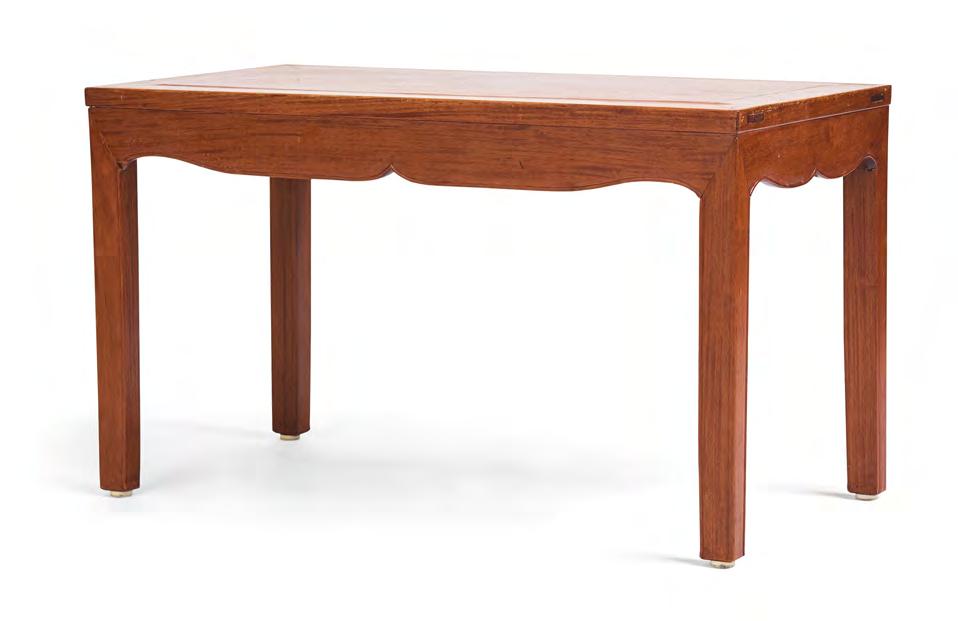

1010. A small huanghuali low table, ‘Kangzhou’, Qing dynasty, 19th century.
The rectangular single planked top is set in a frame above the double moulded apron, above legs with rounded sides joined by humpback stretchers. Measure 32 x 46 x 16 cm.
Provenance: From the collection of Dag Malm (1923–2008).
Thence by descent.
Exhibitions: Compare, Sothebys, lot 43. Important Chinese Art. 11 May 2016, London, England.
Estimate: SEK 12 000 – 15 000 / EUR 1 030 – 1 290
1011. A huanghuali altar table, Qing dynasty, 18th century.
The rectangular top panel set in a frame, on square legs holding the rounded drawer, mounted with a swing handle, all above a straight apron. Height 81 cm. Width 83 cm. Depth 49 cm.
Provenance: From the collection of Dag Malm (1923–2008).
Thence by descent.
Estimate: SEK 30 000 – 50 000 / EUR 2 570 – 4 280


1012. A huanghuali four piece corner leg nesting table, Qing dynasty.
The elegant stand of ‘four-corners flush’, consisting of a single rectangular panelled top set within a thick rectangular frame, above curved aprons supported on thick legs of square section. Measure each: the largest 40.5 x 40.5 x 68 cm; the next in size 33.x33.5 x 48 cm; the next in size 27 x 27 x 49 cm; the smallest one 21.5 x 29 cm.
Provenance: From the collection of Dag Malm (1923–2008). Thence by descent.
Estimate: SEK 20 000 – 25 000 / EUR 1 720 – 2 140
1013. A pair of huanghuali jardiniere stands, Qing dynasty.
A square single top panel set in a frame, above a waisted apron with a lotus flower to each side above square section legs connected with humpback stretchers.
Measure 34.5 x 34.5 x 80.5 cm.
Provenance: From the collection of Dag Malm (1923–2008). Thence by descent.
Estimate: SEK 20 000 – 30 000 / EUR 1 720 – 2 570


1014. A pair of huanghuali cabinets, Qing dynasty.
Of rectangular shape with a single top slate, framed and with a raised edge. Two drawers above two doors. Lower apron decorated with a lotus to the center. Length 71 cm. Depth 46 cm. Height 54 cm.
Provenance: From the collection of Dag Malm (1923–2008). Thence by descent.
Catalogue note: Most possibly the base section of a tall cabinet in two sections.
Estimate: SEK 35 000 – 40 000 / EUR 3 000 – 3 430

1016. Two leather clad and lacquered chests, late Qing dynasty.
Measure the one in red 50.5 x 14 x 14 cm.
Measure the one in brown 52 x 14.5 x 14.5 cm.
Provenance: From the collection of Dag Malm (1923–2008). Thence by descent.
Estimate: SEK 4 000 – 6 000 / EUR 350 – 520
1015. A set of two gilt decorated leather clad wooden chests, late Qing dynasty.
The larger one with painted decoration depicting figure scenes and with floral patterns. Label to the interior. Measure 43 x 21.5 x 25.5 cm. The smaller one decorated with bats, and shou characters. Measure 34 x 18 x 9.5 cm.
Provenance: From the collection of Dag Malm (1923–2008).
Thence by descent.
Estimate: SEK 3 000 – 3 500 / EUR 260 – 300


1017. A watercolour by anonymous artist, late Qing dynasty.
Chrysanthemum. Measurement motif 19.5 x 24 cm.
Measurement with glass and passepartout 30 x 36 cm.
Provenance: From the collection of Dag Malm (1923–2008).
Thence by descent.
Estimate: SEK 2 500 – 3 000 / EUR 220 – 260
1018. A Chinese painting after Ai Qimeng, ink and colour on paper, late Qing dynasty/early 20th century. Flowers. Measure motif 36 x 66 cm. Measure with frame 48 x 112 cm.
Provenance: From the collection of Dag Malm (1923–2008).
Thence by descent.
Estimate: SEK 15 000 – 20 000 / EUR 1 290 – 1 720

1020. A bolt of creme coloured silk fabric, a framed textile and two embroidered silk panels, Qing dynasty. Measure creme coloured silk fragment 63 x 280 cm. Measure framed textile 56 x 87 cm. Measure embroidered silk panels 46 x 7.5 cm. Measure with passepartout 52 x 15 cm.
Provenance: From the collection of Dag Malm (1923–2008).
Thence by descent.
Estimate: SEK 2 500 – 3 000 / EUR 220 – 260

One of 10 ink rubbings in this lot. To see more, please see the online catalogue.
1019. A collection of Chinese ink rubbings, 20th century. (10).
Comprising: one depicting two men kneeling before a gentleman with two attendants below two birds, measure 67x69 cm; one depicting acrobats above swords, measure 92x69 cm; two sheets depicting an archer, measure 66x69 cm; one depicting a swordsman on horseback, measure 68x67 cm; a large rubbing with a horse, measure 70x134 cm; a rubbing in red with the acrobats above swords, measure 90x69 cm; one in several colours of men driving a chariot, measure 44x68 cm; one with men and a horse, measure 66x70 cm.
Provenance: From the collection of Dag Malm (1923–2008). Thence by descent.
Estimate: SEK 4 000 – 6 000 / EUR 350 – 520

1021. A celadon tripod censer, 16/17th century. Tripod decorated with a wavepattern and celadon glaze. Height 7.5 cm. Diameter 10.5 cm.
Provenance: From the collection of Dag Malm (1923–2008). Thence by descent.
Estimate: SEK 4 000 – 6 000 / EUR 350 – 520
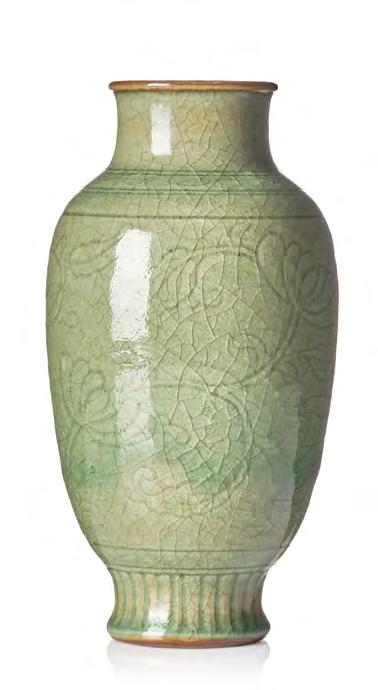

1022. A celadon vase, Ming dynasty (1368–1644). Decorated with flowers. Height 24.5 cm.
Provenance: From the collection of Dag Malm (1923–2008). Thence by descent.
Estimate: SEK 10 000 – 15 000 / EUR 860 – 1 290
1023. A porcelain floor tile, Ming dynasty (1368–1644).
Central motif of a lotus seed capsule, around the center lappets and cloud formations. Measure 23 x 23 x 3.5 cm.
Provenance: From the collection of Dag Malm (1923–2008). Thence by descent.
Exhibitions: Compare floor tiles most possibly from the same floor, in the British Museum, Museum number 1993,1027.1-2.


Harrison-Hall writes in 2001: Stylistically the tiles relate to Islamic motifs found on Chinese pilgrim flasks and ‘lianzi’ [lotus-seed] bowls made in the Xuande era. The concentric pattern of overlapping ovals is repeated on a Xuande mark and period covered cloisonne box in the Pierre Uldry Collection. Part of a tile with the same design, but reversed with white decoration on a blue ground, was excavated at Jingdezhen at Dongyuan, Zhushan, in 1993. Other blue-and-white tiles unearthed there confirm that the present tiles were made at the imperial factory in the Xuande era. It is possible that these unusual tiles belong to a group made to order for a Near Eastern customer. In his memoirs the Mughal emperor Babur (died 1525) refers to Timur’s (1336-1405) grandson Ulugh Beg (1394-1449), who served as governor of the provincial Central Asian capital of Samarkand from 1409 and went on to rule the empire in the last two years of his life and who had a ‘chinikhaneh’ [porcelain room] whose walls were faced with imported Chinese tiles. Local potters made blue-and-white tiles in poorer-quality materials in Egypt, Turkey Lebanon and Syria during the first half of the fifteenth century (for an example in the British Museum see BM 1978.0419.1).
Literature: Harrison-Hall 2001 / Catalogue of Late Yuan and Ming Ceramics in the British Museum (4:39, 4:40) Porter 1995 / Islamic Tiles (fig.84) Clunas et al 2016 / Ming China: Courts and Contacts 1400–1450 (p.184).
Estimate: SEK 12 000 – 15 000 / EUR 1 030 – 1 290
Two tiles in the collection of the British Museum.
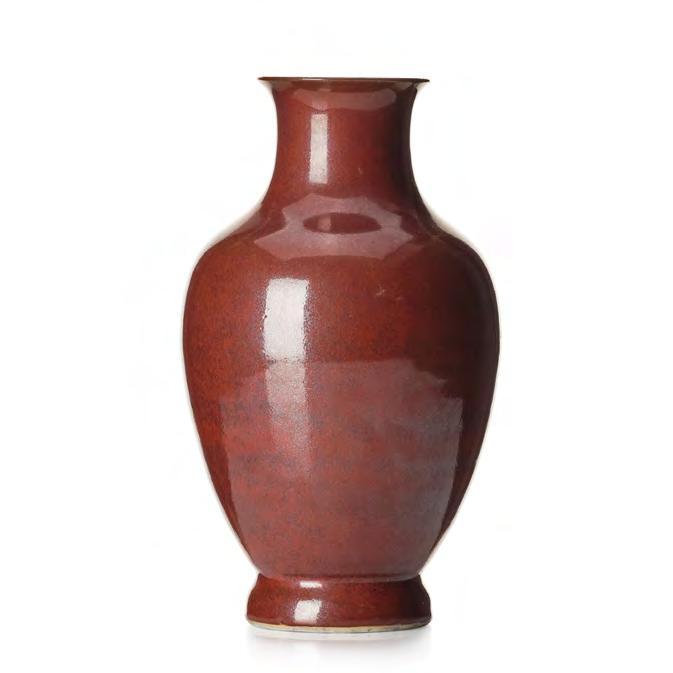
1024. A red glazed vase, Qing dynasty, 19th century. Of baluster shape with a waisted neck and flared rim, decorated in a steely red colour. Height 27.5 cm.
Provenance: From the collection of Dag Malm (1923–2008). Thence by descent.
Estimate: SEK 5 000 – 7 000 / EUR 430 – 600
1025. A large ge glazed vase, Qing dynasty, 19th century. Of baluster shape with qilinshaped handles and ge glaze. Height 38.5 cm. Height with metal mount for lamp shade and wooden base 74 cm.
Provenance: From the collection of Dag Malm (1923–2008). Thence by descent.
Estimate: SEK 6 000 – 8 000 / EUR 520 – 690


1026. A pair of ge glazed vases made in to table lamps, Qing dynasty.
Baluster shape with ring handles and ge glaze. Height 23 cm.
Height with metal mount for lamp shade and wooden stand 47.5 cm.
Provenance: From the collection of Dag Malm (1923–2008). Thence by descent.
Estimate: SEK 4 000 – 6 000 / EUR 350 – 520

1028. A pair of Chinese glass and metal lanterns, second half of the 20th century.
Red painted metal frame with glass. Measure 50 x 17 x 17 cm.
Provenance: From the collection of Dag Malm (1923–2008).
Thence by descent.
Estimate: SEK 2 500 – 3 000 / EUR 220 – 260
1027. A pair of enamel on copper coasters, Qing dynasty, circa 1800.
Of square shape with everted corners, decorated with a scene with two gentlemen sitting in the shade of a tree.
Measure 9.5 x 9.5 cm.
Provenance: From the collection of Dag Malm (1923–2008).
Thence by descent.
Estimate: SEK 2 500 – 3 000 / EUR 220 – 260

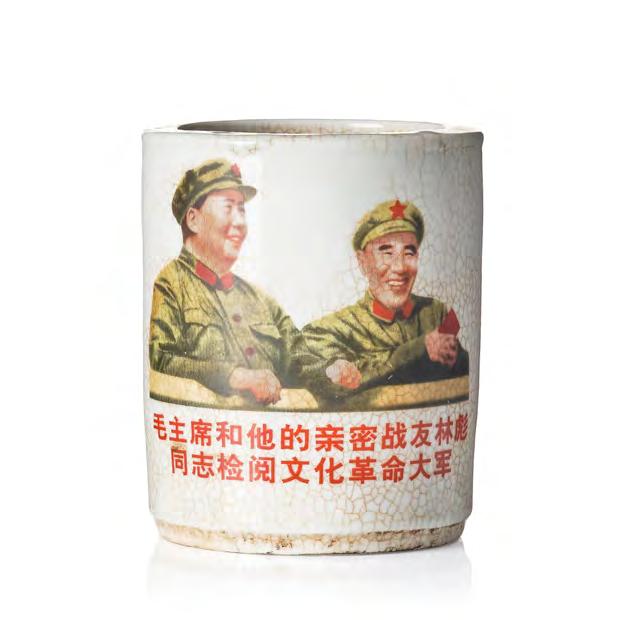
1029. A Chinese brush pot, dated 1968.
Round with printed decoration depicting Chaiman Mao and a Lin Biao holding the book. The reverse with calligraphy.
Height 12.5 cm. Diameter 10.5 cm.
Provenance: From the collection of Dag Malm (1923–2008).
Thence by descent.
Estimate: SEK 2 500 – 3 000 / EUR 220 – 260
Property of a private Swedish Collector.
LOT 1030 – 1034
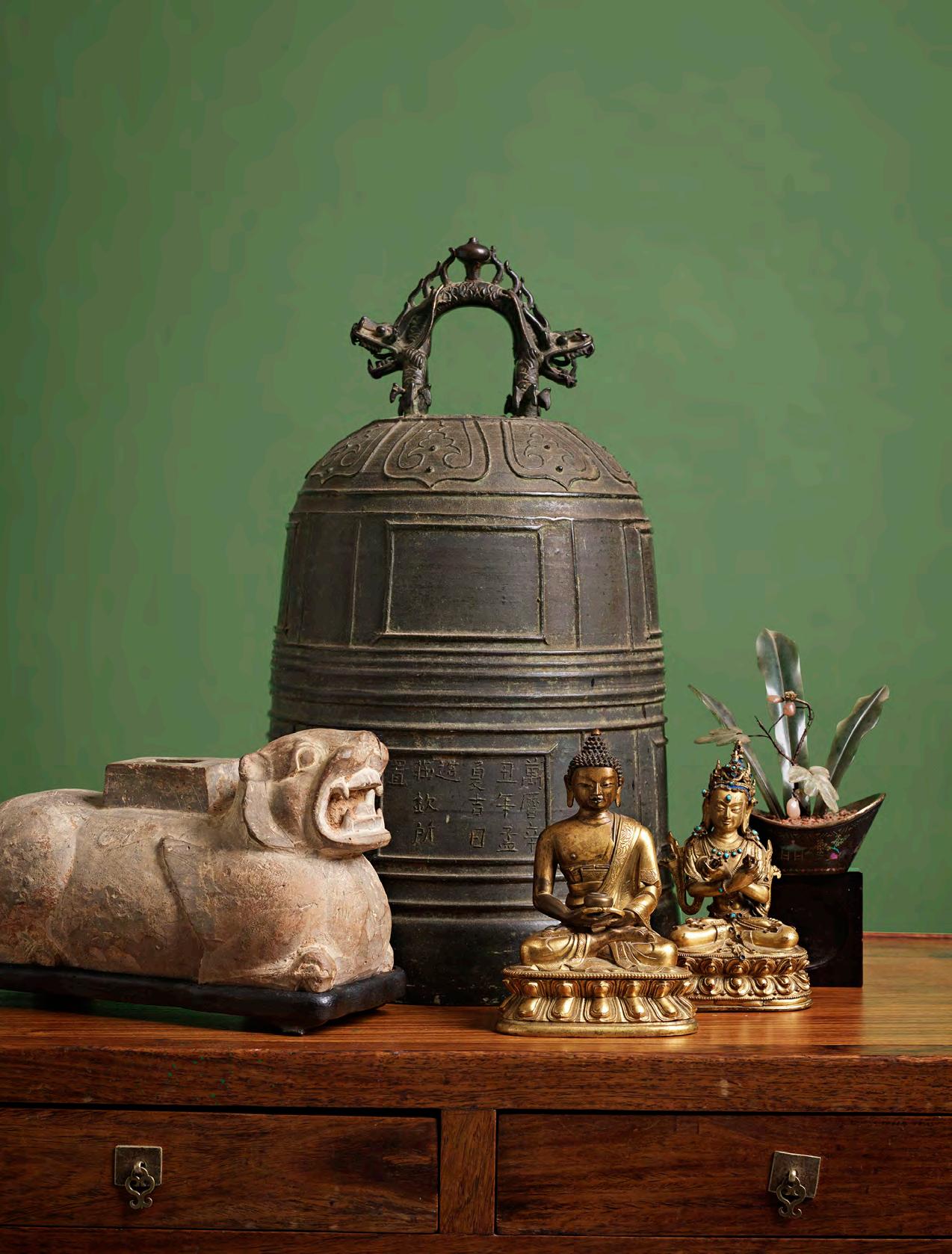
1030. A gilt-bronze figure of Vajradhara Tibet, circa 16th century.
Cast seated cross-legged in dhyanasana on a high double-lotus pedestal, the deity cast with a serene facial expression beneath an elaborate five-leaf foliate tiara enclosing the high chignon, lavishly attired with dhoti and beaded jewellery inset with turquoise, the hands raised holding a vajra and a bell. Height 14.8 cm.
Provenance: Property of a private Swedish Collector, purchased in London in the 1960’s. Ex: Sven Hedin Collection. Aquired in Peking 1930–01–22. Inventory no 1935.50.0426.
Exhibitions: Compare Sothebys, Indian, Himalayan & Southeast Asian Works Of Art, 22 March 2018, New York, lot 1028. Compare, Bonhams, Fine Chinese Art, 11 May 2017. London, New Bond Street, lot 104.
Estimate: SEK 60 000 – 80 000 / EUR 5 140 – 6 850


1031. A gilt-bronze figure of Amitabha Buddha, Tibet, 17/18th century.
Powerfully modelled cast seated in dhyanasana a top double lotus throne with the hands held in dhyana mudra holding an alms bowl, wearing a diaphanous robe falling in neat folds on the base, the face with a serene expression, flanked by a pair of long pendulous ears below tightly curled hair covering the domed ushnisha. The robe elegantly decorated around the edges. Height 16 cm.
Provenance: Property of a private Swedish Collector, purchased in London in the 1960’s.
Catalogue note: Amitabha Buddha is a celestial Buddha according to the traditions of Mahayana Buddhism, and in East Asia as the principle Buddha in Pure Land Buddhism, a major Mahayana subdivision. Pure Land advances an array of heavenly realms and teaches methods by which one may be reborn in one of these paradises. The cult of Amitabha in China can be traced back to at least 2nd century CE, when the Sukhavativyuha Sutra was first translated into Chinese. In Vajrayana Buddhism, Amitabha is considered one of the Five Dhyani Buddhas who is associated with the western direction.
Estimate: SEK 60 000 – 80 000 / EUR 5 140 – 6 850

1033. A Chinese miniature ‘hard stone’ flower arrangement in a ingot shaped lac burgauté pot, Qing dynasty, 18th century.
The flower pot ingot shaped made in the lac burgauté technique with inlays depicting a figure scene in a garden with a pavilion, with a flower arrangement in hardstones. Height 14 cm. Length pot 10 cm.
Provenance: Property of a private Swedish Collector, purchased in London in the 1960’s.
Estimate: SEK 4 000 – 6 000 / EUR 350 – 520

1032. A large inscribed bronze temple bell, Ming dynasty (1368–1644).
With inscription that can be translated to ‘Made during the first month of the summer of the Xinchou year, Wangli period; installed by Zhuang Qin’. The date is corresponding to the year of 1601. The tall, domed body broadening at the rim, surmounted by a double-headed beast-form finial for suspension, the sides cast in high relief with a lappet band. One section bearing the inscription. Height 45.5 cm.
Provenance: Property of a private Swedish Collector, purchased in London in the 1960’s.
Exhibitions: Compare with a bell sold at Bonhams, Fine Asian Works of Art, 21 Jun 2006, San Francisco. Lot 3198. Compare also with a bronze bell in the British Museum, museum number 1989,0525.1.
Estimate: SEK 20 000 – 30 000 / EUR 1 720 – 2 570

1034. A pottery model of a recumant tiger/chimera, Han dynasty (206 BC-220 AD).
The head of the animal slightly raised in a fierce expression created by its bulbous eyes, open mouth showing its fangs, the front legs curled up, probably had a separately potted object resting on its back, now showing the plinth. Wooden stand. Length 27 cm. Height with wooden stand 16 cm.
Provenance: Property of a private Swedish Collector. Ex, Collection of Dr. N Wessen, Stockholm, Sweden.
Exhibitions: Exhibited in Copenhagen in 1950. Label from the ‘Kinas Kunst i Svensk og Dansk eje, det danske Kunstindustrimuseum, Kobenhamn’, 1950. Lot no 232.
Estimate: SEK 15 000 – 20 000 / EUR 1 290 – 1 720

The Carl Kempe Collection
Bukowskis is privileged to offer a selection of Chinese gold, silver, and gilt-bronze works of art, dating from the Six Dynasties to the Ming Dynasty, from the collection of the eminent collector, Carl Kempe (1884-1967) and offered by his family.
The Swedish industrialist Carl Kempe was a leading figure of the Swedish pulp and paper industry, as well as an a ccomplished tennis player who won a silver medal at the 1912 Summer Olympics in Stockholm. Today he is better known internationally as a famed collector of Chinese antiquities.
Carl Kempe’s interest in Chinese art began in the early 1920s. He belonged to a group of Chinese art connoisseurs who began collecting in the early 20th century; he was also a member of the China Committee, created by HRH Gustav Adolf, later HRH King Gustav VI Adolf of Sweden, Torsten Laurin, Johan Gunnar Andersson, Axel Carlander and Axel Lagrelius amongst others to acquire art from China. The China Committee later transformed into the China Club in Stockholm (a local branch of the Oriental Ceramic Society in London).
1035 – 1047
LOT
Delving into Carl Kempe’s inventories from the 1920’s and onwards one can see that he acquired items from Paris dealers such as C. T. Loo, Monsieur N. Knudsen and Monsieur L. Michon, and from London dealer Bluett & Sons, S ydney L. Moss, Yamanaka & Co., John Sparks, Mr Peter Boode, Mr Norton, K. Shimuzu, Spink & Son, Beijing dealers Wang Chia Yu and Cang I Chen, from Shanghai E. T. Chow, and from Stockholm dealers Hans Öström, C. E. Gadelius, Orvar Karlbeck, and the Karlbeck Consortium. Following his initial interest in Chinese art in the 1920s, Carl Kempe and his wife travelled to China in 1935-1936, were he met up with the other famed Swedes out there such as Johan Gunnar Andersson, whose expeditions, and excavations he sponsored. In China it has been reported that he purchased some 250 items of Chinese art.
K empe had been attracted to Qing dynasty polychrome porcelains initially, but he later developed a particular interest in white-glazed ceramics – especially those from the Tang-Song period.
The other area in which he developed a great interest in and subsequently formed a spectacular collection, was Chinese gold and silver, which ranged from the Bronze Age Zhou dynasty to the Qing dynasty.
His third area of specialised collecting was Chinese glass, that he bequeathed to the Östasitiska Museet in Stockholm, although he also acquired fine examples of Chinese l acquer, enamels, bronzes, and other items, as well expanding his interests to Roman, Egyptian, Islamic and E truscan glass, and gold.




He also loaned pieces from the collection to several intern ational exhibitions, for example, to the ‘Ausstellung der Vereinigung der Freunde Ostasiatischer Kunst, Köln, 1926, the famous 1935-36 International Exhibition of Chinese Art in London (see listing on page xxxi index of lenders). His good friend J. G. Andersson gave a lecture at the Royal Society, Burlington House, December 5th, 5 P.M. ”The Goldsmith in Ancient China”. The Arts de la Chine Ancienne, Musee de L’Orangerie, Paris, 1937. After this exhibition he seems to have purchased some gold items that was on loan by Madame de Wannieck, Paris. He also lends a good number of items to the exhibition in Copenhagen ‘Kinas Kunst i Svensk og Dansk eje, det danske Kunstindustrimuseum, Kobenhamn’, 1950.
As an enthusiastic, academic collector (he described himself as a manic collector), Kempe welcomed scholars and collectors from all over the world, to view, discuss and research his remarkable collection and collected to end of his days. Kempe sponsored numerous research projects and excavations and was a true patron of the arts and made numerous donations to Östasiatiska Museet in Stockholm.
After his death in 1967 the collection continued to be displayed at his residence at Ekolsund Castle, and in the 1970s h is daughters followed their father’s footsteps and agreed to lend some 150 items of ceramics, gold, and silver from the Kempe collection. So, they were sent on a touring exhibition in the United States in collaboration with The Asia S ociety and the Smithsonian, published by Bo Gyllensvärd, who wrote his PhD on the Collection, in Chinese Gold and Silver and Porcelain - The Kempe Collection, 1971.
In 1997 a large part of the Kempe collection of ceramics, gold and silver was sold to the Museum of Art and Far Eastern Antiquities in Ulricehamn. Some ten years later the collection was sold at auction and part of them were auctioned at a sale entitled Masterpieces of Chinese Precious Metalwork: Early Gold and Silver, held by Sotheby’s London on 14 May 2008.
The objects now on offer have remained with Kempe family – and are now offered for sale by the family.
Ekoslund Castle seen from the air.
Winter excursion at Ekolsund Castle, in the middel Greta Garbo, to the right Carl Kempe.
Interior of Ekolsund Castle.


1035. An elegant gilt bronze sculpture of a tiger, Six dynasties, or earlier.
Well cast in a striding position, slightly arched body raised on four powerful muscular limbs terminating in paws, trailed by a long curling tail, the head with protruding eyes and its sharp fangs revealed. Length 15.5 cm. Height 9 cm. Height with stone base 11.5 cm.
Provenance: Theodore Cultry, Paris. Bluett & Son Ltd, London aquired it from Theodore Cultry, on 16 May 1935 (£95).
O.T. Falk acquired it from the above on 28 September 1935 (£180).
Consigned for sale by O.T. Falk and sold by Bluett & Son Ltd, London to Carl Kempe, 18 May 1938 (£190).
Bukowskis part of the Bonhams Network extends a thank you to Dominic Jellinek, Bluett & Son archives.
From the collection of the eminent collector, Carl Kempe (1884–1967).
Exhibitions: Kinas Kunst i svensk och dansk eje, 391. Udstillning i det Danska Kunstindustrimuseum, København, april 1950. Lot No 102. Listed there as: Provenance, Chuansien, Southern Shensi. Han or slightly later.
From the Collection of Dr Carl Kempe.
Compare other gilt bronze sculptures of animals from the Six dynasties, see for example Sotheby’s a dragon depicted walking in this manner from the collection of Stephen Junkunc, III, 19th March 2019, lot 116.
For another dragon, see Sotheby’s, Junkunc: Arts of Ancient China II /Lot 247. 10 September 2019 • New York.
Estimate: SEK 80 000 – 120 000 / EUR 6 500 – 10 000
Literature: Osvald Siren, ‘Kinas konst under tre årtusenden’, Vol I-II. Stockholm 1942. To be found in the chapter on the Six dynasties and the Sui dynasty. Depicted on Pl 126. Image 3. Listed as from the Collection of C. Kempe, Stockholm.
Royal Academy of Arts, London 1935-36, International Exhibition of Chinese Art. Compare with other gilt bronze animals depicted dated as Six dynasties, see lot no 516 (the dragon is depicted in the same pose, walking), 528 and 500. Also, animals dated as Wei, lot 520. and two Han beasts, see lot no 518 and 527.
Roy Davids & Dominic Jellinek, Provenance, Collectors, Dealers & Scholars: Chinese Ceramics in Britain & America. See page 176, about the Collector Osvald Toynbee (1879-1972).
Catalogue note: Striking for its powerful dynamism and slender elegance, this striding tiger embodies the majesty and virility entirely commensurate with its role in Chinese cosmology.
The Four Symbols are mythological creatures appearing among the Chinese constellations along the ecliptic, and viewed as the guardians of the four cardinal directions. (Read more online).
Photograph taken for Bluetts in 1935. In the Bluetts archive it was described as a “Bronze Puma”.
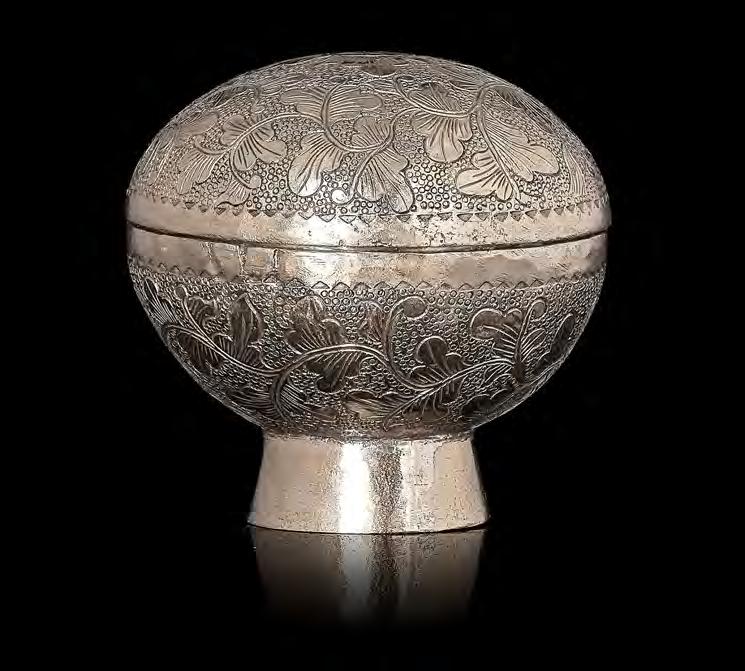
1036. A silver box with cover, Tang dynasty (618–907).
Doomed cover on a rounded bowl that rests on a high foot-rim. Decorated with an intricate foliate scroll all against a ringmatted ground. Diameter 5.3 cm. Weight 54.5 gram.
Provenance: From the collection of the eminent collector, Carl Kempe (1884–1967).
Estimate: SEK 15 000 – 20 000 / EUR 1 290 – 1 720

1037. Two circular silver boxes with covers, Tang dynasty (618–906).
Doomed cover, in beaten silver, deep bowl that rests on a high foot rim, decorated with a continuous floral scroll all against a ring-matted ground. Diameter 6 cm. Weight 119.7 grams.
Provenance: From the collection of the eminent collector, Carl Kempe (1884–1967).
Estimate: SEK 30 000 – 50 000 / EUR 2 570 – 4 280
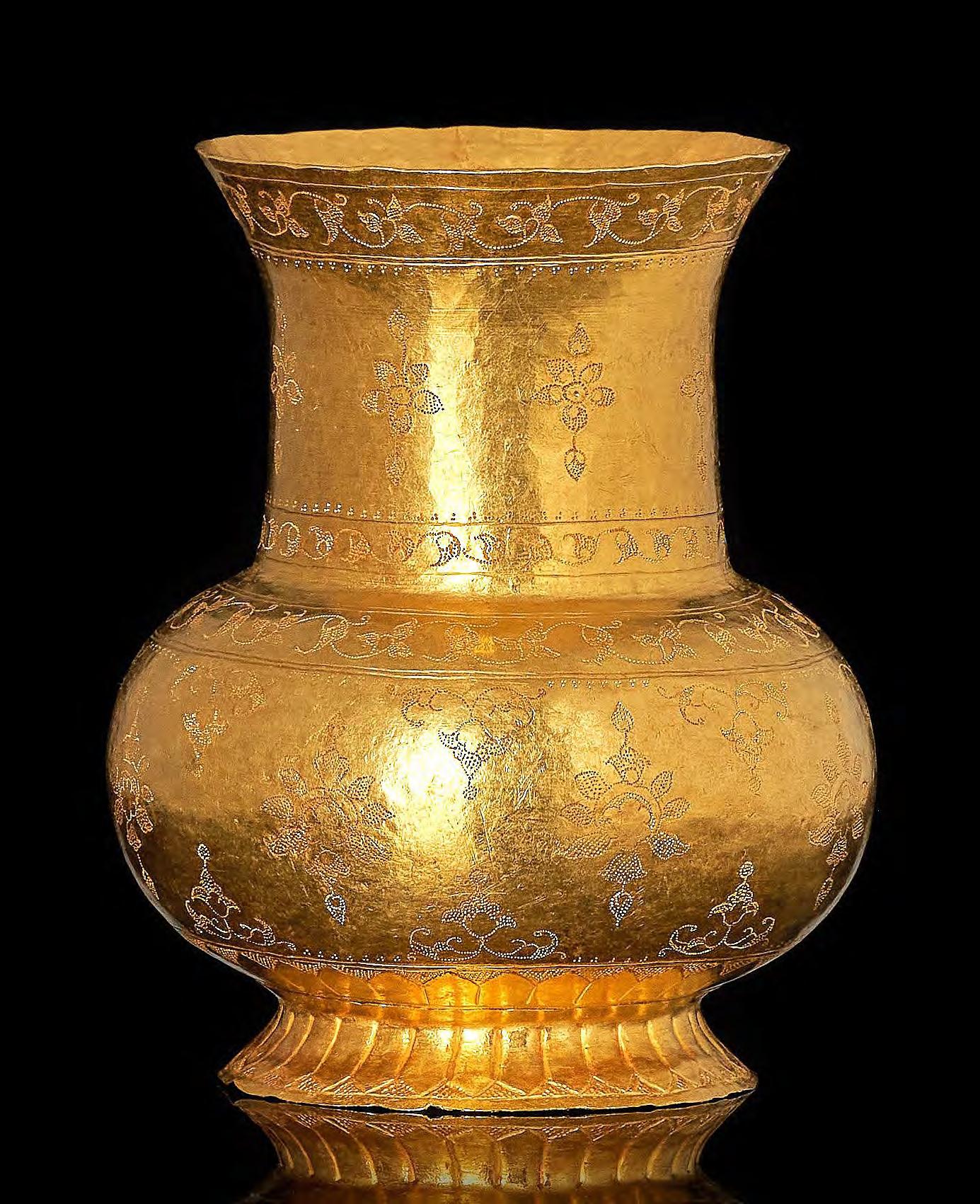
1038. A rare gold vase, China or Central Asia, 12th-14th century.
The slightly compressed globular body is standing on a splayed foot, tall neck with flared rim. The outside is decorated with bands of floral scroll by the rim and the shoulder and in between further continuous flowers. Height 9.5 cm. Weight 156.2 gram.
Provenance: From the collection of the eminent collector, Carl Kempe (1884–1967).
Exhibitions: Marked with Carl Kempe’s inventory no CK454. Compare another gold vessel from the Carl Kempe Collection sold at Sotheby’s, 14 May 2008, London. Masterpieces of Chinese Precious Metalwork, Early Gold, and Silver; (Read more online).
Literature: Die sammlung Pierre Uldry, Chinese Gold und Silber, Zurich 1994. Compare a Gold vessel with similar decoration, lot 286.
James C. Y. Watt. The World of Khubilai Khan, Chinese Art in the Yuan dynasty. The exhibition focused on works made during the Mongol rule in China, which began with Chinggis Khan’s capture of the capital of the Jin dynasty in 1215 and extended through the Yuan dynasty. Metropolitan Museum, New York, 2010. Compare with a bowl on page 287, figure 329, dated to Xixia dynasty (1038-1127), Inner Mongolia Region Museum. Han Wei, Christian Deidier, Ancient Chinese Gold, Paris 2001. Compare with other gold vessels, depicted on page 205. Liao and Tang dynasty.
Bo Gyllensvärd, ‘T’ang Gold and Silver’, Bulletin of the Museum of Far Eastern Antiquities, Compare no. 29, 1957, figs. 27a, 97r.
Estimate: SEK 300 000 – 500 000 / EUR 25 690 – 42 810

1039. A set of 15 gold hair ornaments, Song dynasty (960–1279).
Flower shaped with two layers of eight petals, with further about 30 stamens around the centre that is inlayed with enamel. Diameter each 3.4 cm. Overall weight circa 123.2 gram.
Provenance: From the collection of the eminent collector, Carl Kempe (1884–1967).
Literature: Emma C. Bunker, Julia M. White & Jenny F. So, Adornment for the Body and Soul, Ancient Chinese Ornaments from the Mengdiexuan Collection, Compare with a pair of earrings of flower design, depicted on page 287. Dated as Song dynasty.
Frances Mc Donald, Edited by Jenny F So, Radiant Legacy; Chinese Gold from the Mengdieuxan Collection, Vol III. Compare a set of flowers for hairpins depicted on page 140-141.
Emma C. Bunker, Julia M. White & Jenny F. So, Adornment for the Body and Soul, Ancient Chinese Ornaments from the Mengdiexuan Collection,
Compare with a pair of earrings of flower design, depicted on page 287. Dated as Song dynasty.
Frances Mc Donald, Edited by Jenny F So, Radiant Legacy; Chinese Gold from the Mengdieuxan Collection, Vol III. Compare a set of flowers for hairpins depicted on page 140-141.
Julia M. White, Emma C. Bunker and Chen Peifen, Adornment for Eternity, Status and Rank in Chinese Ornament, compare a mounted set of flowers like this depicted on page 176. The texts tell us that hairpins with round flowers like this but in silver from the Han period excavated.
Estimate: SEK 120 000 – 150 000 / EUR 10 280 – 12 850

1041. A set of eight gold ‘Garuda’ belt plaques, Yuan/early Ming dynasty.
Reflecting the influence of Tibetan Buddhist art, the belt ornaments depicts Garudas (mythical birds).
Comprising: one, measure 4.8 x 4 cm (Carl Kempe inventory no 5 written in black); one measure 4.8 x 4 cm; one measure 4 x 4 with a 7.5 cm long gold chain with a pin (length pin 4 cm); two with a ring fastened to their sides, measure 4 x 4 cm; three small gold belt details, measure 4 x 1,2 cm. Overall weight 158.3 grams.
Provenance: From the collection of the eminent collector, Carl Kempe (1884–1967).
Exhibitions: Compare; Julia M. White and Emma C Bunker, Chien Peifen, Adornment for Eternity, Status and Rank in Chinese Ornament. Compare with earlier belt sets depicted in the exhibition catalogue.
Literature: James C. Y. Watt, The World of Khubilai Khan, Chinese Art in the Yuan Dynasty. Metropolitan Museum, 2010. See page 298. A gold hat ornament with Garudas and dancing figures. Found in Wulanchabu city in Inner Mongolia.
Wei Han, Ancient Chinese Gold, Paris, France, 2001. See details of a set of belt buckles on page 141. Belts like this signified the owner’s social status and rank. As discussed in Ancient Chinese gold, by Wei Han, very precise but not always respected regulations limiting the use of certain precious materials to the members of certain social classes were decided by the government of the time. Therefore, the type of material, the number of plaques used made it possible for one to know the status of the wearer.
Estimate: SEK 120 000 – 150 000 / EUR 10 280 – 12 850
1040. A gold hair pin, Song dynasty (960–1279).
The top is shaped as a gourd fruit, made of plated gold sheet, below the fruit there is filigree works, the receptacles in the centre has most probably held precious stones. The pin runs through the fruit and is fastened at the top with a cash ornament. Length 12.5 cm Overall weight 12.6 gram. A special commissioned leather clad case accompanies the piece. Measure 22.5 x 4 x 3 cm.
Provenance: From the collection of the eminent collector, Carl Kempe (1884–1967). Exhibitions: ‘Kinas Kunst i Svensk og Dansk Eje’. Det Danska Kunstindustrimuseum April 1950. The present lot is exhibited here as lot no 177. Provenance: Lo-yang? dated as Song. And in the Carl Kempe Collection. Compare: Earrings from the same collection sold at Sotheby’s, Masterpieces of Chinese Precious Metalwork, Ming and Qing Imperial Gold, Hong Kong, April 11, 2006. Lot no 2324.
Literature: Depicted in Chinese Gold and Silver in the Carl Kempe Collection. A Catalogue by Bo Gyllensvärd, 1953. Page 120-121.
Adornment for the Body and Soul, Ancient Chinese Ornaments from the Mengdiexuan Collection. Emma C Bunker, Julia M White with Jenny F. So, Hong Kong 1999. Compare page 282, earrings of the same design dated as Song dynasty (960-1279).
Estimate: SEK 30 000 – 40 000 / EUR 2 570 – 3 430


1043. A gold hair ornament, Song/Ming dynasty.
Gold plate and filigree work, has originally had pearl or gemstone inlays. Length 10.2 cm. Weight 2.4 grams.
Provenance: From the collection of the eminent collector, Carl Kempe (1884–1967).
Exhibitions: Compare with hair ornaments in the collection of the Metropolitan Museum in New York, Credit Line: Rogers Fund, 1924.
Accession Number: 24.32.5 and 20.38.2. Both these are dated as Tang dynasty. Same kind of goldleaf with filigree work and inlays of pearls.
Literature: Osvald Siren, Kinas Konst under tre årtusenden. Vol I-II.
Compare with the items depicted on Pl 18–19.
Estimate: SEK 8 000 – 10 000 / EUR 690 – 860

1042. A gold ‘turquoise’ inlayed hairpin, Song/Ming dynasty.
Turquoise inlay, elegant, engraved decoration of floral scrolls, to the center of the back a full moon engraved with the legendary ‘yu tu dao yao’ scene of the Moon Rabbit under the cassia tree, with his magic elixir of immortality. Length 17.5 cm. Overall weight 42.1 grams.
Provenance: From the collection of the eminent collector, Carl Kempe (1884–1967).
Literature: J. J. Lally & Co, Silver and Gold in Ancient China. See lot no 24. A chased silver red cliff pictorial dish, Song Dynasty that also has a rull moon engraved with the legendary ‘yu tu dao jao’ scene with the Moon Rabbit.
Estimate: SEK 40 000 – 60 000 / EUR 3 430 – 5 140

1044. A pair of gold earrings. Song dynasty (960–1279).
Each decorated as what appears to be a fruit with a leaf on it, from its lower part loop chains with dangling beads. The back with a pin. Height with dangling beads and pin 6 cm. Overall weight 10.7 grams.
Provenance: From the collection of the eminent collector, Carl Kempe (1884–1967).
Literature: Julia M. White and Emma C Bunker, Chien Peifen, Adornment for Eternity, Status and Rank in Chinese Ornament. Compare with earrings with loop chains and drops on page 131.
Estimate: SEK 20 000 – 30 000 / EUR 1 720 – 2 570

1045. A flower shaped jade plaque, Qing dynasty, 18th century.
Elegantly carved, sculptured as a flower, holes for fastening on a dress or in a piece of jewellery. The other side with swirls and yin/yang at the center. Diameter 8 cm.
Provenance: From the collection of the eminent collector, Carl Kempe (1884–1967).
Exhibitions: Compare jade flowers at the British Museum, Museum number 2022,3034.218.
Literature: Rawson 1995 / Chinese Jade from the Neolithic to the Qing (cat.no.25.16) Similar flowers have been discussed by Cheng Te-k’un in his study of jade flowers. On the basis of an unpublished comparison with a jade said to come from a Jin dynasty tomb in south-west Shaanxi, these substantial examples are generally given a fairly early date. The evidence has been accepted by James Watt. See Rawson 1995, p.339, cat.no.25.16.
Estimate: SEK 8 000 – 10 000 / EUR 690 – 860
1046. Three gold-inlaid and gem-set jade pendants, India, 19th century.
Bound together by metal thread. Each of cusped form with suspension piece at top, the gold-inlaid decoration with a floral spray inlaid with a diamond and foiled gem stones. Measure each 5 x 3.6 cm and the two smaller ones 3 x 2.5 cm.
Provenance: From the collection of the eminent collector, Carl Kempe (1884–1967).
Exhibitions: Compare; Christies, 8652 The Saeed Motamed Collection, Part I. Lot 320. Compare also, Christies, 4387 Arts of India, lot 165.
Catalogue note: See image of Carl Kempe at Ekolsund Castle, were the necklace can be seen in the display cabinet.
Estimate: SEK 20 000 – 30 000 / EUR 1 720 – 2 570

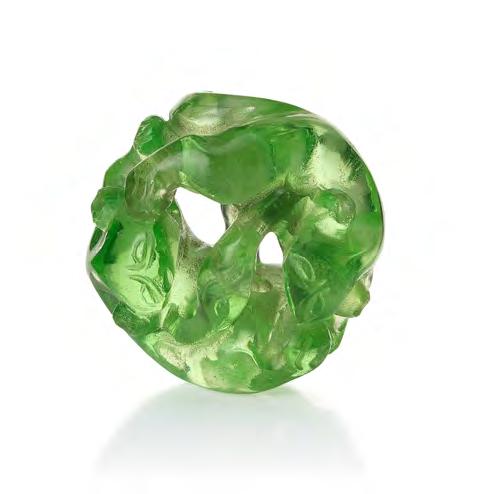
1047. A green sculptured bead, Qing dynasty.
Sculptured in the shape of two wrestling beasts. Diameter 3 cm.
Provenance: From the collection of the eminent collector, Carl Kempe (1884–1967).
Estimate: SEK 3 000 – 3 500 / EUR 260 – 300
The collection of Axel Lagrelius
From the Collection of Axel Lagrelius (1863-1944). Thence by descent within the family. Axel was a Swedish chemical engineer, business leader and art collector.
Lagrelius sponsored several scientific expeditions, such as Alfred Nathorst to Spitsbergen in 1898, Greenland 1899, and Otto Nordenskjold expedition to the South Pole 1902-1904, continuously Johan Gunnar Anderssons Expeditions in China from 1916, onwards. He held several honorary titles and was from 1907 In 1907 appointed superintendent of the court.
In 1926 he accompanied H. R. H. the Crown Prince of Sweden on his journey to China, where he got the honorary title of a mandarin of the court. He was one of the founding members of the China Committee and one of the investors in the Karlbeck syndicate that purchased Chinese Works of Art in China through Orvar Karlbeck 1928-1932.
LOT 1048 – 1058

 The black and white image taken when Lagrelius visited China with the Crown Prince in 1926. From the top left, no 1 O. Nordqvist, 2, 3, 4 Erik Nyström, 5, 6, 7. From the lower left, no 3 Mr Everlöf, no 4. Crown Princess Louise Mountbatten, no 5. H.R.H. Crown
Prins Gustav Adolf (later King Gustav VI Adolf), no 6 Mrs Rudebäck, no 7 Mr Rudebäck, no 8 Axel Lagrelius, 9 Johan Gunnar Andersson.
The black and white image taken when Lagrelius visited China with the Crown Prince in 1926. From the top left, no 1 O. Nordqvist, 2, 3, 4 Erik Nyström, 5, 6, 7. From the lower left, no 3 Mr Everlöf, no 4. Crown Princess Louise Mountbatten, no 5. H.R.H. Crown
Prins Gustav Adolf (later King Gustav VI Adolf), no 6 Mrs Rudebäck, no 7 Mr Rudebäck, no 8 Axel Lagrelius, 9 Johan Gunnar Andersson.
1048. Two bronze mirrors, Han dynasty (206 BC-220 AD).
The first mirror in the so called TLV group with a central square surrounding the nob for the string. Diameter 15.9 cm. Silvered. With a fitted box clad in blue. Measure 19.5 x 19.5 cm. The second mirror round with a small central nob. Diameter 14.5 cm. With fitted box with blue lining. Silvered. Measure 19 x 19 cm.
Provenance: From the Collection of Axel Lagrelius (1863–1944).
Thence by descent within the family.
Literature: Karlbeck Konsortiet, 1930–31. Compare with another mirror like this that he aquired, listed as lot no 222.
Estimate: SEK 8 000 – 10 000 / EUR 690 – 860



1049. A sculptured pottery figure of a foreigner, Wei/Sui dynasty.
Standing trades man painted in red and white pigment. Height 30 cm.
Provenance: From the Collection of Axel Lagrelius (1863–1944). Thence by descent within the family.
Estimate: SEK 5 000 – 7 000 / EUR 430 – 600
1050. A Chinese enamel on copper tray, Qing dynasty, 18th century.
Of rectangular shape, decorated with immortals in a landscape setting. Seal in red. Measure 28 x 19.5 cm.
Provenance: From the Collection of Axel Lagrelius (1863–1944).
Thence by descent within the family.
Estimate: SEK 4 000 – 6 000 / EUR 350 – 520

1051. A set of three copper on enamel coasters, Qing dynasty, 18th century.

Of square shape with everted rims, decorated with a figure scene with scholars in a landscape setting, with calligraphy and seals in red. Measure 9.5 x 9.5 cm.
Provenance: From the Collection of Axel Lagrelius (1863–1944). Thence by descent within the family.
Estimate: SEK 4 000 – 6 000 / EUR 350 – 520


1052. A blue and white ‘five clawed dragon’ cup, Qing dynasty, with Yongzheng mark and of the period (1723–35).
Rounded sides on a short foot, decorated to the interior with a five clawed dragon amidst cloud formations within a double circle, the sides decorated with two fierce five clawed dragons chasing the flaming pearl, the base with a six character mark in underglaze blue. Diameter 9.5 cm.
Provenance: From the Collection of Axel Lagrelius (1863–1944). Thence by descent within the family.
Estimate: SEK 40 000 – 60 000 / EUR 3 430 – 5 140
1053. A well carved zitan and jade box, Qing dynasty, 18th century.
Round with a recessed decoration in tortoise. The cover with a jade plaque with a dragon amidst cloud formations. Diameter 12 cm.
Provenance: From the Collection of Axel Lagrelius (1863–1944).
Thence by descent within the family.
Estimate: SEK 40 000 – 60 000 / EUR 3 430 – 5 140
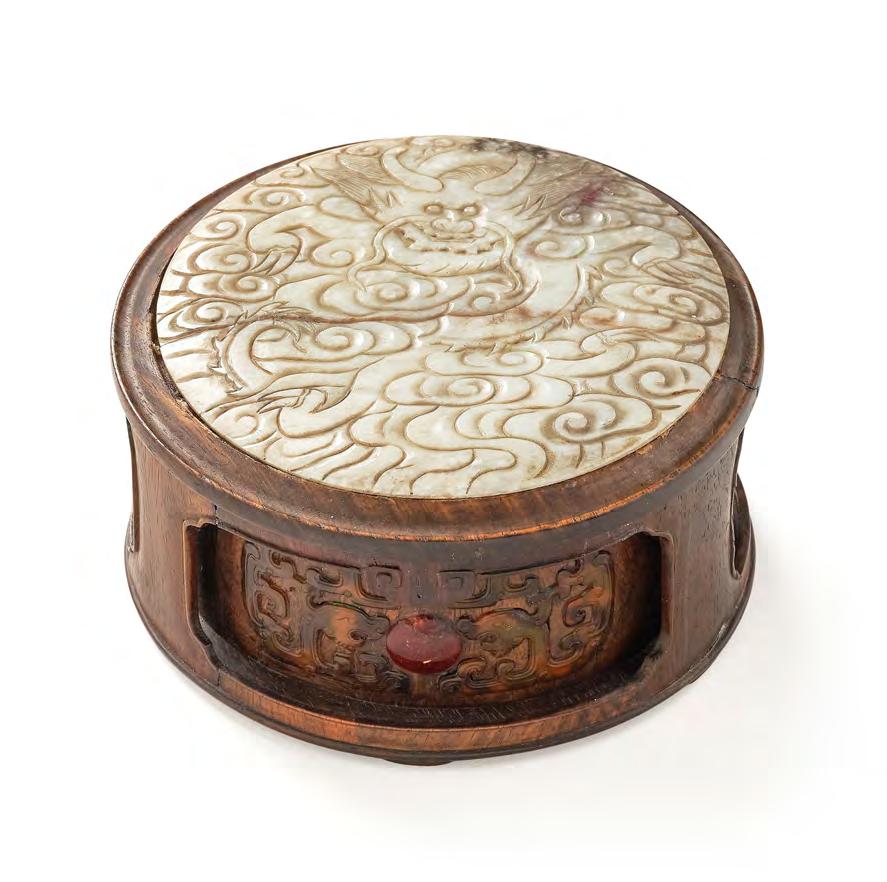

1055. A mandarin’s single-eyed peacock feather plume in a covered case, Qing dynasty, 19th century.
The tube shaped leather clad box is painted with bats to bring luck. Length box 40 cm. Length plume 33.5 cm.
Provenance: From the Collection of Axel Lagrelius (1863–1944).
Thence by descent within the family.
Catalogue note: The single-eyed peacock plume, dan yan hua ling, was awarded to officials of the first six ranks.
Estimate: SEK 4 000 – 6 000 / EUR 350 – 520
1054. An embroidered dragon roundel from the surcoat of an Emperor or Imperial son, Qing dynasty, 18th century.
Embroidered in satin stitch and fine couched gold thread with a front facing imperial dragon, the sinuous body cocued in fine gold thread against a dark blue ground, surrounded by bats and chasing the flaming pearl amidst cloud formations. Diameter 32.5 cm.
Provenance: From the Collection of Axel Lagrelius (1863–1944).
Thence by descent within the family.
Catalogue note: Roundels like these would have been made for an emperor or worn by one of his sons and would have been placed on the left shoulder of the robe.
Estimate: SEK 10 000 – 15 000 / EUR 860 – 1 290



1057. A set of Chinese pewter tea caddies in a container, Qing dynasty, 19th century.
Lobed shape, the outer box contains a set of six tea caddies with covers. Height 13 cm. Diameter 14 cm.
Provenance: From the Collection of Axel Lagrelius (1863–1944).
Thence by descent within the family.
Estimate: SEK 6 000 – 8 000 / EUR 520 – 690
1058. A pair of scroll paintings, signed Zhang Zhiwan (1811–1897).
With calligraphy, and seal in red. Figure scenes. Measure motif 29 x 122 cm. Measure hanging 34 x 140 cm.
Provenance: From the Collection of Axel Lagrelius (1863–1944). Thence by descent within the family.
Estimate: SEK 10 000 – 15 000 / EUR 860 – 1 290
1056. A lacquered case with a set of 9 ink cakes, late Qing dynasty.
A rectangular box with a full front five clawed dragon amidst cloud formations, clad to the interior with a yellow silk lining. Measure 12 x 21 cm. The ink stones decorated in relief with mountain landscapes and with gilded lettering.
Provenance: From the Collection of Axel Lagrelius (1863–1944). Thence by descent within the family.
Exhibitions: Compare with an imperial inscribed inkcake sold at Christies, The Imperial Sale, Fine Chinese Ceramics and Works of Art, Monday 26 April 2004, lot no 921. With the same kind of fitted lacquer box with toe confrotted dragons. Compare also with a set like this in the Palace Museum in Taipei,
Estimate: SEK 4 000 – 6 000 / EUR 350 – 520



The collection of G. Held
To see other items sold from this collection see Bukowskis Auction Sale 565 (2011–12–06) and Bukowskis Auction Sale 562 (2011–06–14).
LOT 1059 – 1066
1059. An archaistic bronze ritual tripod vessel and cover ‘Ding’, Song/Ming dynasty.
The deep rounded sides cast with a single band as a decoration below two loop handles, all supported on three waisted legs with hoof feet, the low-domed cover with three evenly-spaced recumbent beasts. Length 27.5 cm. Height 23 cm.
Provenance: From the collection of G. Held, thence by descent.
Estimate: SEK 30 000 – 50 000 / EUR 2 570 – 4 280

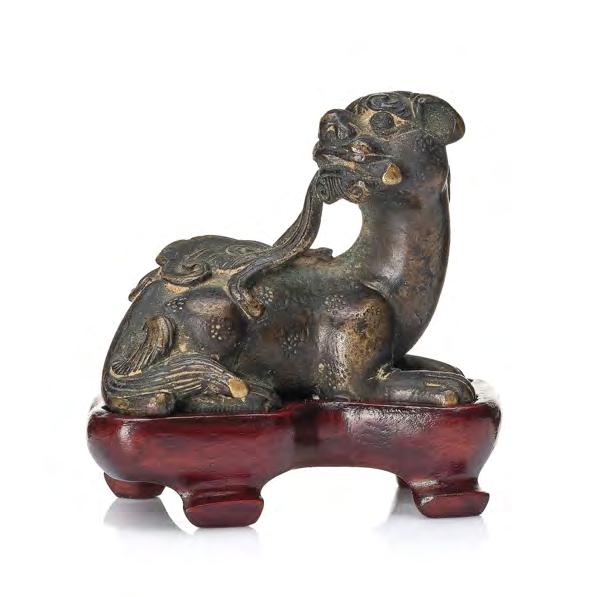
1060. A bronze figure of a reclining beast, late Ming dynasty/early Qing dynasty.
Reclining beast with a lingzhi in its mouth. Length 5.5 cm.
Provenance: From the Collection of G. Held, thence by descent.
Estimate: SEK 4 000 – 6 000 / EUR 350 – 520
1061. A celadon tripod brush-washer/censer, late Ming dynasty.
Wide body that rests on three legs, handles to the shoulder, celadon glaze. Length 11 cm. Height 6.5 cm.
Provenance: From the Collection of G. Held, thence by descent. According to the collectors private notes, purchased in Schweiz in 1986.
Estimate: SEK 8 000 – 10 000 / EUR 690 – 860


1062. A blue and white Transition four clawed dragon incense burner, 17th century.
Rounded sides with a waisted part and a flared rim, decorated in a vibrant underglaze blue with two fierce four clawed dragons chasing the flaming pearl amidst cloud formations. Diameter 22.5 cm. Height 14 cm.
Provenance: From the Collection of G. Held, thence by descent.
Estimate: SEK 20 000 – 25 000 / EUR 1 720 – 2 140

1063. A ‘four clawed dragon’ snuff bottle, Qing dynasty with seal mark in red.
Round shape, decorated in famille rose colours against a lime green ground with a fierce four clawed dragon chasing the flaming pearl amidst cloud formations. Height with cover 7.2 cm.
Provenance: From the Collection of G. Held, thence by descent
Estimate: SEK 8 000 – 10 000 / EUR 690 – 860

1065. A Chinese jade snuff bottle with stopper, 20th century.
Well shaped with a rounded shoulder. Height with cover 5.5 cm.
Provenance: From the Collection of G. Held, thence by descent.
Purchased from Robert Kleiner, London 1998
Estimate: SEK 6 000 – 8 000 / EUR 520 – 690

1064. A group of five Chinese snuff bottles with covers, Qing dynasty and later.
Comprising: a snuff bottle in porcelain, height 8.5 cm; a snuffbottle in moss agathe decorated in relief, height 6.2 cm; three snuffbottles in stone, height 5–6.2 cm.
Provenance: From the Collection of G. Held, thence by descent.
Estimate: SEK 8 000 – 10 000 / EUR 690 – 860

1066. A group of three fan paintings, Qing dynasty. The round one is decorated in ink on silk with bamboo, presumably by Liang Xinnong. Laid on paper. Measure 26 x 25 cm. Measure on paper 36 x 29.5 cm. The one with flowers, is painted on paper, laid on paper. To artist seals in red. Sakeda Jiewen (1767–1827). Unsigned. Length motif 51.5 cm. Measure silk lined paper 61 x 32 cm. The figural one, ink and colour on paper. Seal in red ‘Chuntang’, (Spring Hall) and signed Chaodi. Length motif 49 cm. Measure paper 58 x 36 cm.
Provenance: From the Collection of G. Held, thence by descent.
Estimate: SEK 8 000 – 10 000 / EUR 690 – 860
The collection of Helge von Knorring
From the collection of Helge von Knorring (1897-1985), thence by descent within the family. Helge von Knorring was a Finnish diplomat who had a long career within the ministry of Foreign Affairs. He first comes out as a young attaché to Japan in the late 1920’s. then comes to Shanghai as the Charge d ’Affaires 1929-1932. Then he returns as an attaché in Tokyo again. The service continues with a lot of posts around the world, he was the Chargé d’Affaires in Pretoria 1949-1952, Abassador to Beijing 1952-1953, Ambassador to Bern 1953-1956.
LOT 1067 – 1075


1067. A celadon glazed dish, Ming dynasty (1368–1644).
Decorated in relief, celadon green glaze. Diameter 33 cm. Height 7.5 cm.
Provenance: From the collection of Helge von Knorring (1897–1985), thence by descent within the family.
Estimate: SEK 15 000 – 20 000 / EUR 1 290 – 1 720



1068. A yellow glazed five clawed dragon bowl, Qing dynasty with Guangxu mark and of the period (1875–1908).
Rounded sides and an everted rim on a short straight footrim. Decorated with two fierce five clawed dragons chasing the flaming pearl amidst cloud formations above waves. Diameter 14.4 cm, height 6.4 cm.
Provenance: From the collection of Helge von Knorring (1897–1985), thence by descent within the family.
Estimate: SEK 15 000 – 20 000 / EUR 1 290 – 1 720
1069. A ge glazed dish, yellow glazed bowl, and a five clawed dragon box with cover, late Qing dynasty.
The dish with ge glaze. Diameter 28.5 cm. The bowl decorated in relief with flowers and covered with a yellow glaze. Diameter 19 cm. The box with cover with two five clawed dragons facing each other chasing the flaming pearl amidst cloud formations. Diameter 6.5 cm.
Provenance: From the collection of Helge von Knorring (1897–1985), thence by descent within the family.
Estimate: SEK 5 000 – 7 000 / EUR 430 – 600

1071. A group of four bronze figures, Ming dynasty and older.
Comprising: a reclining Buddhist lion that turns his head towards his back paw, length 7.2 cm; a seated mythical creature, height 6 cm; a standing figure of a deer, height 8 cm; a lion with a raised front paw, height 5 cm.
Provenance: From the collection of Helge von Knorring (1897–1985), thence by descent within the family.
Estimate: SEK 8 000 – 10 000 / EUR 690 – 860

1070. A tripod censer, late Qing dynasty/early 20th century.
After a bronze model, covered with a cerise coloured glaze. Height 10.2 cm. Diameter 11 cm.
Provenance: From the collection of Helge von Knorring (1897–1985), thence by descent within the family.
Estimate: SEK 4 000 – 6 000 / EUR 350 – 520


1073. A Japanese bronze ewer with a sculptured wooden cover, Edo period (1603–1868), signed.
The ewer with silver inlay. Length 21 cm.
Provenance: From the collection of Helge von Knorring (1897–1985), thence by descent within the family.
Estimate: SEK 4 000 – 6 000 / EUR 350 – 520

1072. A bronze censer with cover, Qing dynasty, 18th century.
A standing mythical creature pierced cover on its back, the sides decorated with silvered details. Height 16.5 cm. Length 19 cm.
Provenance: From the collection of Helge von Knorring (1897–1985), thence by descent within the family.
Estimate: SEK 6 000 – 8 000 / EUR 520 – 690

1074. A Japanese bronze vase, Meiji period (1868–1912).
Drop shaped with a tall neck, decorated and highlighted in silver and gold with Mount Fuji, trees and the imperial chrysanthemum flower. Height 19.5 cm.
Provenance: From the collection of Helge von Knorring (1897–1985), thence by descent within the family.
Estimate: SEK 5 000 – 7 000 / EUR 430 – 600
1075. A copper alloy vase, circa 1900. On each side a pierced roundel of flowers on a ground of mother of pearl. Height 25.5 cm.
Provenance: From the collection of Helge von Knorring (1897–1985), thence by descent within the family.
Estimate: SEK 2 500 – 3 000 / EUR 220 – 260


The collection of Per Parén
From the Collection of Per Parén.
For other lots sold from this collection see Bukowskis, auction 580, 2014.
LOT 1076 – 1081

1076. A celadon vase, Ming dynasty (1368–1644).
The pear-shaped body rising from a short spreading foot to a tall trumpet neck set with a pair of handles suspending fixed rings, covered overall with a celadon glaze. Height 22.7 cm.
Provenance: From the Collection of Per Parén. For other lots sold from this collection see Bukowskis, auction 580, 2014. Lot no 160, 263, 287, 288, 289, 290, 291, 294, 510.
Exhibitions: Purchased at Mayuyama & Co, Tokyo, Japan. March 3, 1952.
Estimate: SEK 15 000 – 20 000 / EUR 1 290 – 1 720


1077. A large doucai dish, Qing dynasty, early 18th century. Decorated in doucai with flowering sprigs, central roundel with a lotus flower. Diameter 35.5 cm.
Provenance: From the Collection of Per Pahren. For other lots sold from this collection see Bukowskis, auction 580, 2014. Lot no 160, 263, 287, 288, 289, 290, 291, 294, 510.
Estimate: SEK 12 000 – 15 000 / EUR 1 030 – 1 290


1078. A blue and white ‘three friends’ bowl, Qing dynasty, 18th century.
Rounded sides on a short straight footrim. Decorated in underglaze blue with the ‘three friends’ bamboo, pine and prunus. The interior with lingzhi fungus. Diameter 19 cm.
Provenance: From the Collection of Per Pahren. For other lots sold from this collection see Bukowskis, auction 580, 2014. Lot no 160, 263, 287, 288, 289, 290, 291, 294, 510.
Estimate: SEK 2 500 – 3 000 / EUR 220 – 260
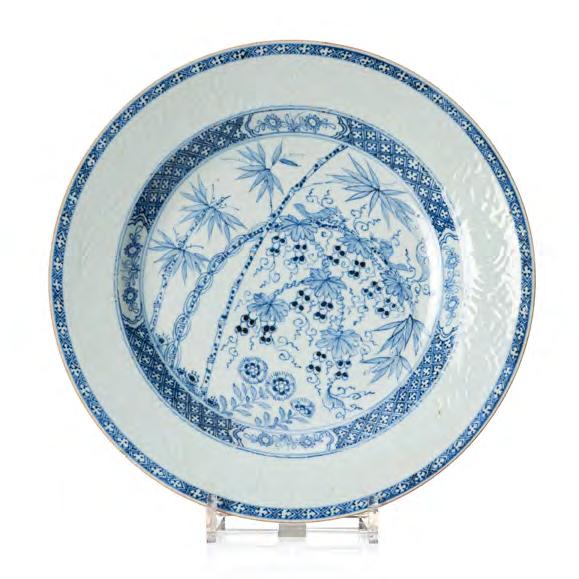
1080. A large blue and white charger, Qing dynasty, Qianlong (1736–95).
Decorated in underglaze blue with a central motif with a garden in full bloom. Diameter 42 cm.
Provenance: From the Collection of Per Pahren. For other lots sold from this collection see Bukowskis, auction 580, 2014. Lot no 160, 263, 287, 288, 289, 290, 291, 294, 510.
Estimate: SEK 6 000 – 8 000 / EUR 520 – 690

1079. A blue and white dish, Qing dynasty, Yongzheng (1723–35).
Decorated in underglaze blue with squirrels amidst grape vine and the rim with carved anhua decoration. Diameter 31.5 cm.
Provenance: From the Collection of Per Pahren. For other lots sold from this collection see Bukowskis, auction 580, 2014. Lot no 160, 263, 287, 288, 289, 290, 291, 294, 510.
Estimate: SEK 4 000 – 6 000 / EUR 350 – 520

1081. A set of six famille rose ‘double peacock’ dishes, Qing dynasty, Qianlong (1736–95).
Lobed, decorated in famille rose with double peacocks in a landscape setting. Diameter 23 cm.
Provenance: From the Collection of Per Pahren. For other lots sold from this collection see Bukowskis, auction 580, 2014. Lot no 160, 263, 287, 288, 289, 290, 291, 294, 510. Label from M Molvidson AB, Antique shop in Stockholm, Sweden.
Catalogue note: This pattern, known as “ Serviço dos Pavões “ or “ double peacocks Service “, is one of the most famous design in Chinese Export Porcelain, specially in Portugal and Brazil. The royal family of Portugal owned one service with it. When Napoleon invaded Portugal, The King Joao VI, soon Emperor of Brazil, fled in exile to Brazil and brought his six Chinese porcelain services with him, including this one. The royal and imperial family used it then at the Paço de São Cristóvão and at Fazenda Imperial de Santa Cruz.
It is known as the “viajante” service because, it first travelled from China to Portugal, and then from Portugal to Rio de Janeiro. When the Empire turned into the Republic of Brazil, the six Chinese porcelain services of the Joao VI were scattered through auctions held in 1890 by the auctioneer Joaquin Dias dos Santos in Rio de Janeiro. Since the archives of the auction house burned, it is now impossible to distinguish the pieces formerly owned by the King Joao VI from the pieces with this pattern produced at the same period.
Estimate: SEK 4 000 – 6 000 / EUR 350 – 520

The collection of a private Finnish Collector
T he collection was formed between 1980-2020, the collector has had an interest in China and Chinese Works of Art since childhood, growing up in Beijing. He returned to China in grownup years for work, he came to live in China altogether more than 40 years.
His love of China, and Chinese works of art is mirrored in the collection and being an academic collector, he never got tired of learning more about the subject by studying literature, attending lectures, visiting museums, auction houses and befriending curators from P eking, Hong Kong, London, Paris, and Stockholm. The collection consists of both Chinese ceramics and textiles, this being part 1.
LOT 1082 – 1144


1082. A large blue and white ‘deer and pine’ charger, Ming dynasty, 16th century.
Decorated with group of deer in a landscape setting with pine trees, lingzhi fungus, peaky mountains and a water-fall. Around the rim Buddhist emblems alternating with flowers. The reverse decorated with further fruits and flowers. Diameter 46 cm.
Provenance: Property of a private Finnish Collection. Purchased at Bukowskis 2009, Sale 554, lot no 1459.
Literature: Chinese Ceramics in the Topkapi Saray Museum, Istanbul, Ming dynasty. Compare dishes of this kind of designs on page 616–617.
Estimate: SEK 30 000 – 50 000 / EUR 2 570 – 4 280
1083. A large blue and white charger, Ming dynasty, 16th century.
Grapes surrounded by its leaves and tendrils in the center. The flowers alternating with ribboned emblems. The reverse decorated with peaches and cherry blossom. Diameter 43.5 cm.
Provenance: Property of a private Finnish Collection. Purchased at Bukowskis 2006, sale 542, lot no 1827.
Literature: Chinese Ceramics in the Topkapi Saray Museum, Istanbul, Ming dynasty. Compare dish of this designs on page 620.
Estimate: SEK 70 000 – 100 000 / EUR 6 000 – 8 570
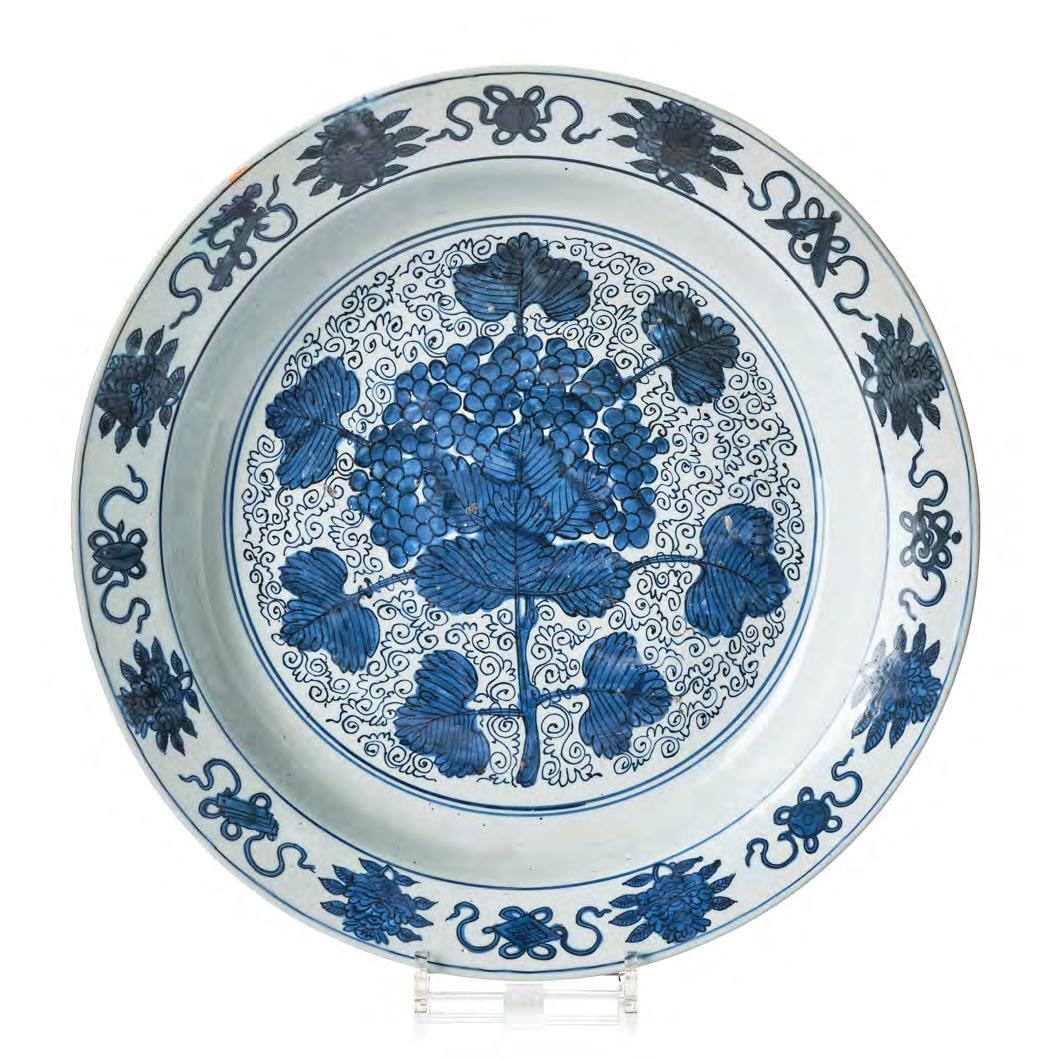

1085. A blue and white dish, Ming dynasty (1368–1644).
Decorated in underglaze blue with a bird in a garden.
Diameter 29.5 cm.
Provenance: Property of a private Finnish Collection. Purchased at Bukowskis 2009, S187, lot no 906.
Estimate: SEK 6 000 – 8 000 / EUR 520 – 690
1084. A large blue and white dish, Ming dynasty (1368–1644).
Rounded sides, tapering footrim, unglazed base. Decorated to the center with a conch shell in a lotus pond, the exterior of the rim further decorated with a continuous lotus pattern.
Diameter 32 cm.
Provenance: Property of a private Finnish Collection. Purchased at Bukowskis, Sale 542, lot 1821.
Estimate: SEK 8 000 – 10 000 / EUR 690 – 860
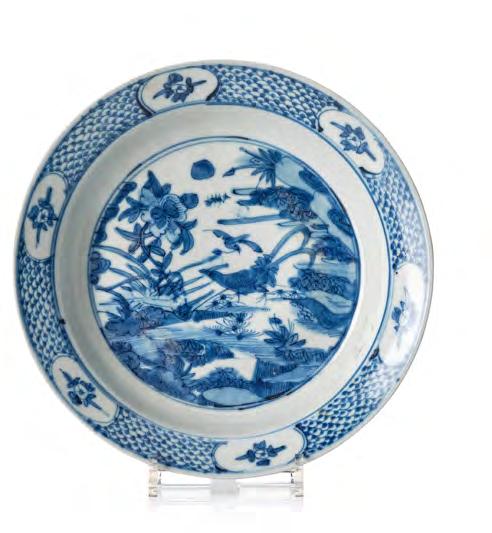

1086. A large blue and white ‘lotus’ jar, Ming dynasty, Wanli (1572–1620).
Of lobed octofoil shape, decorated in underglaze blue with a continuous lotus scroll. Height 18.5 cm.
Provenance: Property of a private Finnish Collection. Purchased at Christies, June 8 2006, Sale no 8785, lot no 654. Marked with label from S. Marchant & Son. London, W.S. Marked with Lable from Bluett & Son, London.
Estimate: SEK 30 000 – 50 000 / EUR 2 570 – 4 280
1087. A large blue and white bowl, Ming dynasty, Wanli (1572–1620).
Decorated in underglaze blue with a continuous scene with deer and cranes in a garden full of plants such as banana, peonies, chrysanthemum etc. Along the rim a broad band decorated with cranes amidst cloud formation. The center with a mythical beast below a rim decorated with squirrels by fruit vines. Diameter 31 cm. Height 16.5 cm.
Provenance: Property of a private Finnish Collection. Purchased at Bukowskis, auction 601, lot no 444. The Stenbeck Collection Part II.
Exhibitions: The Stenbeck Collection was exhibited at the Heinola Museum in Finland in 2000, under the exhibition name “The Liberated Brush”.
Estimate: SEK 50 000 – 75 000 / EUR 4 280 – 6 430


1089. A blue and white ‘klap-mutz’ bowl, Ming dynasty, Wanli (1572–1620).
Decorated in underglaze blue with antiques and emblems. Diameter 20 cm.
Provenance: Property of a private Finnish Collection. Purchased at Bukowskis, sale 526, lot no 1650.
Estimate: SEK 8 000 – 10 000 / EUR 690 – 860
1088. A blue and white kraak dish, Ming dynasty, Wanli (1572–1620).
Decorated in underglaze blue with a central motif of two men in a mountain landscape with waterfalls. Around the rim tulips, landscapes and flowers. Diameter 35.2 cm.
Provenance: Property of a private Finnish Collection. Purchased in Helsinki, 08 Mar 2006, s127 lot 176.
Estimate: SEK 10 000 – 15 000 / EUR 860 – 1 290


1091. A blue and white bowl, Transition, 17th century. The base with a six-character Jiajing mark within double circle. Rounded sides on a short foot rim, decorated to the interior with a roundel with a riverscape. The exterior painted with a scene with two elegant ladies and a boy in a garden.
Diameter 14 cm. Height 7 cm.
Provenance: Property of a private Finnish Collection. Purchased at Bukowskis, Auction 552, lot no 1656.
Estimate: SEK 12 000 – 15 000 / EUR 1 030 – 1 290

1093. A blue and white pot, Transition, 17th century. Four character mark to base. Decorated in underglaze blue with a groom and his two horses. Diameter by rim 12 cm.
Height 8.5 cm.
Provenance: Property of a private Finnish Collection.
Estimate: SEK 6 000 – 8 000 / EUR 520 – 690
1090. A set of five blue and white dishes, Ming dynasty, Wanli (1572–1620).
After a metal shape, decorated with deer in a landscape setting. Diameter 20 cm.
Provenance: Property of a private Finnish Collection. Purchased at Bukowskis 2007 Sale 544 lot no 1665.
Literature: Compare Christie’s, The Peony Pavilion Collection 12th June 1989, lot 206, p 24, 25.
Estimate: SEK 10 000 – 15 000 / EUR 860 – 1 290

1092. A blue and white Transition jar, 17th century. Ovoid shape, unglazed rim, decorated in a vibrant underglaze blue with a gentleman riding a mythical creature followed by his entourage under a full moon. Height 18 cm.
Provenance: Property of a private Finnish Collection. Purchased at Bukowskis, 2000, S132, lot no 178.
Estimate: SEK 20 000 – 25 000 / EUR 1 720 – 2 140



1094. A large blue and white ‘100 antiques’ incense burner, Qing dynasty, Kangxi (1662–1722).
Sturdily potted with bulbous sides rising from a heavily potted foot to a waisted neck and flaring rim, the exterior painted with a continuous scene symbolizing a hundred antiques and precious objects, among them a scroll painting that folds out to reveal a landscape, all this below a band with panels depicting books, scrolls, a qin instrument and a board game. Height 17.5 cm. Diameter 24.8 cm.
Provenance: Property of a private Finnish Collection. Purchased at Christies, Paris, Auction 5413, lot no 341.
Estimate: SEK 40 000 – 60 000 / EUR 3 430 – 5 140
1095. A blue and white lotus jar with cover, Qing dynasty, Kangxi (1662–1722).
Robustly-potted body rising from a flat base to a rounded shoulder and short waisted neck, painted around the exterior in rich cobalt-blue tones with a continuous design of classic lotus flowers and leaf scrolls. Domed cover with a finial in the shape of a Buddhist lion. Height 60 cm.
Provenance: Property of a private Finnish Collection. Purchased at Bukowskis, Sale 552, lot no 1667.
Exhibitions: Compare with a lotus jar sold at Bonhams, Fine Asian Works of Art, 20 Nov 2006, San Francisco. Lot no 6368.
Literature: Regina Krahl & John Ayers, Chinese Ceramics in the Topkapi Saray Museum, vol III, Compare a vase of this type depicted on page 1003, lot 2130.
Estimate: SEK 50 000 – 75 000 / EUR 4 280 – 6 430


1096. A blue and white lotus dish, Qing dynasty, Kangxi (1662–1722).
The interior boldly painted in vivid underglaze blue with large lotus flowers and scrolling foliage, the exterior decorated with rock formations. Diameter 36 cm.
Provenance: Property of a private Finnish Collection. Purchased at Christies, 2006, Sale 4019, lot no 156.
Exhibitions: Compare Bonhams, Fine Chinese Art, 17 May 2012, London, New Bond Street, lot 271.
Literature: Compare a ‘lotus’ dish illustrated in Qing Shunzhi Kangxi chao qinghua ci, Beijing, 2005, no.79.
Catalogue note: The Chinese Lotus Flower is an emblem of purity and enlightenment. This exquisite flower is a symbol of strength, beauty, and spiritual significance in Chinese culture. The lotus flower is regarded as a sacred plant that is associated with Buddhism, Confucianism, and Taoism, and is revered for its many spiritual meanings and symbolism.
Estimate: SEK 15 000 – 20 000 / EUR 1 290 – 1 720
1097. A blue and white ‘phoenix and peony’ dish, Qing dynasty, Kangxi (1662–1722).
Rounded sides, double footrim, decorated in a vibrant underglaze blue with a phoenix bird in a garden in full bloom. Diameter 33.5 cm.
Provenance: Property of a private Finnish Collection. Purchased at Christies, Sale 2584, lot no 148.
Exhibitions: Compare a dish of this topic and size in the British Museum, Museum number Franks.169.
Catalogue note: There is a saying in Chinese culture: peonies and phoenixes together are a symbol of ultimate happiness and richness.
Estimate: SEK 20 000 – 30 000 / EUR 1 720 – 2 570

1098. A blue and white censer, Qing dynasty, Kangxi (1662–1722).
Raised on a short foot, the bombé body depicting a continuous river landscape with a fisherman seated on a rocky shore, surrounded by mountains in a tree-strewn landscape, a cloud and emblems pattern band to the waisted neck. Diameter 21.8 cm. Height 14.2 cm.
Provenance: Property of a private Finnish Collection. Purchased at Bukowskis Sale 548. lot no 1793.
Exhibitions: Compare with a similar sold at Bonhams, Asian Art, 30 October 2023, London, Knightsbridge. Lot 108. Compare with a similar sold at Chrisites, 20–28 march 2018, Sale 16255. The Art of China: London, Spring Edition. Lot 200.
Estimate: SEK 30 000 – 50 000 / EUR 2 570 – 4 280


1100. A blue and white tea caddy with cover, Qing dynasty, Kangxi (1662–1722).
Ovoid shape, unglazed rim, decorated in a vibrant underglaze blue colour with lotus flowers. Height 15 cm.
1099. A pair of blue and white dishes, Qing dynasty, Kangxi (1662–1722).
Decorated in underglaze blue with lotusscroll. Diameter 30 cm.
Provenance: Property of a private Finnish Collection. Purchased at Bukowskis, sale 518 lot no 1463.
Estimate: SEK 12 000 – 15 000 / EUR 1 030 – 1 290
Provenance: Property of a private Finnish Collection. Purchased at Bukowskis Sale 542, lot no 1867. Then from the Collection of Krister Löfgren.
Estimate: SEK 10 000 – 15 000 / EUR 860 – 1 290


1101. A blue and white bottle flask, Qing dynasty, Kangxi (1662–1722).
Decorated in blue and white with antiques and precious objects. Height 18 cm.
Provenance: Property of a private Finnish Collection. Purchased at Bukowskis, lot no 1864.
Estimate: SEK 4 000 – 6 000 / EUR 350 – 520
1102. A set of four blue and white dishes with leaping carp, Qing dynasty, Kangxi (1662–1722).
Decorated in underglaze blue with leaping carps, around the rim wave formations. Diameter 21 cm.
Provenance: Property of a private Finnish Collection. Purchased at Bukowskis, 2010, Sale 559, lot no 1681.
Catalogue note: In Chinese mythology, Longmen “Dragon Gate” is located at the top of a waterfall cascading from a legendary mountain. The legend states that while many carp swim upstream against the river’s strong current, few are capable or brave enough for the final leap over the waterfall. If a carp successfully makes the jump, it is transformed into a powerful dragon. The legend is so famous that throughout China, a common saying is that “a student facing his examinations is like a carp attempting to leap the Dragon Gate.”
Estimate: SEK 8 000 – 10 000 / EUR 690 – 860

1104. A blue and white ming-style ‘lotus bouquet’ dish, Qing dynasty, 18th century.

1103. A set of four large blue and white dishes, Qing dynasty, Kangxi (1662–1722).
Decorated in underglaze blue with a scroll painting depicting flowers in full bloom in a garden setting. Diameter 27.5 cm.
Provenance: Property of a private Finnish Collection. With label from Magaliff Antique, Birger Jarlsgatan 13, 1145 Stockholm.
Estimate: SEK 4 000 – 6 000 / EUR 350 – 520
Modelled after an early Ming dynasty prototype, well potted with shallow rounded sides supported on a short tapered foot, finely decorated to the interior with a floral bouquet, around the rim a continuous floral scroll that is repeated on the back of the rim. Diameter 28.3 cm.
Provenance: Property of a private Finnish Collection. Purchased at Bukowskis, 2008, S183. Lot no 393.
Estimate: SEK 15 000 – 20 000 / EUR 1 290 – 1 720


1105. A blue and white ming style dish, Qing dynasty, 18th century.
Rounded sides, blackened base. Decorated in underglaze blue with a continuous lotus scroll. Diameter 34.5 cm.
Provenance: Property of a private Finnish Collection. Purchased at Bukowskis, lot no 1628.
Exhibitions: Compare, Sothebys, lot 700, Important Chinese Art, 21 March 2018, New York.
Estimate: SEK 30 000 – 40 000 / EUR 2 570 – 3 430
1106. A blue and white dish with stylized dragons, 18th century.
Rounded sides, unglazed base, decorated in underglaze blue with stylized dragons amidst cloud formations. The back with lingzhi fungus. Diameter 28 cm.
Provenance: Property of a private Finnish Collection. Purchased at Bukowskis 2008, Sale 0550, lot no 2076.
Estimate: SEK 20 000 – 25 000 / EUR 1 720 – 2 140


1107. A blue and white bowl, Qing dynasty, 18th century.
Rounded sides on a tall footrim, decorated to the exterior with an elegant lady with two boys in a palace garden. The interior decorated with peonies. Diameter 26.5 cm.
Provenance: From a Finnish Private Collection. Purchased at Christies, Amsterdam, 2000, lot no 113.
Estimate: SEK 12 000 – 15 000 / EUR 1 030 – 1 290
1108. A large blue and white serving dish, Qing dynasty, Qianlong (1736–95).
Decorated in underglaze blue with antiques and precious objects in a garden in full bloom. Diameter 41.8 cm.
Provenance: Property of a private Finnish Collection. Purchased at Bukowskis, 2004, January, lot no 134.
Estimate: SEK 8 000 – 10 000 / EUR 690 – 860


1109. A large blue and white bowl, Qing dynasty, Qianlong (1736–95).
Deep rounded sides on a tall footrim, decorated with a riverscape, the interior with peonies, bamboo and pommegranate. Diameter 30.5 cm.
Provenance: Property of a private Finnish Collection. Purchased at Christies, Amsterdam, 2000, lot no 113.
Estimate: SEK 8 000 – 10 000 / EUR 690 – 860
1110. A large ‘four-clawed dragon’ jardiniere, Qing dynasty, 18th century.
Sturdily potted, decorated in gold with two fierce four clawed dragons amidst cloud formations chasing the flaming pearl above wild waves, all against a blue ground. Height 27.5 cm.
Provenance: Property of a private Finnish Collection. Purchased at Bukowskis 2000, Sale 518, lot no 1414.
Estimate: SEK 30 000 – 50 000 / EUR 2 570 – 4 280


1111. A blue and white ‘phoenix’ bowl with cover, Qing dynasty, Guangxu mark and period (1875–1908).
Decorated with two confronting phoenix birds amidst clouds, the underside and inside of cover similarly decorated. Diameter 26 cm. All in a fitted, silk clad box, measure of box 30.5 x 30.5 x 15 cm.
Provenance: Property of a private Finnish Collection. Purchased at Christies, Auction Sale 2561, lot no 215.
Estimate: SEK 40 000 – 50 000 / EUR 3 430 – 4 280


1112. A blue and white phoenix dish, Qing dynasty, Guangxu mark and period (1875–1908).
With wide flaring sides, the interior decorated with two confronting phoenix birds amidst clouds, the underside similarly decorated. Diameter 26.5 cm.
Provenance: Property of a private Finnish Collection. Purchased at Bukowskis, 2006, S172. Lot no 628.
Exhibitions: Compare with Sothebys, Important Chinese Art. Lot no 752. 22 March 2023, New York.
Estimate: SEK 25 000 – 35 000 / EUR 2 140 – 3 000


1113. A large blue and white ‘five clawed dragon’ dish, Qing dynasty, Guangxu mark and period (1875–1908).
Decorated in a vivid underglaze blue colour with two five clawed dragons chasing the flaming pearl amidst cloud formations. The back of the rim repeating the pattern with the dragons. Diameter 34 cm.
Provenance: Property of a private Finnish Collection. Purchased at Bukowskis, January 2004, lot no 155.
Exhibitions: Compare with a dish of this type sold at Bonhams, lot 41, Fine Chinese Art, 16 May 2013, London, New Bond Street Compare with a dish of this type, sold at Christies, 14–29 sep 2022 | Art of China, lot no 11.
Estimate: SEK 12 000 – 15 000 / EUR 1 030 – 1 290


1114. A blue glazed ‘cong formed’ vase, Qing dynasty, Guangxu mark and period (1875–1908).
The vase is flanked by a pair of molded elephant-head-handles suspending fixed rings and is covered overall with a lustrous, deep sapphire-blue glaze thinning slightly on the edges.
Height 28.5 cm.
Provenance: Property of a private Finnish Collection. Purchased at Sothebys, November 16th 1999, Sale 3914, lot no 151.
Exhibitions: Compare with a similar vase sold at Christies, 24–25 march 2022, Live Auction 20594, Important Chinese Ceramics and Works of Art, lot 1132. Compare also with one sold at, The Hundred Antiques: Fine and Decorative Asian Art, 24 March 2021, New York, lot no 524.
Estimate: SEK 75 000 – 100 000 / EUR 6 430 – 8 570


1115. A celadon glazed cong vase with ‘Eight Trigrams’ decoration, Qing dynasty, Guangxu mark and period (1875–1908).
The square section vase moulded with the ba gua to each facet, with a short neck with a rolled mouth rim, raised on a slightly flared foot, all covered with an even celadon green glaze.
Height 27.5 cm.
Provenance: Property of a private Finnish Collection.
Exhibitions: Compare with similar vase sold at Bonhams, Asian Art, May, 2017, Live Auction, London, Knightsbridge, lot 197.
Literature: A very similar vase but with a Xuantong mark in the National Palace Museum, Taipei, is illustrated in H.A. Van Oort, Chinese Porcelain of the 19th and 20th centuries, Lochem, 1977, pl.111.
Estimate: SEK 80 000 – 100 000 / EUR 6 850 – 8 570
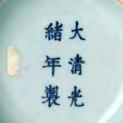

1116. A celadon glazed vase, late Qing dynasty, with Yongzheng mark.
Pear shaped with a bulb shaped rim, ring handles to the shoulder, glazed in a celadon glaze. Base with a Yongzheng six character mark within double circle in underglaze blue. Height 21 cm.
Provenance: Property of a private Finnish Collection.
Estimate: SEK 12 000 – 15 000 / EUR 1 030 – 1 290

1118. A pair of blue and white vases with celadon ground decorated with Buddhist lions, late Qing dynasty/circa 1900. Baluster shape with a waisted neck and a flared rim, handles in the shape of Buddhist lions, decorated in underglaze blue against celadon with a group of Buddhist lions. Height 58.5 cm.
Provenance: Property of a private Finnish Collection.
Estimate: SEK 8 000 – 10 000 / EUR 690 – 860



1117. A celadon glazed moon flask, possibly Republic with a Yongzheng mark.
Flattened shape with handles, decorated with stylized dragons amidst cloud formations, glazed in a pale green celadon glaze. Base with a six character Yongzheng mark in underglaze blue. Height 19 cm.
Provenance: Property of a private Finnish Collection.
Estimate: SEK 8 000 – 10 000 / EUR 690 – 860

1119. A celadon ground blue and white flower pot, 20th century.
Decorated with stylized dragons to celadon ground. Height 17, diameter 26 cm.
Provenance: Property of a private Finnish Collection.
Estimate: SEK 8 000 – 10 000 / EUR 690 – 860
1120. A pair of blue and white tureens with covers, Qing dynasty, 19th century.
Round, slightly doomed cover, decorated with cherry blossom in underglaze blue. Height 19 cm. Diameter 17.5 cm.
Provenance: Property of a private Finnish Collection.
Estimate: SEK 4 000 – 6 000 / EUR 350 – 520


1121. A flambé glazed vase, Qing dynasty, 19th century.
Drop shaped with a tall neck, glazed in a vibrant red flambé glaze that turns in to celadon green by the rim. Height 33 cm.
Provenance: Property of a private Finnish Collection. Purchased at Bukowskis, Sale 0542, lot no 1686, 2006.
Estimate: SEK 18 000 – 20 000 / EUR 1 550 – 1 720
1122. A flambé glazed vase, late Qing dynasty/ early 20th century.
Lobed baluster shape, decorated in vibrant flambé glaze. Height 28.5 cm.
Provenance: Property of a private Finnish Collection.
Estimate: SEK 4 000 – 6 000 / EUR 350 – 520
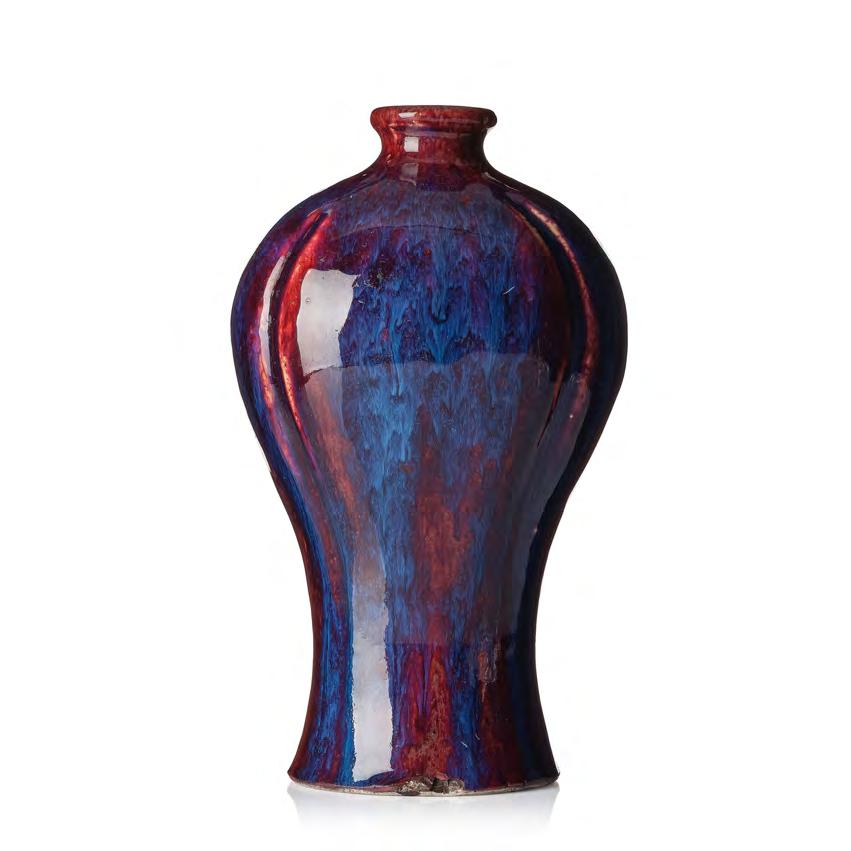

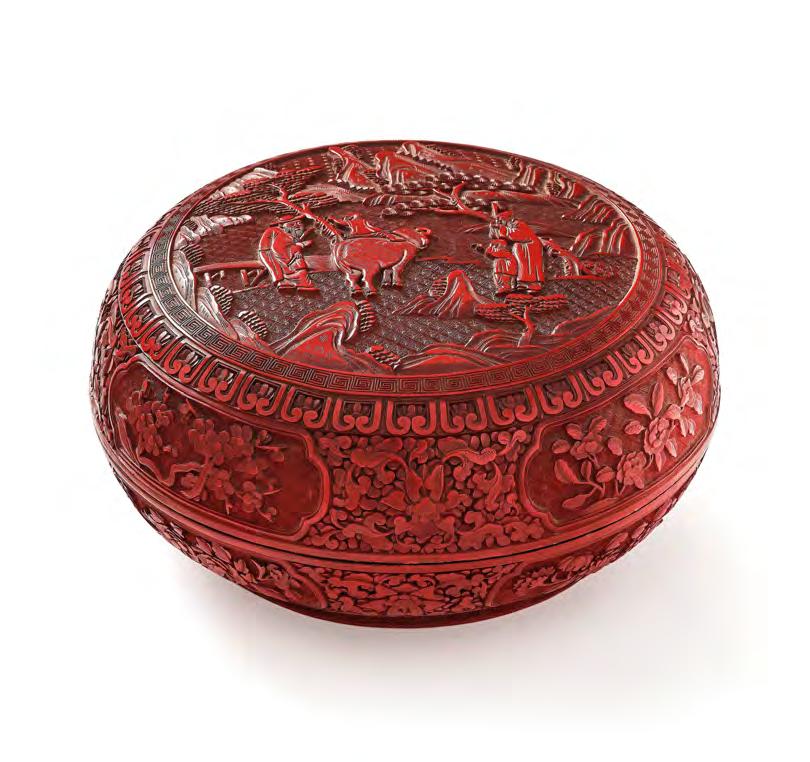
1124. A red lacquer box, Qing dynasty, 19th century.
Rounded sides, the top panel decorated in deep relief with boys playing in a garden by a river. The sides with panels decorated with peonies, magnolia, cherry blossom and narcissus.
Diameter 15.8 cm.
Provenance: Property of a private Finnish Collection.
Estimate: SEK 10 000 – 15 000 / EUR 860 – 1 290

1126. A blanc de chine rhinoceros libation cup, Qing dynasty, Kangxi (1662–1722).
Decorated in relief, with a bird, two dragons, pine trees, and blossoming cherry trees. Height 8.2 cm. Length 10.5 cm.
Provenance: Property of a private Finnish Collection. Purchased at Bukowskis, 2009, Sale 552, lot no 1504.
Exhibitions: Compare a similar cup with the same kind of bird, in the Collection of the Musee Guimet, Paris, G 3589.
Estimate: SEK 5 000 – 7 000 / EUR 430 – 600
1123. A large lacquer box with cover, Qing dynasty, with Qianlong mark.
The top of the cover with a circular panel is deeply carved on wan-diaper ground enclosing some scholars with attendants. The rounded sides of the box and cover are carved with panels of flowers, divided by lotus scrolls. The base is lacquered black, incised to the centre with a Qianlong reign mark. Diameter 32 cm.
Provenance: Property of a private Finnish Collection. Purchased at Bukowskis 2017, 601 lot no 551. Then from the Collection of Folke Isacsson.
Folke Isacsson (1898–1975), founder of a Gothenburg printing house, played a major role in the Gothenburg art scene in the 1930s and thereafter, partly as a patron and partly as chair of the Gothenburg Art Society, deputy chair of the Gothenburg Museum Board and a member of the board of the art school
Valands Konstskola, the Museum of Art’s Purchasing Committee and Friends of the Museum of Art. Together with his wife Sigrid (1900–1987) he created a fantastic collection of important Swedish and international artists as well as Asian Art.
Estimate: SEK 60 000 – 80 000 / EUR 5 140 – 6 850

1125. A pair of red lacquer boxes, Qing dynasty. Round flattened shape, decorated in relief with flowers. The interior lacquered black. Diameter 7.4 cm. Height 3 cm.
Provenance: Property of a private Finnish Collection.
Estimate: SEK 15 000 – 20 000 / EUR 1 290 – 1 720


1128. Withdrawn.
1129. A wucai jar, Transition, 17th century.
Of baluster shape with a waisted neck and flared rim, decorated in wucai colours with panels with laughing boys amidst peonies.
Height 28.5 cm.
Provenance: Property of a private Finnish Collection. Purchased at Bukowskis, S187, lot no 637. 2009.
Estimate: SEK 10 000 – 15 000 / EUR 860 – 1 290

1131. A famille verte tea pot with cover, Qing dynasty, early 18th century.
Large, decorated i famille verte colours with birds in a garden setting. Height 11.5 cm. Length 21 cm.
Provenance: Property of a private Finnish Collection. Purchased at Bukowskis 2005, S166, Lot no 1020.
Exhibitions: With label from Magaliff Antique, Birger Jarlsgatan 13, 111 45 Stockholm.
Estimate: SEK 6 000 – 8 000 / EUR 520 – 690
1127. A olive green brush washer, Qing dynasty, 18th century.
Domed shape, pale greyish green glaze. Height 5.5 cm. Diameter 10 cm.
Provenance: Property of a private Finnish Collection. Purchased at Bukowskis 2019, Auction Sale no 617, lot no 605, from the Collection of Erik Holmberg, Björnbo 17, Lidingö.
Estimate: SEK 5 000 – 7 000 / EUR 430 – 600

1130. A set of two famille verte dishes, Qing dynasty, Kangxi (1662–1722).
Matched set, decorated in famille verte colours with birds in a garden. Diameter 23.5 cm.
Provenance: Property of a private Finnish Collection. Purchased at Bukowskis, 2008, sale 500, lot no 1968.
Estimate: SEK 8 000 – 10 000 / EUR 690 – 860

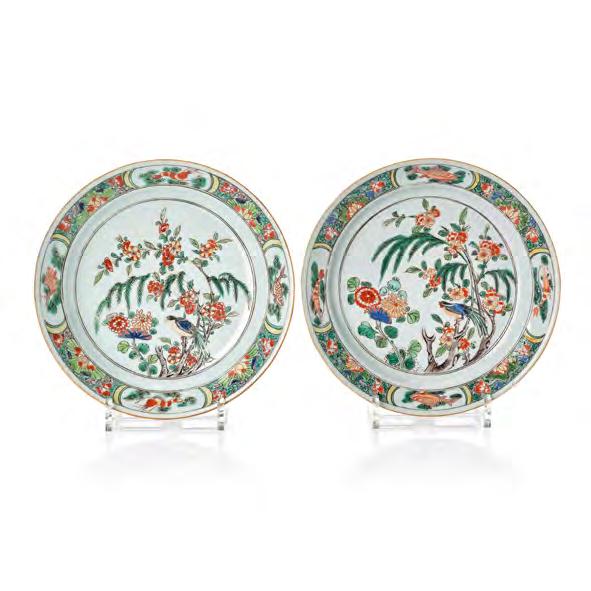
1133. A set of two of famille verte bowls, Qing dynasty, Kangxi (1662–1722).
One decorated in famille verte with birds and butterflies in a garden. Diameter 11.3 cm. The other one decorated with mythical creatures and flowers. Diameter 11 cm.
Provenance: Property of a private Finnish Collection. Purchased at Christies, Amsterdam, Sale 2584, lot no 196.
Estimate: SEK 8 000 – 10 000 / EUR 690 – 860

1132. A pair of famille verte plates. Qing dynasty, Kangxi (1662–1722).
Decorated with birds in gardens with prunus and chrysanthemums. The rims with shrimps and fishes within cartouches between lotus flowers. The exterior of the rim decorated with flowers in iron red. Diameter 23.5–24 cm.
Estimate: SEK 4 000 – 6 000 / EUR 350 – 520
1134. An imari jar, Qing dynasty, 18th century. Ovoid shape, unglazed rim, decorated in imari colours with phoenix birds a mythical creatures. Height 22.5 cm.

Provenance: From a Finnish Private Collection. From a Finnish Private Collection. Purchased at Bukowskis, 2005, S166, lot no 989.
Estimate: SEK 10 000 – 15 000 / EUR 860 – 1 290
1135. A set of three famille rose dishes, Qing dynasty, 18th century.
Decorated in famille rose colours with flowers. Diameter 31.5 cm.
Provenance: Property of a private Finnish Collection. Purchased at Bukowskis Sale 526, 2002, lot no 1612.
Estimate: SEK 15 000 – 20 000 / EUR 1 290 – 1 720


1136. A pair of famille rose rooster vases with covers, Qing dynasty, 18th century. Of baluster shape, decorated in famille rose with roosters in a garden setting. Height 28 cm.
Provenance: Property of a private Finnish Collection. Purchased at Bukowskis, lot no 1567.
Estimate: SEK 50 000 – 75 000 / EUR 4 280 – 6 430
1137. A famille rose serving dish, Qing dynasty, 18th century. Of oval shape, decorated with a figure scene from court life. Length 42.5 cm.
Provenance: Property of a private Finnish Collection. Purchased at Bukowskis, 187, lot no 102.
Estimate: SEK 8 000 – 10 000 / EUR 690 – 860


1138. A famille rose flower pot with a stand, Qing dynasty with a Yongzheng mark.
Octagonal shape, decorated in famille rose with a riverscape, interior and base in turquoise glaze. Height 17.5 cm. Diameter 21.5 cm. Diameter of dish 20 cm.
Provenance: Property of a private Finnish Collection.
Estimate: SEK 8 000 – 10 000 / EUR 690 – 860
1139. A pair of ‘famille verte’ lanterns, Qing dynasty, 19th century.
Made in two pieces. Decorated in famille verte with panels depicting outings along the river-side. Height in all 31 cm.
Provenance: Property of a private Finnish Collection. Purchased at Bukowskis, S187, lot no 697, 2009.
Estimate: SEK 12 000 – 15 000 / EUR 1 030 – 1 290

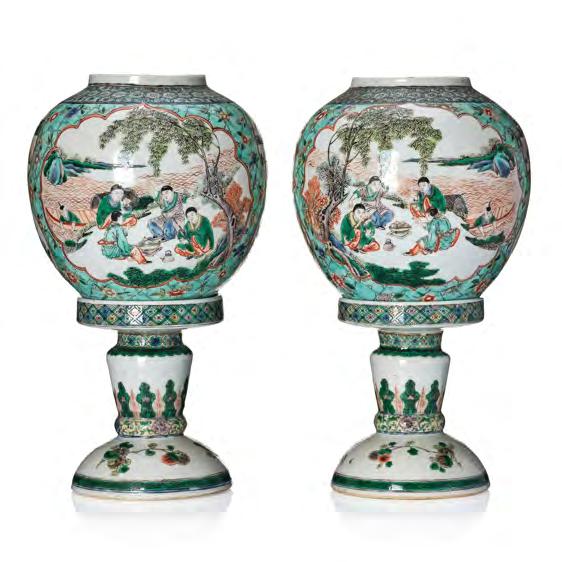
1140. A group of four iron red ‘Shou Character’ plates, late Qing dynasty.
Decorated in iron red and gold with symbols, characters and emblems. Diameter 23 cm.
Provenance: Property of a private Finnish Collection.
Estimate: SEK 12 000 – 15 000 / EUR 1 030 – 1 290

1141. A pair of famille rose bowls, late Qing dynasty/republic with Qianlong mark.
Deep, decorated with four panels in enamels with flowers in a garden all against a yellow ground. The interior decorated with gourd fruit in enamels against an orange ground. Diameter 13.2 cm. Height 8.5 cm.
Provenance: Property of a private Finnish Collection.
Exhibitions: Compare with a bowl like this at The Chigaco Institute of Art, Credit Line; Bequest of Henry C. Schwab Reference Number 1941.508. Depicted on their website.
Estimate: SEK 20 000 – 30 000 / EUR 1 720 – 2 570



1142. A ‘faux-bois’ brush pot/flower pot, Qing dynasty.
Tall, decorated in relief with bamboo, two central panels decorated in enamel with pug dogs standing in a garden beneath pine trees and cherry blossom, further bands of faux bois decoration in iron red. Two holes in the base for water drainage. Height 21 cm. Diameter 23 cm.
Provenance: Property of a private Finnish Collection.
Estimate: SEK 20 000 – 30 000 / EUR 1 720 – 2 570
1143. A famille rose basin, Qing dynasty/circa 1900.
Deep, decorated in famille rose with two elegant ladies in a palace setting, the inside of the rim decorated with flowers and birds, the flared rim with lotus flowers in a pond, the exterior decorated with bamboo in red. Diameter 36 cm. Height 12 cm.
Provenance: Property of a private Finnish Collection.
Estimate: SEK 4 000 – 6 000 / EUR 350 – 520


1144. A Chinese famille rose flower pot, early 20th century.
Rectangular shape with a flared rim, decorated in enamels with a bird and a rooster in a garden setting, the sides with calligraphy. Measure 16.8 x 11.2 x 12 cm.
Provenance: Property of a private Finnish Collection.
Estimate: SEK 4 000 – 6 000 / EUR 350 – 520

The collection of a Swedish Connoisseur
From the Collection of a Swedish Connoisseur of Asian Works of Art. This is part of a collection, a collection that was assembled not only with great care, b ut also with a deep curiosity and passion for learning - a true academic collection. The collector has been actively buying and studying Chinese porcelain since the early 1970’s.
To see other lots sold from this collection, see Bukowskis auction 0649. Lot no 951–967.
LOT 1145 – 1168

1145. A blue and white ‘lotus’ jar, Ming dynasty, 16th century. Of baluster shape, decorated in a continuous lotus scroll. Height 12 cm.
Provenance: From the Collection of a Swedish Connoisseur of Asian Works of Art.
Estimate: SEK 5 000 – 7 000 / EUR 430 – 600
1146. A small blue and white jar, Ming dynasty, circa 1500.
Decorated with a floral scroll. Height 9.5 cm.
Provenance: Purchased from the Carl Johan Thornander Collection. From the Collection of a Swedish Connoisseur of Asian Works of Art.
Estimate: SEK 4 000 – 6 000 / EUR 350 – 520
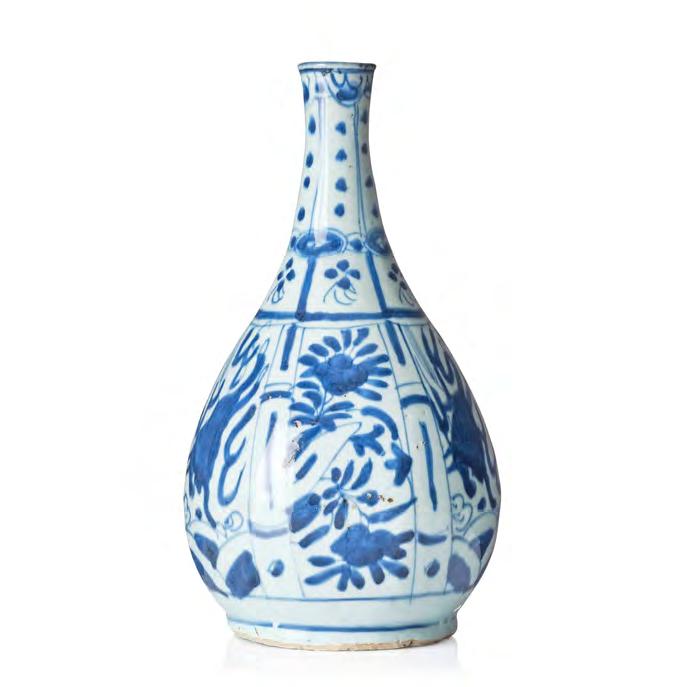

1147. A blue and white flask, Ming dynasty, Wanli (1572–1620).
Pear shaped, decorated in underglaze blue with flying horses and flowers. Height 28 cm.
Provenance: From the Collection of a Swedish Connoisseur of Asian Works of Art.
Estimate: SEK 20 000 – 25 000 / EUR 1 720 – 2 140

1149. A set of three kraak dishes, Ming dynasty, Wanli (1572–1620).
1148. A blue and white bottle, Ming dynasty (1368–1644).
With a later metal mount. Droppshaped, decorated in underglaze blue with flowers in a lotus pond. Height 22 cm.
Provenance: From the Collection of a Swedish Connoisseur of Asian Works of Art.
Estimate: SEK 6 000 – 8 000 / EUR 520 – 690
Lobed, decorated in underglaze blue with two deer in a landscape setting, around the rim birds and flowers.
Diameter 21.3 cm.
Provenance: From the Collection of a Swedish Connoisseur of Asian Works of Art.
Literature: Rinaldi, Maura; Kraak porcelain, a moment in the history of the trade, 1989, compare pl 53. dating them as 1570–1600.
Estimate: SEK 6 000 – 8 000 / EUR 520 – 690


1150. Two blue and white ‘klapmutz’ dishes, Ming dynasty, Wanli (1572–1620).
Decorated to the center with a bird on a rock formation.
Diameter 15 cm.
Provenance: From the Collection of a Swedish Connoisseur of Asian Works of Art.
Estimate: SEK 8 000 – 10 000 / EUR 690 – 860
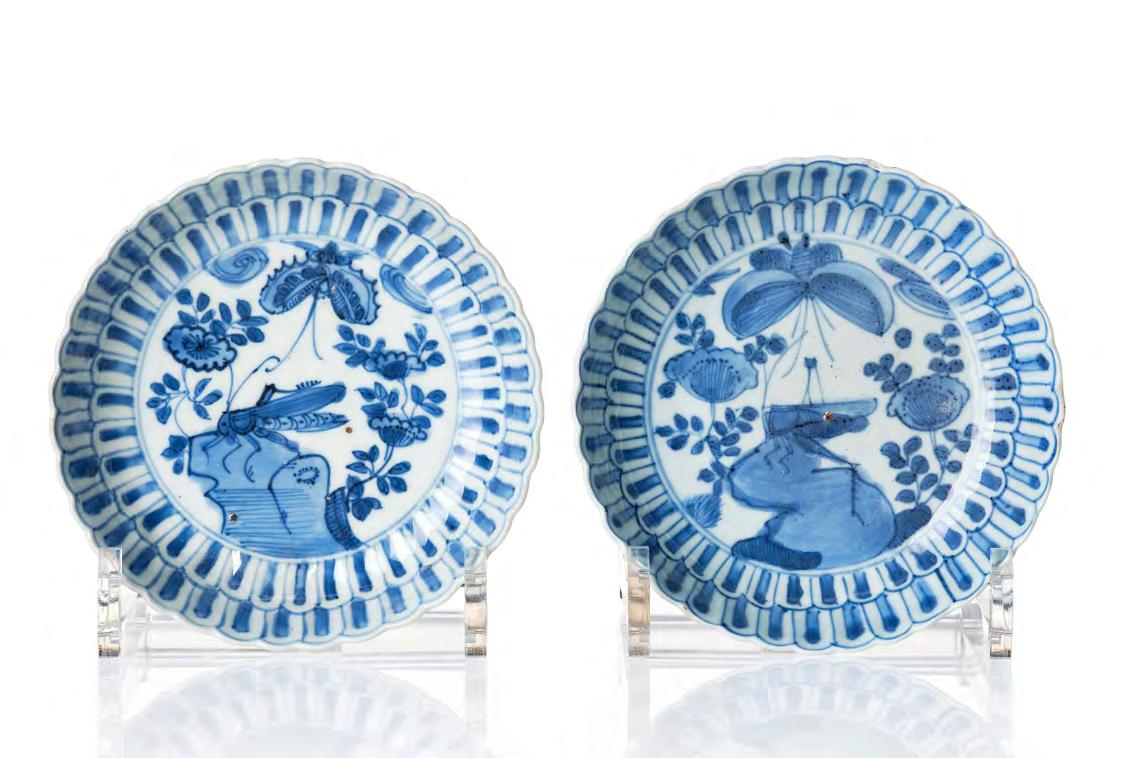
1151. A pair of blue and white dishes, Ming dynasty, Wanli (1572–1620).
Chrysanthemum shape, decorated in underglaze blue with a cricket on a rock formation and with a butterfly and flowers. Diameter 13.8 cm.
Provenance: From the Collection of a Swedish Connoisseur of Asian Works of Art.
Estimate: SEK 5 000 – 7 000 / EUR 430 – 600

1153. A pair of blue and white ‘anhua’ dishes, Ming dynasty, Wanli (1572–1620).
Lobed, with anhua decoration of lotus around the rim, the center of the dish with tall mountains by set in a riverscape. Diameter 14 cm.
Provenance: From the Collection of a Swedish Connoisseur of Asian Works of Art.
Estimate: SEK 4 000 – 6 000 / EUR 350 – 520
1152. A set of two blue and white dishes, Ming dynasty, 17th century.
Chrysanthemum shaped, decorated with a bird of pray in a garden setting. Diameter 19.5 cm.
Provenance: From the Collection of a Swedish Connoisseur of Asian Works of Art.
Literature: Krahl, Regina & Ayers, John, Chinese Ceramics in the Topkapi Saray Museum, Vol II. Yuan/Ming; Compare dishes of this model depicted on page 711.
Estimate: SEK 5 000 – 7 000 / EUR 430 – 600


1154. A pair of blue and white bowls, Ming dynasty (1368–1644).
Rounded sides, with a flared rim standing on a tapering footrim.
Decorated with sea dragons above fierce waves. Diameter 15.5 cm.
Provenance: From the Collection of a Swedish Connoisseur of Asian Works of Art.
Estimate: SEK 12 000 – 15 000 / EUR 1 030 – 1 290

1156. A pair of blue and white dishes, Tianqi/Chongzhen, 17th century.
Decorated in underglaze blue with a riverscape with tall mountains and pagodas. Diameter 9.5 cm.
Provenance: From the Collection of a Swedish Connoisseur of Asian Works of Art.
Estimate: SEK 4 000 – 6 000 / EUR 350 – 520
1155. A set with two blue and white Tianqi dishes, 17th century.
Kraak style petal-moulded deep dishes, decorated in underglaze blue with a single vase with flowers. Diameter 14 cm.
Provenance: From the Collection of a Swedish Connoisseur of Asian Works of Art.
Literature: Krahl, Regina & Ayers, John, Chinese Ceramics in the Topkapi Saray Museum, Vol II. Yuan/Ming; Compare dishes of this model depicted on page 852. Compare dishes of this style in the Peony Pavilion Collection Sale, Christies, London, 12 June 1989.
Estimate: SEK 8 000 – 10 000 / EUR 690 – 860


1158. A pair of blue and white dishes, Ming dynasty, 17th century.
Hall mark to base. Rounded sides that rises from a short footrim, decorated in underglaze blue with a garden rock and blossoming chrysanthemum flowers. Diameter 13.5 cm.
Provenance: From the Collection of a Swedish Connoisseur of Asian Works of Art.
Literature: Krahl, Regina & Ayers, John, compare similar dishes in the Topkapi Saray. Vol I-III.
Estimate: SEK 5 000 – 7 000 / EUR 430 – 600
1157. Two blue and white dishes, Tianqi/Chongzhen, 17th century.
Hall mark to base. Lobed, decorated in a vibrant underglaze blue colour, central motif with a lotus pond, around the sides, bands of different patterns. Diameter approx. 16 cm.
Provenance: From the Collection of a Swedish Connoisseur of Asian Works of Art.
Estimate: SEK 10 000 – 15 000 / EUR 860 – 1 290

1159. Two blue and white cabaret dishes, 17th century. Decorated in underglaze blue with flowers in a garden. Length 11.5 cm.
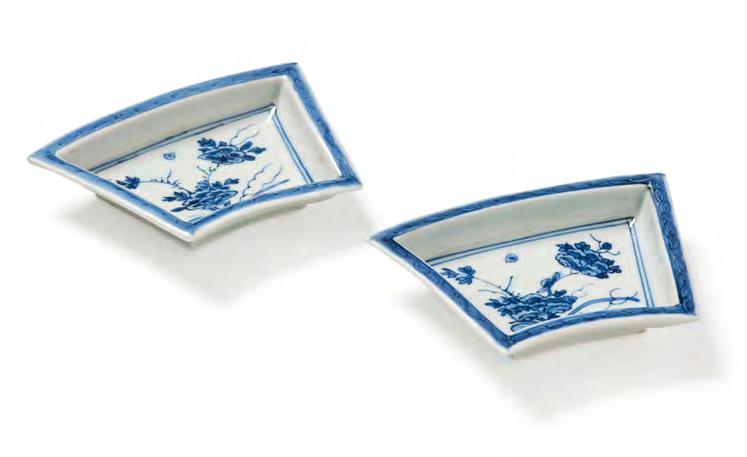
Provenance: From the Collection of a Swedish Connoisseur of Asian Works of Art.
Estimate: SEK 4 000 – 6 000 / EUR 350 – 520

1160. A blue and white goblet, Transition, 17th century. Tall cup with slightly flared rim, the cup rests on a tall footrim. Decorated in underglaze blue with a riverscape under a full moon. Height 13.5 cm.
Provenance: From the Collection of a Swedish Connoisseur of Asian Works of Art.
Estimate: SEK 10 000 – 15 000 / EUR 860 – 1 290
1161. A blue and white jug, Transition, 17th century.
Pear shaped, with a handle, decorated in underglaze blue with a riverscape under the full moon. Brown ring at the rim. Height 16 cm.
Provenance: From the Collection of a Swedish Connoisseur of Asian Works of Art.
Estimate: SEK 10 000 – 15 000 / EUR 860 – 1 290
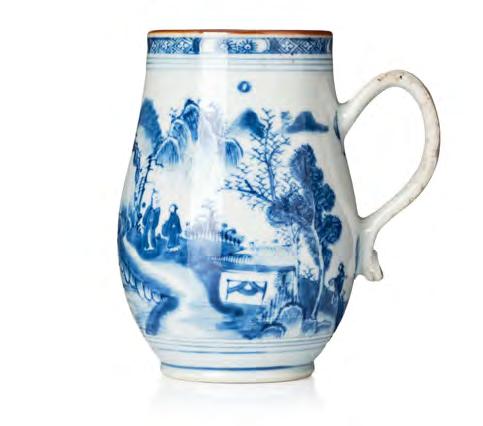

1163. A blue and white mustard pot, Qing dynasty, Kangxi (1662–1722).
With later mount. Decorated in underglaze blue with ‘lange-lisen’ alternating with flowers in a pot. The base with an artemisia leaf. Height 13.5 cm.
Provenance: From the Collection of a Swedish Connoisseur of Asian Works of Art.
Exhibitions: To see another mustard pot with this kind of decoration, see Bonhams, Knightsbridge, London, lot no 247. 20 May 2008.
Estimate: SEK 5 000 – 7 000 / EUR 430 – 600

1162. A pair of blue and white ‘soft paste’ cups with saucers, Qing dynasty, Kangxi (1662–1722).
Lobed, decorated in underglaze blue with flowers within borders. Diameter cup 7.7 cm. Diameter saucer 12 cm.
Provenance: From the Collection of a Swedish Connoisseur of Asian Works of Art.
Estimate: SEK 5 000 – 7 000 / EUR 430 – 600

1164. A pair of blue and white ‘Nei Fu’ cups and a small tray, Qing dynasty for the Thai market.
Decorated in underglaze blue with a riverscape and poems. Silver lining. Poem translates to ‘soft rain, spring wind, happy, retun’ and ‘flat boat, fully loaded, books, heavy’. Height of cup 3.5 cm. Diameter tray 13.8 cm.
Provenance: From the Collection of a Swedish Connoisseur of Asian Works of Art.
Estimate: SEK 10 000 – 15 000 / EUR 860 – 1 290

1166. A famille verte dish, Qing dynasty, Kangxi (1662–1722).
1165. A yellow glazed cup holder, Qing dynasty with Xuandes four character mark.
Rounded sides, short footrim, glazed in a deep yellow glaze. The base with Xuande four character mark within double circle. Diameter 12.3 cm.
Provenance: Purchased from Guest & Gray, London. From the Collection of a Swedish Connoisseur of Asian Works of Art.
Estimate: SEK 25 000 – 30 000 / EUR 2 140 – 2 570

Decorated in imari verte colours with a pine tree in a garden. Diameter 22 cm.
Provenance: From the Collection of a Swedish Connoisseur of Asian Works of Art.
Literature: Krahl, Regina & Ayers, John, Chinese Ceramics in the Topkapi Saray Museum, Vol III. Qing porcelains; Compare dishes of this model depicted on page 1183.
Estimate: SEK 3 000 – 3 500 / EUR 260 – 300

1168. A famille rose serving dish, Qing dynasty, Qianlong (1736–95).
Decorated with Linnea Borealis around the rim and a rose to the center. Length 46.5 cm.
Provenance: Purchased at Bukowskis, sale 605, lot 629. Then from the collection of the Hall family, Gunnebo slott. From the Collection of a Swedish Connoisseur of Asian Works of Art.
Estimate: SEK 4 000 – 6 000 / EUR 350 – 520

1167. A pair of famille rose dishes with entertainers, Qing dynasty, Qianlong (1736–95).
Lobed, decorated in famille rose colours with a group of entertainers such as a lady walking on a line, a man juggling knives, and a dog walking on it’s hind legs. Diameter 12.8 cm.
Provenance: From the Collection of a Swedish Connoisseur of Asian Works of Art.
Estimate: SEK 4 000 – 6 000 / EUR 350 – 520

The collection of Edit Pettersson
From the Collection of Edit Pettersson (1890-1970).
Edit was born in Eskilstuna, Sweden, and studied to be a midwife at Löweströmska hospital in Väsby. She graduated in Stockholm 1913, and after working for 2 years as a private midwife/nurse with a family in Värmland, she travelled with the Sibirian railroad to China, and settled in Kiaockow in 1915 to work as midwife with the missionaries there.
In 19 20 she fell ill and was nursed at the German Hospital and then began her journey back, taking the S.S. Empress of Asia for the first leg of the travel, a stemer famous for crossing the Pacific in nine days, two hours, and fifteen minutes. She came to spend 5 years in China and kept in close contact throughout her life with the connections she made out there. She had a god son of the Emperor living with her and her husband in Hagalund, when he had fled China temporarily due to the political situation. The items have been treasured memories of the family since.
LOT 1169 – 1175



1169. An embroidered and winter padded Chinese silk jacket, Qing dynasty, 19th century. Embroidered with gold thread, elegant collar, blue silk woven with Buddhist emblems. Padded/lined for winter use. Yellow lining. Length back 90.5 cm. Length arm to arm 163 cm.
Provenance: From the Collection of Edit Pettersson (1890–1970).
Literature: Svenska Barnmorskor, Professor Birger Lundqvist, Stockholm, 1940.
Estimate: SEK 10 000 – 15 000 / EUR 860 – 1 290
Edit Pettersson in her midwife uniform.
S.S. Empress of Asia.

1170. A silk blue-ground brocade panel, late Qing dynasty/early 20th century.
Woven with four five clawed dragons chasing the flaming pearl amidst cloud formations and stylized lotus flowers. In the corners a total of eight Buddhist lions with brocade balls and censers. Around it all, a band repeating the twelve animals of the zodiac, the corners with phoenix birds.
Measure approx. 100 x 100 cm.
Provenance: From the Collection of Edit Pettersson (1890–1970).
Catalogue note: Possibly used as a scroll cover.
Estimate: SEK 3 000 – 4 000 / EUR 260 – 350
1171. A five piece stone inlayed pewter tea service, China, early 20th century.
Marked ‘The Old Capital, 229 Chien Men St. Peking’. Elegantly decorated in relief with stone inlay. Comprising: a tray, 24.5 x 15.5 cm; a tea pot with cover, length 17.5 cm, height 11.5 cm; a milk jug with cover, height 9.5 cm, length 9.5 cm; a sugar bowl with cover, length 10.5 cm, height 9 cm; a large jar with cover of a slightly different design, length 19 cm, height 9 cm.

Provenance: From the Collection of Edit Pettersson (1890–1970).
Estimate: SEK 4 000 – 6 000 / EUR 350 – 520
1172. A Soapstone brush washer, a presentation box for Hu Kaiwen brand, with a painting by Lushu, late Qing dynasty, 1900.
The brush pot sculptured with a qilin dragon sitting on the rim. Height 5.3 cm. Length 6.5 cm. Measure of paintings motif 50 x 22 cm.
Provenance: From the Collection of Edit Pettersson (1890–1970).
Estimate: SEK 4 000 – 6 000 / EUR 350 – 520

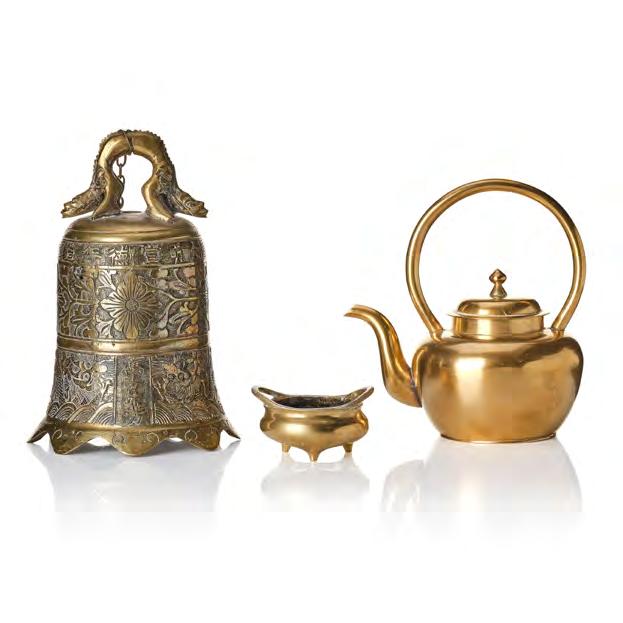
1173. A small tripod censer, a temple bell and a tea pot with cover, Qing dynasty.
Tripod with upturned handles, and Xuande mark to base. Length 8 cm. Height 4.4 cm. A tea pot with cover, upturned handle, height 16 cm, length 16 cm. A temple bell, decorated in relief and with a finial in the shape of a two-headed beast. Xuande mark. Height 20 cm.
Provenance: From the Collection of Edit Pettersson (1890–1970).
Estimate: SEK 6 000 – 8 000 / EUR 520 – 690
1174. A brass pipe, a heater and a joss stick holder, Qing dynasty.
The pipe decorated with flowers, height 27 cm. The heater, height 10.5 cm. The joss stick holder decorated with dragons, height 22 cm.
Provenance: From the Collection of Edit Pettersson (1890–1970).
Estimate: SEK 4 000 – 6 000 / EUR 350 – 520
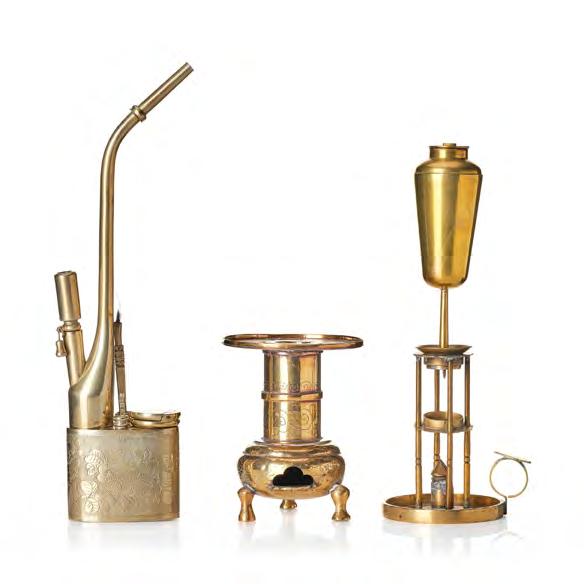

1175. A group of Chinese coins, silver and copper, Qing dynasty and early 20th century.
One Chinese ‘fat man yuan shih kai silver dollar’. Diameter 3.9 cm, weight 26.8 gram. A group of six smaller silver coins, diameter 1.8–2.2 cm, weight 20.8 grams. A group of seven small copper coins, diameter 2.3–3,1 cm, weight 43.6 grams. A group of 21 brass coins, weight 94.4 grams.
Provenance: From the Collection of Edit Pettersson (1890–1970).
Estimate: SEK 6 000 – 8 000 / EUR 520 – 690
 From the collection of a Korean collector, scientist and a member of the Nobel committee. Thence by descent. Lot no 1178-1185
From the collection of a Korean collector, scientist and a member of the Nobel committee. Thence by descent. Lot no 1178-1185

1177. A white glazed Korean vase, Joseon. A voluminous body with a tall neck and a slightly flared rim.
Height 23.5 cm.
Provenance: Purchased in Hong Kong between 1986–1988. Subsequently inherited by the current owner.
Estimate: SEK 6 000 – 8 000 / EUR 520 – 690
1178. A Korean Celadon glazed double gourd bottle, Koryo dynasty, 12/13th century.
Double gourd shape, the body incised with three long stalks of flowering lotus and cloud formations, celadon glaze. Height 34.4 cm.
Provenance: Purchased at Christies, Korean Celadons from the Collection of Mrs Norma Gruber, April 18th, 1977. London.
Literature: Depicted in the Christies ad of Oriental Art, Spring 1977. Vol XXIII. No 1. Page 8. Magazine accompanies the vase.
Estimate: SEK 30 000 – 50 000 / EUR 2 570 – 4 280

1179. A celadon glazed bowl, Korea, Goryeo dynasty, 12th century.

Deep bowl with a molded decoration with lotus flowers, covered with a sea-green tone of ge glaze. Diameter 17.5 cm.
Estimate: SEK 5 000 – 7 000 / EUR 430 – 600

1180. A blue and white Korean vase, Joseon Dynasty (1392–1897).
Rounded body, slightly flared rim. Decorated in underglaze blue with flowers and symbols. Height 12.5 cm.
Provenance: Purchased August 26, 1971. Chosun Hotel, Seoul, Korea.
Estimate: SEK 6 000 – 8 000 / EUR 520 – 690

1182. Two blue and white dishes, late Ming/ early Qing dynasty, 17th century.
One decorated with flowers and stylized patterns. Diameter 16 cm. The other dish decorated with trigrams, Chinese characters and circles. Diameter 14.5 cm.
Estimate: SEK 3 000 – 3 500 / EUR 260 – 300
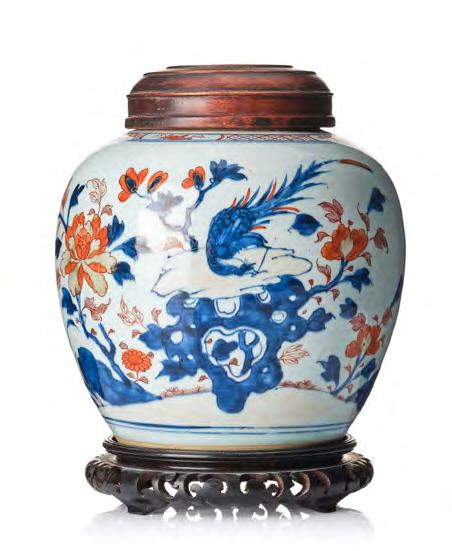

1181. Two Korean bowls and a dish, Joseon dynasty (1392–1897).
A white glazed deep circular bowl on a raised foot. Height 7 cm. Diameter 10.2 cm. A white glazed deep circular bowl on a short footrim. Diameter 9 cm. A dish decorated with a shou character within a double circle. Diameter 16.5 cm. With inscribed characters to the reverse.
Estimate: SEK 6 000 – 8 000 / EUR 520 – 690

1183. An imari jar, Qing dynasty, 18th century. Ovoid shape with an unglazed rim, decorated in imari colours depicting a bird in a landscape setting. Height 22 cm. Height with wooden stand and cover 28 cm.
Estimate: SEK 8 000 – 10 000 / EUR 690 – 860

1185. A Chinese jade pendant made in to a brooch, late Qing dynasty/early 20th century.
Silver mount. Carved in the shape of a gourd fruit with a bat and a peach. Length 6 cm.
Estimate: SEK 4 000 – 6 000 / EUR 350 – 520
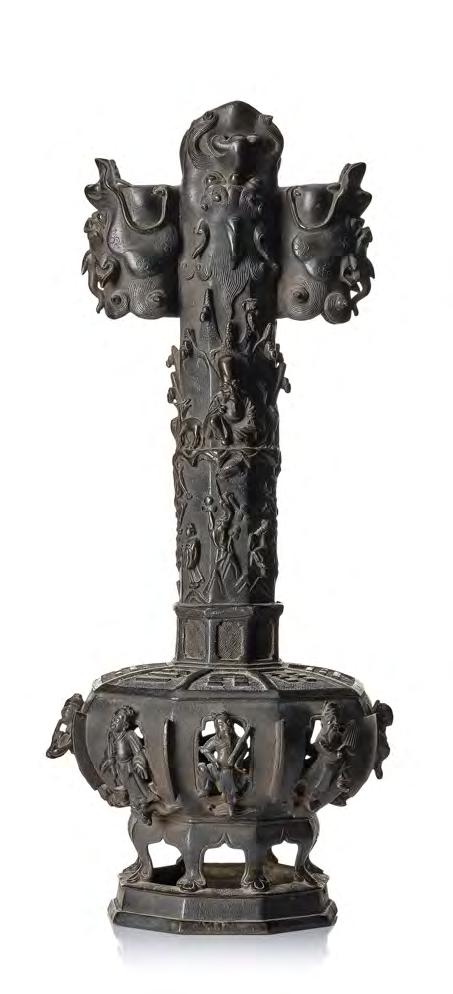
1184. A pair of green glazed parrots, late Qing dynasty. A pair of parrots depicted sitting on top of a rock formation, glazed in green, yellow, blue and brown. Height 20.5 cm.
Estimate: SEK 4 000 – 6 000 / EUR 350 – 520

1186. A large bronze arrow vase ‘Touhu’, Ming dynasty (1368–1644). Finely cast with the ‘Eight Daoist Immortals’ around the compressed pierced body with trigrams on the shoulder, surmounted by a tall slender neck adorned with a tortoise and a crane on a leiwan ground, below Magu and Shoulao and two canted-corner square lug handles shaped as dragons between two clambering chilong, standing on a octagonal spreading foot. Height 57 cm. Height with mount as a lamp and with lamp shade 84 cm.
Provenance: Property of a private Swedish Collector.
Exhibitions: Compare with a related bronze arrow vase decorated with the Eight Immortals and other longevity figures, Ming dynasty, in the Cernuschi Museum, Paris, illustrated by M.Maucuer, Bronzes de la Chine Impériale des Song aux Qing, Paris, 2013, p.151, no.103. See also a Cizhou arrow vase, circa 1522-1566, decorated with the Eight Immortals, in the British Museum, London, illustrated by J.Harrison-Hall, Catalogue of Late Yuan and Ming Ceramics in the British Museum, London, 2001, p.437, no.14:6.
Literature: Compare Bonhams, More than a Game Games in Chinese Art, including the Brian Harkins Collection of Bronze Arrow Vases, Hong Kong, Admirality, 29 – 30 May 2022. The present vase is decorated with ten Daoist Immortals, a turtle and a crane, all of which symbolise longevity.
Catalogue note: These type of vases were designed for the ancient Chinese game of touhu, or ‘arrow throwing’, which would form part of the entertainment at banquets and is mentioned in early classical texts such as the Chunqiu Zuo Zhuan. Contestants would aim feathered arrows at the various cylinders applied to the vase, with higher points awarded for the less accessible openings. The loser was made to drink wine, leading to increased inebriation and diminished throwing accuracy.
Estimate: SEK 25 000 – 30 000 / EUR 2 140 – 2 570
1187. A large bronze tripod censer, Qing dynasty with Xuande six character mark.
Tripod with upturned handles. Length 22.5 cm. Height 17.5 cm.
Estimate: SEK 8 000 – 10 000 / EUR 690 – 860
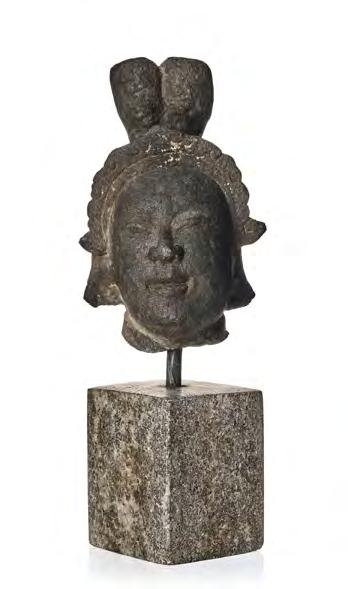


1188. A stone sculpture, Ming dynasty (1368–1644) or older.
Sculptured head with a diadem and elaborate hair due. Height with wooden stand 23 cm. Height head 13 cm.
Provenance: Inherited from the collection of Gunnar Wennerberg, to Amelie Posse, thence by descent within the family.
Exhibitions: Purchased at Bukowskis 929, lot no 680.
Estimate: SEK 6 000 – 8 000 / EUR 520 – 690
1189. A bronze sculpture of Ananda, Ming dynasty (1368–1644).
The arhat is cast with a contemplative expression on his face and a raised urna on the forehead flanked by long pendulous ears, heavily modelled standing on a stylized pedestal with both hands joined in prayer, wearing a long flowing robe with floral hems. Gilded and lacquered. Height 21.5 cm.
Provenance: Property of a private Swedish Collector.
Literature: A. Howard, Chinese Sculpture, New Haven, 2006, p.238, fig.3.39. In the Chan Buddhist tradition, prior to the seventh century, luohans were generally represented as a pair flanking an image of Buddha, usually identified as Kasyapa, like the present figure, and Ananda, and were both two of the ten principle disciples of Buddha and important figures in the early Buddhist monkhood sangha. In these depictions, the figures were usually represented with foreign Indian features. In China, the pair are often portrayed standing on either side of the Buddha in China, namely, Ananda standing to Buddha’s right whilst Kasyapa to the left, from at least the Northern Wei dynasty (386-535) and throughout the Sui, Tang, Liao, Song and Ming periods; see, for example, the triad formed by Ananda and Kasyapa flanking the Buddha in the Central Binyang Cave at Longmen, Shanxi.
Catalogue note: A luohan (‘arhat’ in Sanskrit) is a disciple of Buddha who has attained Enlightenment and has achieved the status of the perfected being, but chooses to postpone his accession to Nirvana to remain in the world and aid all sentient beings. The luohan achieves enlightenment through instruction rather than his own insight and meditation, and as a result, ranks below the bodhisattva. The term luohan, means ‘worthy’ or ‘venerable’ and refers to the Buddha’s original disciples, and by extension, to any holy figure who upheld and defended the Buddhist dharma. Originally only four, their numbers increased to sixteen, then eighteen and ultimately to five hundred. Ananda was a first cousin of Gautama Buddha and one of his ten principal disciples. Amongst the Buddha’s many disciples, Ananda stood out for having the most retentive memory. He was also praised by the Buddha for his erudition and compassion. He is therefore also known as the Guardian of the Dharma, as most of the sutras of the ‘Sutta Pitaka’, or ‘Pali Canon’, are attributed to his recollection of the Buddha’s teachings during the First Buddhist Council. He is often portrayed alongside Mahakasyapa, flanking Buddha on both sides.
Estimate: SEK 10 000 – 15 000 / EUR 860 – 1 290


1191. A gilt copper alloy figure of a Lama, most likely Sonam Tsemo, Tibet, probably 16/17th century.
The Lama is seated in lalitasana on a double-lotus base with scrolled petal tips and beaded rims, with his right hand raised, his left hand holds a scripts with incised Tibetan letters, the first three letters translates as ‘lam’. He is dressed in heavy robes with foliate-incised hems, clad in boots, his face has a serene expression with a steady gaze. His facial expression conveys tenderness and serenity that allow the viewers to immerse themselves in its contemplative presence. The bronze body is covered in thick gilding with its base securely sealed and finely carved with a double-vajra. Face and hair with later cold gilt painting. Height 17 cm.
Provenance: From the Collection of Heidi Boyce Broström (1943–2022) and Dan Axel Broström (1915–1976). Dan Axel Broström was the third-generation ship-owner in the prestigious Broström Company group. When he took over the firm in 1949 they had 18 000 employees. The Canadian model and geologist Heidi was Dan-Axel Broströms third wife, the couple lived at the fashionable Särö, a few miles south of Gothenburg.
Catalogue note: Tibetan Buddhist art integrated previous artistic traditions into a new style which became highly realistic and influential. The spiritual aura radiating from the figure is rendered dynamically by the skillful craftsmanship.
Estimate: SEK 40 000 – 60 000 / EUR 3 430 – 5 140
1190. A Sino Tibetan figure of Adibuddha Vajradhara, 15/16th century.
Seated in dhyanasana on a double-lotus base, his hands crossed in front of his chest holding vajra (thunderbolt) and ghanta (handbell), wearing a dhoti, sash and beaded jewellery, his face with raised urna and his hair pulled into a high chignon secured by a foliate crown. Cold gilt. Height 12 cm.
Provenance: Property of a private Swedish Collector.
Exhibitions: Compare with British Museum inventory number 1979,0514.1.
Catalogue note: From the 11th century onward, the New (Sarma) Schools identify Vajradhara as the primordial Buddha (Adi Buddha): the inner form of Shakyamuni, and progenitor of the Vajrayana Buddhist system. He occupies the first rank in the Buddhist pantheon, and typically features as the first teacher of a tantric lineage. From him emanate the five Dhyani Buddhas, the purification deity Vajrasattva, and meditation deities including Chakrasamvara. He represents the highest state of enlightenment, its abstract perfection, the sum of all Buddhist teachings. Sculptures of Vajradhara therefore serve as secondary representations, reminding practitioners of the deity’s otherwise formless essence, which is beyond human comprehension.
Estimate: SEK 15 000 – 20 000 / EUR 1 290 – 1 720


1192. A gilt bronze sculpture of a Lama, Tibet, 18th century. Probably depicting Gyalwa Gendün Gyatso (1475–1542), the second Dalai Lama from the Gelugpa sect. Depicted seated in a meditative pose, rather stocky body, his right hand in vitarka mudra, the left resting in his knee, has probably held a book or a vase. Now missing. Height 10.5 cm.
Provenance: Property of a private Swedish Collector. Purchased at Strömbergs Antik, Copenhagen, Denmark 1993.
Estimate: SEK 30 000 – 50 000 / EUR 2 570 – 4 280
1193. A gilt bronze Pala-revival sculpture of Amittayus, 18/19th century, possibly Mongolian.
Finely cast seated in vajraparyankasana on a double-lotus base, depicted with hands held in dhyana mudra supporting a bumpa, his face with a serene expression and framed by an elaborate headdress and a pair of pendulous earlobes adorned with ornamental earrings, clad in loose clothing with finely detailed floral hems and neatly folded by the lotus base. Traces of cold gilt and enamels. Height 15.5 cm.
Literature: Tibetan Buddhism was patronized by the Qing emperors, both for personal and political reasons, resulting in a surge in the production of Buddhist sculpture and painting. During the reign of Qianlong, the artisans of the Beijing workshops increasingly emulated sculpture from different periods and geographic areas, using as models the bronzes given as gifts from Tibetan dignitaries to the Qing court.
Examples of Pala-style sculpture, from ninth-twelfth century Northeastern India, still remain in The Palace Museum Collection. Compare with a Pala-period bronze figure of Vajrasattva, illustrated in Cultural Relics of Tibetan Buddhism Collected in the Qing Palace, Beijing, 1992, Catalogue no. 56, and with a Pala-style Tibetan brass statue of Manjushri (see ibid., cat. no. 53).
Estimate: SEK 40 000 – 60 000 / EUR 3 430 – 5 140

1194. A gilt copper repousse figure of Bodhisattva, Mongolia, Dolonnor, circa 1800.

1193A. A gilt copper alloy figure of Tara, Tibet, circa 1800. Seated in lalitasana on a double-lotus throne, her left hand in vitarkamudra, her right hand held in prithvimudra, and adorned with bejewelled necklaces around the waist and the chest, large earrings, hair pulled up in a high chignon, the deity wearing a simple dhoti with embroidered hem. Height 17 cm.
Estimate: SEK 20 000 – 25 000 / EUR 1 720 – 2 140
The figure sits in dhyanasana on a double-lotus base with both hands held in vitarkamudra. Clad in a flowing dhoti with hems incised with a foliate pattern, and is adorned with various jewellery. The hair is pulled into a tall chignon behind the repoussé tiara. The base is sealed with a wooden plate. Made in separate pieces. Height 38 cm.
Provenance: From a Finnish private collection. From the Collection of Alexander Kenel (1898—1970), who was born in St. Petersburg into a family of famous architects, the family originated from France, the ancestors came to Russia during the Napoleonic campaign, and his French name was Charles L de Kenel. He studied at the Conservatory of St Petersburg and had a career as a composer. This sculpture was given as a gift to his friend Elsa, when they worked together in the Khakass Theater in the 1960’s. Elsa and Alexander Kenel were good friend and performed together numerous times. Thence by descent within Elsas family.
Exhibitions: Compare with Christies, lot 1231. 16 September 2016, 12175. Fine Chinese Ceramics and Works of Art.
Literature: One can also compare with the many repousse figures depicted on web archive of the Palace Museum Beijing.
Catalogue note: The present work exhibits many characteristics common to the Buddhist workshops, such as the combination of cast and repoussé parts, the languid and slightly effeminate treatment of the face and body, and the tightly waisted doublelotus base with broad petals. The Qing court patronage of Buddhism that begun under the Kangxi Emperor reached epic proportions under his grandson, the Qianlong Emperor. The Buddhist centers of Beijing, Rehol, and Dolonnor produced thousands upon thousands of images to keep up with the demand of the numerous temples in and outside the capital.
Estimate: SEK 40 000 – 50 000 / EUR 3 430 – 4 280


1195. A massive zitan recessed-leg long table ‘Jiaotousun Qiotouan’, Qing dynasty, 19th century.
Finely carved and composed of dark tightly grained timber, the wide thick plank top set in a frame with scrollwork on the edge, above a richly carved pierced apron with pomme granate and twirly branches with leaves, this decoration continues by the richly carved pierced panels framed by the legs of square section, that has centered bats, connected by ropes on both sides. Height 89 cm, length 194.5 cm, depth 43.5 cm.
Provenance: From the Collection Paul R. Wedendal (1924–2010), Djursholm, Stockholm. This table has been in the family since the 1970’s and is now sold by the family. To see objects from the Collection of Paul R. Wedendal Senior, see a single owner Asian Sale that were held in these rooms at Bukowskis in 2011. See Auction H036.
Exhibitions: Compare a table in the Asian Art Museum, San Fransisco. approx. 1750–1850, zitan, from the Avery Bundage Collection, inv. no B71M2. Compare interiors depicted in the Forbidden City, The Great Within, May Holdsworth & Caroline Courtauld. See for example the Interior of the Palace of Concentrated Beauty.
Compare the same kind of decoration of twisted ropes (then holding bi discs) on a pair of table solds Sothebys, Fine Chinese Ceramics & Works of Art, Hong Kong 8, October 2013. Lot no 3084. Compare also at the same sale lot no 3083. A pair of carved zitan tables with recessed-leg.
Literature: Life of the Emperors and Empresses in the Forbidden City, Edited by The Palace Musum, Beijing 1983. Compare furniture of this kind of carving on page 56, 82, 83. MingQing. Gungting Jia Ju Zhen da Quan, Beijing 2006. Compare tables of this style, page 255, 258. Orientations, December 1994. p 43-49. An article by Tian Jia Qing ‘Zitan and Zitan Furniture’. Discusses the great shortage during the Qing dynasty of the material during large scale use in construction projects, Tian, discovered records in the Archives of the Imperial Workshops, which indicate that ‘all the zitan found by officials through the country had to be turned over to the imperial palace... ‘.
Catalogue note: As discussed by Nancy Berliner, in a catalogue called Beyond the Screen, Chinese Furniture of the 16th and 17th Centuries, these massive tables are rare. With the social upheaval in China during the 20th Century, tables of this great size were particularly susceptible to damage. Smaller objects could easier be transported and sold. Compare also interiors with carvings like this in the Hall of Great Supremacy.
Estimate: SEK 200 000 – 300 000 / EUR 17 130 – 25 690
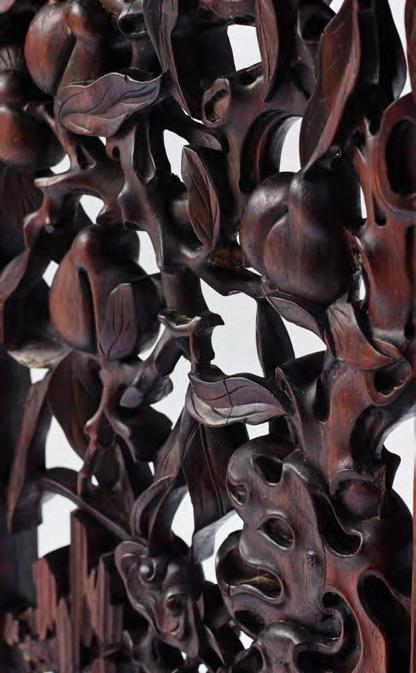

1196. A collapsable hardwood hat stand, Qing dynasty. Made in four pieces that can be put together for travelling. Decorated in relief with stylized mythical creatures. The candle holder most possibly a later addition. Height put together 35 cm. Height without candle holder 33.5 cm. Width 17 cm.
Provenance: Property of a private Swedish Collector.
Exhibitions: Compare the type of decoration on lot 1525, Sotheby’s: Asian Art 19 March 2016, New York Sale Number: N09481 Compare a different pair of zitan candles sticks from the Edward T. Chow Collection, Sothebys, 6 December 2023, Hong Kong, lot no. 629.
Estimate: SEK 8 000 – 10 000 / EUR 690 – 860
1197. A massive ‘five clawed dragon’ hardwood storage chest, Qing dynasty, 19th century.
Of rectangular shape, decorated to the front panel with two fierce five clawed dragons facing each other and chasing the flaming pearl. A round lockplate with decoration. Handles to the sides for carrying. Measure 94.5 x 56 x 50 cm. Height with later wooden stand 75.5 cm.
Provenance: From the Collection of John von Matern (1868–1928), thence by descent. John von Matern was a Swedish entrepreneur, industrialist and politician. He was head of the London office for Stora Kopparbergs Bergslags Aktiebolag, and a member of the board, from 1920 and onwards. According to the family this chest was purchased by him and his wife Yvonne Gardell-Ericson (daughter of the artists Johnan Ericson and Anna Gardell-Ericson) when they lived in London 1920–1928. Thence by descent.
Exhibitions: Compare with smaller boxes that often are decorated on all sides, see for example lot 1234, Christies, Hong Kong, May 30th 2006. The Imperial Sale.

Catalogue note: These large chest must have been made for clothes, and avoided decoration on the top so that they could be stacked on top of each other.
Estimate: SEK 30 000 – 50 000 / EUR 2 570 – 4 280

1198. A pair of wooden gilt lacqer figures of officials carrying vases, 17/18th century.
Standing figures clad in loose fitting robes holding vases with covers. Height 18 cm.
Provenance: Property of a private Swedish Collector.
Estimate: SEK 4 000 – 6 000 / EUR 350 – 520

1199. A gilt and lacquered wooden sculpture of a guardsman, Qing dynasty, 18th century.
The figure is clad in a tiger skin and loose fitted robes, holding his right hand facing upward. Height 38.5 cm.
Provenance: From the Collection of Dr. David A Hummel, (1893–1984). A Swedish medical doctor, explorer and resistance man during the World War II. The figure came to Sweden when David Hummel participated in the Sven Hedin expedition of 1927–1934, as the expeditions medic. He also participated in gathering plants, animals and mapping. After the WWII, he was awarded the Commander of the Order of St. Olav and the White Rose of Finland. David Hummel gave the sculpture to his colleague Einar Edberg, thence by descent within the family.
Exhibitions: David A Hummel donated a great deal of his collections to the Etnographic museum in Stockholm.
Literature: The black and white images is of David Axelsson Hummel, ‘Dick’, his participation in the Sven Hedin Expedition is recorded in Hedinexpeditionen, 4:1 192728 and Johan Gunnar Andersson, (1932), Den stora färden, i Ord och Bild, andra häftet, page 65-81.
The black and white group photo, 1933, David Hummel, 4th from the left. Sven Hedin in the center with a walking stick in his hand.
David Hummel på¨sion his mule in the Min Shan Tsagahing pass 3100 meter above the sea.
Estimate: SEK 30 000 – 50 000 / EUR 2 570 – 4 280


1200. A gourd qilin dragon cikada cage, Qing dynasty, 19th century. Of globular shape, decorated in relief with qilin dragons. The gourd patinated to a golden yellow tone. Height with cover 10 cm.
Provenance: Property of a private Swedish collector.
Exhibitions: Jämför liknande såld i London vid Sotheby’s, St. George Sale, 18 maj 2018. Lot 310.
Estimate: SEK 5 000 – 7 000 / EUR 430 – 600


1201. A five clawed dragon kesi robe on blue ground, Jifu, Qing dynasty, 19th century.
Finely woven in the split weave technique with the prescribed nine five clawed dragons chasing the flaming pearls and hovering above the terrestrial diagram and lishui stripe amidst a ruyi-form cloud clusters interspersed with auspicious emblems such as bats and various renditions of shou characters, the arms are striped in gold. Length 135 cm. Width arm to arm 132 cm.
Provenance: Property of a private Swedish Collector.
Estimate: SEK 4 000 – 6 000 / EUR 350 – 520

1203. An embroidered Chinse silk jacket, Qing dynasty, late 19th century.
A darker blue short jacket, length back 74 cm. Length arm to arm 128 cm.
Provenance: Purchased by the present owner in Japan.
Estimate: SEK 4 000 – 6 000 / EUR 350 – 520

1205. An embroidered dragon roundel from the surcoat of an Emperor or Imperial son, Qing dynasty, 19th century.
1202. A Han Chinese woman’s heather blue informal three quarter length coat, ‘Ao’, Qing dynasty, 19th century.
A blue silk summer gauze jacket with a woven pattern of the bajixiang and clouds. Finely embroidered with stitches. Lobed ruyi collar, sleeve edgings with figural scenes. Height 92 cm. Length arm to arm 136 cm.
Provenance: Purchased by the present owner in Japan.
Exhibitions: Compare a jacket of this type in Christies, New York, Imperial Wardrobe, Fine Chinese Costume and Textiles from the Linda Wiggelsworth Collection. March 2008. Lot no 78.
Estimate: SEK 4 000 – 6 000 / EUR 350 – 520

1204. A Chinese embroidered silk robe, late Qing dynasty/early 20th century.
Embroidered with flowers, chrysanthemum, peonies, magnolia, prunus, fruits, butterflies and bats on creme coloured silk ground. Trimming with embroidered figure scenes and landscapes to blue ground. Arm cuffs with embroidered dragons and phoenix birds. Lined. Width between arms 134, length back 98 cm.
Estimate: SEK 6 000 – 8 000 / EUR 520 – 690
Embroidered in satin stitch and fine couched gold thread with a front facing imperial dragon, the sinuous body cocued in fine gold thread against a red ground, surrounded by bats and chasing the flaming pearl amidst cloud formations, the lower part with foaming waves. Diameter 32.5 cm.
Provenance: Property of a private Swedish Collector.
Catalogue note: Roundels like these would have been made for an emperor or worn by one of his sons and would have been placed on the shoulder of the robe.
Estimate: SEK 5 000 – 7 000 / EUR 430 – 600

1206. Two Chinese embroidered silk rank badges, Qing dynasty, 19th century. Back and front. A bird dancing on fierce waves surrounded by Buddhist emblems and cloud formations. Outer framework decorated with alternating bats and shou characters. Measure 29 x 30.5 cm. Measure 39 x 40 cm.
Catalogue note: Mandarin squares were first authorized for the wear of officials in the sumptuary laws of 1391 of the Ming dynasty. The us e of squares depicting birds for civil officials and animals for military officials was an outgrowth of the use of similar squares, apparently for decorative use, in the Yuan dynasty. The original court dress regulations of the Ming dynasty were published in 1368, but did not refer to badges as rank insignia. These badges continued to be used through the remainder of the Ming and the subsequent Qing dynasty until the imperial system fell in 1912.
Estimate: SEK 6 000 – 8 000 / EUR 520 – 690



1207. An antique Imperial silk ‘Five dragon’ palace rug, Qing dynasty, 1880. Measure approx. 238 x 154.5 cm.
One end with an inscription: (Jingren gong bei yong) ‘for the use in the Palace of Great Benevolence’. A yellow ground with blooming polychrome branches as well as a medallion and corner ornaments with five-clawed dragons. A wide yellow main border with peonies and Buddhist symbols.
Catalogue note: The inscription on this rug indicates that it was woven for The Palace of Great Benevolence (Jingren gong). Jingren gong was built in 1420 and was one of the six eastern palaces in the Forbidden City. The palace served as the residence for the imperial concubines during the Ming and Qing dynasties.
Estimate: SEK 80 000 – 100 000 / EUR 6 850 – 8 570
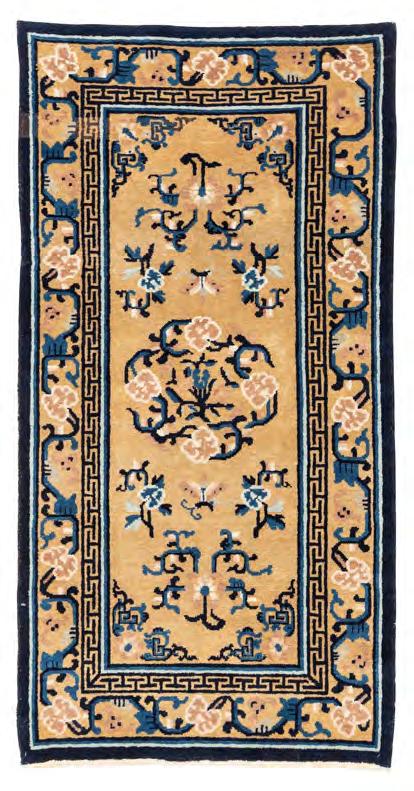

1208. A Ningxia rug, north China, Qing dynasty, late 19th century. Measure approx. 150 x 90 cm. A pale yellow ground with a polychrome medallion and flowers. A pale yellow main border with flower festoons.
Provenance: Property of a private Swedish Collector.
Estimate: SEK 6 000 – 8 000 / EUR 520 – 690
1209. An antique Chinese meditation runner, late Qing dynasty, circa 1900. Measure approx. 357.5 x 60 cm.
Six ivory fields with a flower medallion, the eternal knot and stylized flowers.
Estimate: SEK 8 000 – 10 000 / EUR 690 – 860
1210. A large scroll painting by anonymous artist, ink and colour on silk, Qing dynasty, 18th century. Three seals in red. Painted with an elegant lady of the court and a boy playing with a puppet. Measure motif 71.5x142 cm. Measure with silk clad lining 79.5x240 cm.
Provenance: Property of a private Swedish Collector.
Exhibitions: To see other lots sold from this collection see two paintings sold at Bukowskis, Spring Sale 593, 2016, Lot no 134 & 135.
Estimate: SEK 35 000 – 50 000 / EUR 3 010 – 4 280


1211. Two album pages, ink and colour on silk, Qing dynasty, 18th century. .
Romance of the Western Chamber (Xixiangji), each leaf accompanied by a long calligraphic inscription on paper, each calligraphic leaf with two seals reading Zhengming. With figure scenes set in a landscape. Measure motif 28x30.5 cm. Measure with passepartout 63x37 cm.
Provenance: Property of a private Swedish Collector.
Exhibitions: Compare with a complete album sold at Bonhams, Lot 2032, Chinese paintings, 12 September 2012, New York.
Estimate: SEK 15 000 – 20 000 / EUR 0
1212. A reverse glass painting, Qing dynasty, circa 1800. An elegant lady in a somewhat equivocal pose dressed in white and wearing a black plume. Measure 18.5 x 13.5 cm. Measure with frame 24 x 19 cm.
Provenance: The Collection of Esbjörn Kronberg. Purchased at Bukowskis, 2013, Sale 574, lot 1462.
Estimate: SEK 6 000 – 8 000 / EUR 520 – 690



1212A. A group of five Chinese gouache paintings, Qing dynasty, late 18th century, by anonymous artist.
Depicting in detail architecture, gardens, palaces and pavilions within a mountain landscape. Measure each 62 x 65 cm.
Provenance: Purchased at Christies, Paris Spring 2018, Sale 16031, Art d’Asie, lot no 46.
Estimate: SEK 50 000 – 75 000 / EUR 4 280 – 6 430
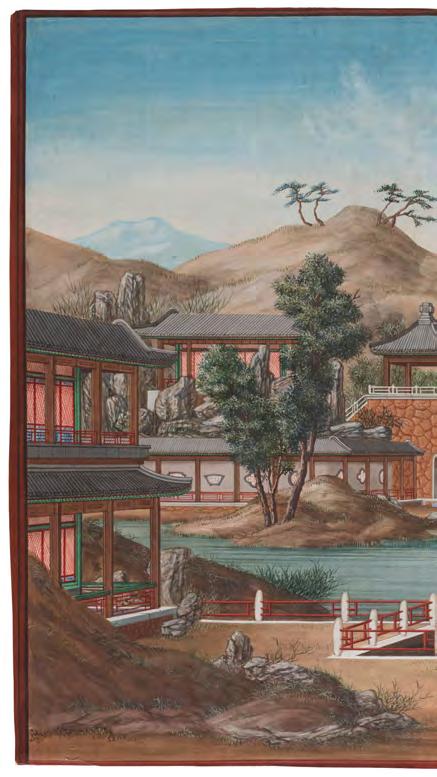


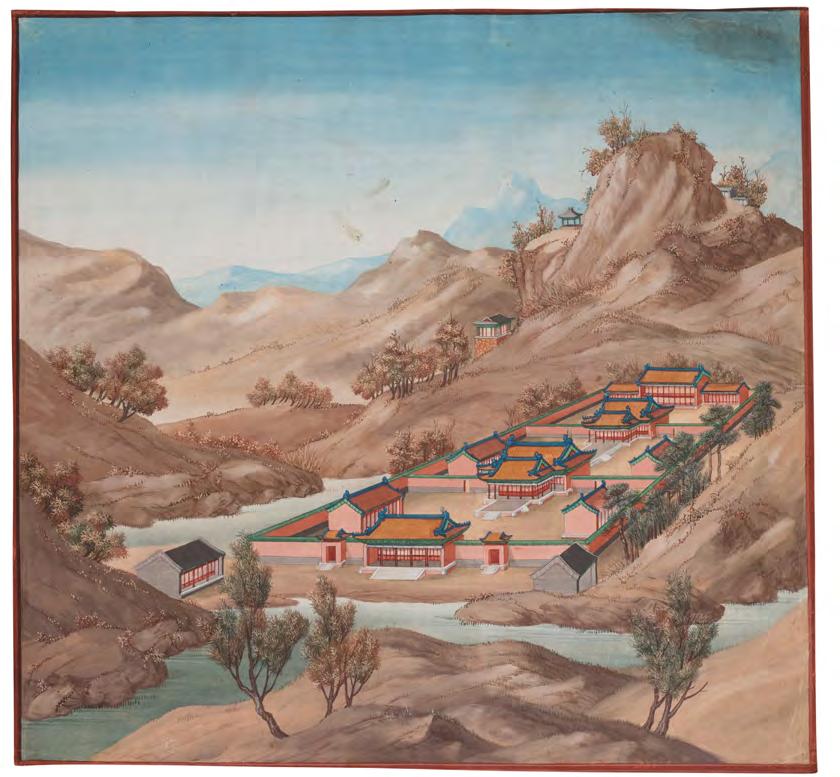





1213. A set of four Chinese lacquer panels with wooden frames, early 20th century.
Finely carved and painted lacquer depicting a mountainous riverscapes.
Measure each 41 x 92 cm. Measure with wooden frame each 50.5 x 102 cm.
Provenance: From the Collection of Ann Felton. Ann Felton, born in Australia. After studying medicine at Sydney University, Ann was discovered in 1958, and became one of the worlds top models, with legendary images taken by Helmut Newton. She worked for the Ford agency. These panels were purchased when she lived in Hong Kong in the 1960’s, where her husband worked.
Estimate: SEK 10 000 – 15 000 / EUR 860 – 1 290
1214. A pair of hardstone embellished vases, mid Qing dynasty.
Baluster shape with gilded mascaron handles. Each side attractively inlaid with shaped plaques of mother-of-pearl, variegated shell, red lacquer and hardstones depicting foreigners bearing tribute. The neck with calligraphy in red against a lustrous black lacquered ground. Height 25.5 cm.
Provenance: Property of a private Swedish Estate.
Estimate: SEK 8 000 – 10 000 / EUR 690 – 860


Details of lot no 1197, 1286, 1285, 1238, 1311, 1283, 1281, 1192, 1270 and 1240.

1215. A well sculptured ‘chrysanthemum’ stone flowerpot, late Ming/early Qing dynasty. Round shape, decorated with a relief chrysanthemum flowers and foliage. Height 6.5 cm.
Provenance: Property of a private Swedish Collector.
Estimate: SEK 12 000 – 15 000 / EUR 1 030 – 1 290
1216. A set with two jade hair pins, and two sculptured jade objects. Qing dynasty or older.
Hairpins in the shape of ruyi sceptres, length 12–13 cm.
Sculptured objects, length 6.6–13.2 cm.
Provenance: Property of a private Swedish Collector.
Estimate: SEK 8 000 – 10 000 / EUR 690 – 860


1217. A Chinese nephrite brush washer, 20th century.
Sculptured as a boy and a feline animal carrying a tray, on the edge of the tray there is two birds and two butterflies. Length 15 cm.
Provenance: Property of a private Swedish Collector.
Estimate: SEK 8 000 – 10 000 / EUR 690 – 860
1218. A nephrite plaque, Qing dynasty.
Oval, decorated with bamboo, lingzhi and flowers. Measure ca 11.5 x 10 cm. Height with wooden stand 14 cm.
Provenance: Property of a private Swedish collector.
Estimate: SEK 5 000 – 7 000 / EUR 430 – 600

1220. A Chinese silver and green stone bracelet and a pair of earrings, early 20th century.
Bracelet, length 18.5 cm. Height of earrings 2 cm.
Estimate: SEK 6 000 – 8 000 / EUR 520 – 690


1219. A large belt buckle, gilded copper and hardstone, Qing dynasty.
Modelled after the stones shape, the reverse decorated with a floral scroll. Measure 6.2 x 5.4 x 2.5 cm.
Provenance: Property of a private Swedish collector.
Estimate: SEK 4 000 – 6 000 / EUR 350 – 520

1221. A gilded silver bracelet with stone inlay, late Qing dynasty.
Width approximately 1.5–3.5 cm, length approximately 17 cm.
Weight 38 g. Silk clad case accompanies the piece, measure 23 x 6.5 x 3 cm.
Provenance: Property of a private Swedish collector.
Estimate: SEK 3 000 – 3 500 / EUR 260 – 300

1224. A group of Chinese pewter wares, Qing dynasty. (4 pieces).
Comprising: a tea caddy with cover, height 17 cm; a tea caddy with cover, height 9.5 cm; a sugar bowl with cover, length 13 cm; a three tiered heater, height 10 cm.
Provenance: From the Collection of Karl Viktor Rudin. Thence by descent.
Estimate: SEK 4 000 – 6 000 / EUR 350 – 520

1222. Withdrawn.
1224. An ink cake, Qing dynasty.
Decorated with a riverscape with tall mountains, a bridge and pagodas, the reverse with a buffalo in a landscape with a tree and calligraphy. Part gilt and painted. Measure 12x12 cm.
Estimate: SEK 4 000 – 6 000 / EUR 350 – 520

1225. A ‘Chinese Export’ silver tripod bowl with cover, probably Tu Mao Xing, around 1900.
Ovoid shape with a peach finial, the tripod feet with claw and ball, mounts depicting mythological beasts. Hammared hexagonal pattern with cartouches of birds, pommes granates, prunus and bamboo. Swedish import marks. Height 16 cm. Weight 339 g.
Provenance: From the private collection of a Swedish family in Närke. The couple has a keen interest in art and antiques and started to collect in the 1960’s, attending auctions, antique shops, and antique fairs. Always seeking additional pieces that would adorn their home and that intrigued them with its quality and history.
Literature: Compare to Christie’s Interiors auction 5700 lot 25 11 May 2020.
Estimate: SEK 4 000 – 6 000 / EUR 350 – 520
1226. A set of six silver cups with holders, China, 20th century.
With makers mark to base. Flower shaped cup holder, diameter 7.5 cm. Diameter of cup 5 cm.
Provenance: From the Collection of Monica och Karl-Erik Öhman, thence by descent.
Estimate: SEK 4 000 – 6 000 / EUR 350 – 520

1228. Two books by Carl Peter Thunberg, ‘Resa uti Europa, Africa, Asia förrättad åren 1770–1779’, part 1–4.
C. P. Thunberg’s 4-volume account of his travels to Southern Europe, Africa, Java, Japan, Ceylon etc. in 1770–1779. Printed in Uppsala, at directeur Joh. Edman 1788–91, and 1791. Half calf gilt. Measure each volume 12 x 18 x 4 cm.
Provenance: From a private Swedish collector, the family lived in Japan in the mid 1950’s were the father was employed in the Gadelius firm.
Estimate: SEK 5 000 – 7 000 / EUR 430 – 600


1227. Edgar Gorer and J.F. Blacker, ‘Chinese Porcelain and Hard Stones’, vol. I and II.
Publ. Bernhard Quartich, 11 Grafton Street, New Bond Street, W. London 1911. Two volumes; limited edition of 1000 copies, this is no 130.
Provenance: From the Collection of James Keiller, thence by descent.
Estimate: SEK 12 000 – 15 000 / EUR 1 030 – 1 290

1229. A Junyao purple-splashed blue glazed bowl. Song dynasty or later.
Rounded sides, on a short unglazed footrim, four purple splashes to the interior, and one to the exterior. Diameter 21 cm.
Provenance: Property of a private Swedish Collector, purchased from Antik West.
Estimate: SEK 15 000 – 20 000 / EUR 1 290 – 1 720
1230. A carved ‘Yazohou’ bowl, Song dynasty (960–1279).
The deep rounded sides rising from a short straight foot to an everted rim, freely carved to the interior with stylized floral medallion, the exterior carved with elongated overlapping lotus-petals, covered over all in an olive-green glaze. Diameter 10.7 cm.
Provenance: Purchased at Bukowskis, 2014, December lot no 43. Then from “The Collection of a Swedish Connoisseur, Stockholm see lot no 1–102.” The collection is a study collection, accumulated during a lifetime. The collector operated within the field of oriental works of art. Due to his knowledge and sense of quality he was of great help to many of the members on Kinaklubben (The China Club) with members such as the Swedish Crown Prince Gustav Adolf, Emil Hultmark and Carl Kempe. The collection is mainly acquired in Sweden and London. Prior to that from the Collection of Orvar Karlbeck (1879-1967), a handwritten card describing the object, and dated Stockholm 5 March 1946 enclosed.
Estimate: SEK 12 000 – 15 000 / EUR 1 030 – 1 290
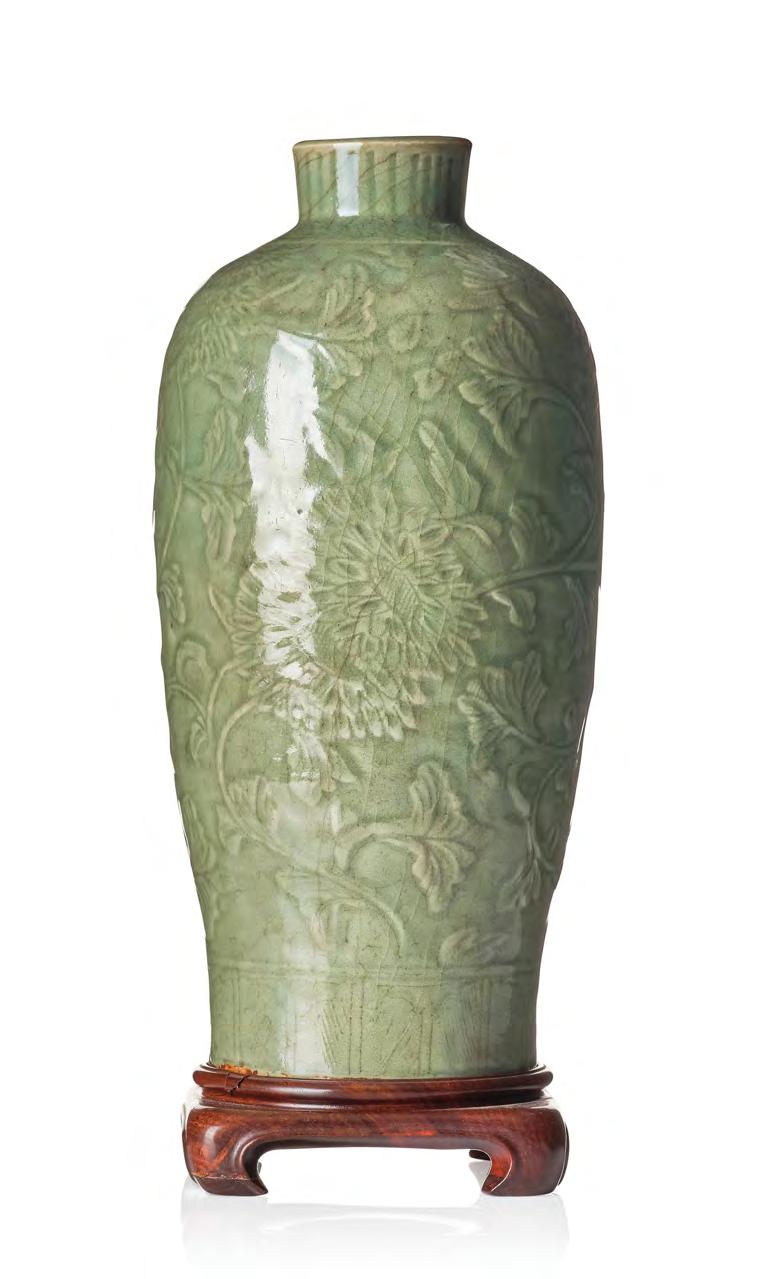

1231. Withdrawn.
1232. A carved celadon ‘longquan’ vase, Yuan/Ming dynasty.
A high-shouldered body, with a straight neck tapers to a slightly spreading foot, and is carved with a wide band of chrysanthemum scroll, all under a glaze of soft olive-green tone. Height 34.5 cm. Height with wooden stand 37.5 cm.
Provenance: From the Collection of Monica och Karl-Erik Öhman, thence by descent.
Exhibitions: Compare with vases of this type in the Musee Guimet, no. G 3594. G 4646.
Estimate: SEK 30 000 – 50 000 / EUR 2 570 – 4 280

1233. A blanc de chine tea pot with cover, Qing dynasty, Kangxi (1662–1722).
Pommegranate shaped, decorated in relief and with Chinese characters to the side. Length 12.5 cm.
Estimate: SEK 3 000 – 4 000 / EUR 260 – 350

1234. A massive ‘blanc de chine’ basin, Qing dynasty, 18th century. With a 滄亭清玩 ‘cang ting qing wan’ mark.
The four character mark can be translated as ‘the pure trinket of the Cang Pavilion’. Archaistic decoration in relief. Diameter 63.5 cm. Height 49 cm.
Provenance: From the Alströmer family Collection at Östad Säteri, Västergötland, Sweden, thence by descent. From the Collection of Patrick Alströmer (1733–1804). The massive piece can be traced back to the estate inventory of Patrick Alströmer. Mr Alströmer was a Swedish noble man and famous industrialist of the 18th Century. The family had business in Alsingsås, and in Russia. His brother Claes Alströmer was a merchant in Gothenburg and a well known botanist as well as married to Niclas Sahlgrens daughter. Patrick held a number of offices such as kommersråd 1770, landshövding 1774. Director of the Swedish East India Company 1777. He and his brother were introduced in 1778. He founded the Musical Academy and was a member of the Royal Swedish Academy of Sciences. His brother Claes Alströmer worked with Carl von Linne and sailed on the east -india men to gather information on plants. Claes was also married to Niclas Sahlgrens daughter.

Exhibitions: Compare with a smaller vessel, sold at Sothebys, Important Chinese Art 23 March 2022. lot 326. Compare also with a vase in the collection of Musee Guimet, Paris with this type of archaistic bronze patterns in blanc de chine. G 1648.

Literature: Depicted online is the inventory of the Estate of Mr Patrik Alströmer, dated 1804. Then listed as in good condition. In the inventory in 1892, after Jonas Alströmer (1807–1891) it is listed again.
Estimate: SEK 75 000 – 100 000 / EUR 6 430 – 8 570
1235. A large dehua/blanc de chine lotus bowl, late Qing dynasty/early 20th century.
The lotus shaped bowl is applied with lotus buds, pods and leaves around the exterior with incised details, and covered in a creamy-white glaze. Diameter 20 cm. Height 11.5 cm.
Provenance: From a private Swedish Collector. Marked with a label from Erik Holmberg Collection. To see other lots sold from the Erik Holmberg Collection, see Bukowskis sale 617.
Exhibitions: Compare similar sold at Christies, Live Auction 12033 Chrisites Interiors, lot 36. Compare also, Sothebys, Fine Chinese Ceramics and Works of Art /11 November 2015, London, Lot 146.
Estimate: SEK 6 000 – 8 000 / EUR 520 – 690
Patrick Alströmer
1236. A ‘powder blue’ jar with cover, Qing dynasty, Qianlong (1736–95).
Of baluster shape with doomed cover and decorated with a riverscape in gold. Height 30.5 cm.
Provenance: Property of a private Swedish Estate.
Estimate: SEK 18 000 – 20 000 / EUR 1 550 – 1 720


1237. A pair of powder blue and gold ‘trumpet’ vases, Qing dynasty, 18th century.
Trumpet shape, decorated with riverscapes in gold. Height 26 cm.
Provenance: Property of a private Swedish Collector.
Estimate: SEK 8 000 – 10 000 / EUR 690 – 860
1238. A midnight blue glazed vase, Qing dynasty with Chenghua mark.
Pear shaped vase that rises from a short slightly tapering footrim, and ends with a bulb shaped neck. Height 13 cm.
Provenance: Property of a private Swedish Collector.
Estimate: SEK 12 000 – 15 000 / EUR 1 030 – 1 290


1239. A vase mounted as a lamp, 17th century. Pear shaped with an elongated neck, decorated in the enamels green, red and yellow. Height vase 32.5 cm. Height with wooden stand and shade 63.5 cm.
Provenance: Property of a private Swedish Estate.
Estimate: SEK 4 000 – 6 000 / EUR 350 – 520


1240. An ‘egg and spinach’ glazed figure of a mythical beast, Qing dynasty, Kangxi (1662–1722).
A reclining mythical beast glazed in yellow, white, green and aubergine. Length 9 cm.
Provenance: From the collection of a Scandinavian nobleman, who had a long diplomatic career starting, in the 1920s as a young attache in China, later on as ambassador in China.
Exhibitions: To see other items sold from this collection see Bukowskis Spring Auction Sale 649, lot 985–1019.
Estimate: SEK 5 000 – 7 000 / EUR 430 – 600

1241. A sleeve vase, 17th century, Transition/Kangxi. Tall with a waisted neck and flared brownglazed rim. The vase is decorated with different bands with floral and ruyi patterns in red and green enamels. Height 38 cm.
Estimate: SEK 10 000 – 15 000 / EUR 860 – 1 290
1242. A set of three famille verte dishes, Qing dynasty, Kangxi (1662–1722).
Almost leaf shaped, lobed, decorated in famille verte with chrysanthemum and peonies. Length 23.2 cm.
Provenance: Property of a private Swedish Collector.
Estimate: SEK 8 000 – 10 000 / EUR 690 – 860


1244. A large famille verte serving dish, Qing dynasty, 18th century.
Decorated in the famille verte palette, with pine tree, bamboo, peonies, chrysanthemum and lingzhi fungus. Diameter 39.5 cm.
Provenance: Private Swedish Collection.
Estimate: SEK 6 000 – 8 000 / EUR 520 – 690
1243. A pair of famille verte dishes. Qing dynasty, Kangxi (1662–1722).
Decorated with butterflies and flowers. Diameter approx. 16 cm.
Provenance: Property of a private Swedish collector.
Estimate: SEK 4 000 – 6 000 / EUR 350 – 520

1245. An imperial yellow glazed two handled wine cup, Qing dynasty, Kangxi mark and of the period (1662–1722).
With ‘Da Qing Kangxi nian zhi’ mark. Finely potted with an incised decoration of two five clawed dragons amidst cloud formations. Diameter cup 5.7 cm. Length cup handle to handle 7.1 cm.
Provenance: Property of a private Swedish collector who received it as a gift from the parents in law in the 1990’s.
Exhibitions: Compare cups of this style, at Christies, 24 march 2004, Auction 1354. Fine Chinese Ceramics and Works of Art. Lot no 222. Compare also a similar cup in the Musee Guimet, Paris, G 5831. Compare also a cup like this in the British Museum, Museum number PDF,A.593.
Estimate: SEK 20 000 – 25 000 / EUR 1 720 – 2 140


1246. Withdrawn.

1248. A three-piece famille rose garniture, Qing dynasty, Qianlong (1736–95).
Of baluster shape, decorated in famille rose with figure scenes from court life and scattered flowers. Height 32 cm.
Provenance: Property of a private Swedish Estate.
Estimate: SEK 6 000 – 8 000 / EUR 520 – 690
1247. A large imari charger, Qing dynasty, 18th century. Decorated in imari colours depicting a jardiniere with flowers.
Diameter 38.5 cm.
Estimate: SEK 6 000 – 8 000 / EUR 520 – 690


1250. A famille rose ‘Chinese Export’ wine cooler, Qing dynasty, Qianlong (1736–95).
Enamelled on each side with a lattice-fenced peony garden, the large pink blooms growing from blue rockwork, all between iron-red lion mask handles and beneath a molded iron-red diaper border. Diameter 20.5 cm. Height 16.5 cm.
Exhibitions: Compare a wine cooler of this model sold at Christies, lot 256, 23 January 2001, Live auction 9724. Chinese Export.
Estimate: SEK 10 000 – 15 000 / EUR 860 – 1 290
1249. A famille rose ‘lotus bowl’, Qing dynasty, 18th century.
Deep rounded sides, short straight wide foot rim. The exterior decorated in relief with a continuous lotus pattern, the interior with birds in a garden in full bloom. Diameter 12 cm.
Estimate: SEK 4 000 – 6 000 / EUR 350 – 520


1251. A famille rose jar, Qing dynasty, 18th century.
Ovoid shape with an unglazed rim, decorated in famille rose with a garden in full bloom, magnolia, peonies, etc. Height 26 cm.
Provenance: Property of a private Swedish collector.
Estimate: SEK 8 000 – 10 000 / EUR 690 – 860

1253. A Swedish Armorial dish, Qing dynasty, Yongzheng (1723–35).
Decorated with the arms acollé of the Swedish noble families von FersenWachtmeister. Diameter 32.5 cm.
Provenance: The arms of von Fersen - Wachtmeister. The service commissioned by the Lieutenant Colonel and President of the Svea Court of Appeal Hans von Fersen (1684–1748) and his wife Eleonora Margareta Wachtmeister af Mälsåker (1684–1748), who married in 1715. Owner of the estates Ljung and Steninge in Husby socken as well ass Granhammar, Tibble and Gäddgården in Arboga Socken. Eleonora Margareta Wachtmeister of af Mälsåker was one of the investors in the Swedish East India Company’s first oktroj. From the decoration and the fact that Hans passes away in 1736 it is clear that the service was brought back on one of the Swedish East India Company’s first expeditions.
Estimate: SEK 10 000 – 15 000 / EUR 860 – 1 290
1252. A famille rose and grisaille armorial punch bowl, Qing dynasty, 18th century.
The interior is decorated in grisaille with finger lemon and peaches. The exterior decorated with floral sprigs alternating with coat of arms. Diameter 28 cm.
Provenance: English armorial coat of arms.
Estimate: SEK 12 000 – 15 000 / EUR 1 030 – 1 290


1254. A pair of green, yellow and aubergine glazed biscuit figures of recumbent horses, Qing dynasty, 18th century.
The horses depicted resting. Length 10 cm. Height 9.5 cm.
Provenance: Property of a private Swedish collector.
Estimate: SEK 20 000 – 30 000 / EUR 1 720 – 2 570

1255. A pair of Swedish armorial dishes, Qing dynasty, 18th century.
Decorated in famille rose with the coat of arms of the Swedish noble family Vult von Steiern. Diameter circa 22.5 cm.
Provenance: Vult von Steijern, no 1889. Most likely commissioned by John Julius Vult, knighted Vult von Steijern (1695–1767).
Estimate: SEK 6 000 – 8 000 / EUR 520 – 690

1256. A pair of famille rose wine coolers, Qing dynasty, Qianlong (1736–95).
After a European faience model, decorated with flowers and garlands. Height 16.5 cm. Length 26 cm.
Provenance: Previously in the collections at Torup Castle, Bara parish, Skåne.
Estimate: SEK 20 000 – 25 000 / EUR 1 720 – 2 140
1257. A famille rose ‘Hörholdt’ charger, Qing dynasty, Qianlong (1736–95).
Decorated with a central scene from the pearl river, around the rim a decoration type imitated from Meissen, Hörhold. Diameter 39 cm.
Provenance: Property of a private Swedish collector.
Estimate: SEK 12 000 – 15 000 / EUR 1 030 – 1 290


1259. A Chinese Export famille rose ‘hunting’ bowl, Qing dynasty, Qianlong (1736–95).
Rounded sides, decorated to the interior with a medallion with a scene of a European gentleman with his hounds. Around the exterior a vivid scene depicting a hunt. Diameter 28.5 cm.
Estimate: SEK 18 000 – 20 000 / EUR 1 550 – 1 720

1261. A famille rose tureen with cover, Qing dynasty, Qianlong (1736–95).
Octagonal shape, finial in the shape of rabbits head, acanthus finial, decorated in famille rose colours with flowers in a garden setting. Length tureen 35 cm. Length tureen stand 37 cm.
Provenance: Property of a private Swedish collection.
Estimate: SEK 20 000 – 25 000 / EUR 1 720 – 2 140
1258. A famille rose ‘European Subject’ dish, Qing dynasty, Qianlong (1736–95).
Decorated in famille rose after a Meissen subject.
Diameter 27.5 cm.
Provenance: Property of a private Swedish collector.
Estimate: SEK 4 000 – 6 000 / EUR 350 – 520

1260. A Chinese Export grisaille cup, 18th century. ‘Posfeleyn VerKoopeing’.
Decorated in grisaille, presumably after a print, with two persons engaging in the sale of porcelains, in the background an exotic port environment. Height 6.8 cm. Diameter 7.7 cm.
Estimate: SEK 18 000 – 20 000 / EUR 1 550 – 1 720

1262. A ‘Chinese Export’ service, Qing dynasty, Jiaqing (1796–1820). (10 pieces).
Decorated in blue enamels and gold with carnations and enamel bands. Comprising: six custard cups with covers, height 9.5 cm, a sauce boat, length 19 cm, a chestnut basket with stand, height 14.5, length 28 cm, a serving dish, 20 x 17.5 cm, a round serving dish, diameter 26 cm.


Provenance: Property of a private Swedish collector.
Estimate: SEK 8 000 – 10 000 / EUR 690 – 860
1263. A famille rose ‘Chinese Export’ jar with cover, Qing dynasty, Qianlong (1736–95).
After a Swedish Marieberg faience model, decorated with bands and garlands in bright enamels. Height 38 cm.
Estimate: SEK 12 000 – 15 000 / EUR 1 030 – 1 290
1264. A set of two iron red and gold sauce boats, Qing dynasty, Qianlong (1736–95).
After a European silver model, decorated with flowers. Length 23.5 cm.
Provenance: Property of a private Swedish collection.
Estimate: SEK 8 000 – 10 000 / EUR 690 – 860

1265. An underglaze blue and famille rose tureen with cover, Qing dynasty, Qianlong (1736–95).
Round silver shape with upturned handles, decorated in famille rose with a motif of an elegant lady with a deer in a palace garden. Height 29.5 cm. Length 28 cm.
Estimate: SEK 12 000 – 15 000 / EUR 1 030 – 1 290


1266. A part famille rose ‘Chinese Export’ service, Qing dynasty, Jiaqing (1796–1820).
Decorated in famille rose and gold. Comprising: two serving dishes, length 36.5 cm; two vegetable tureens with covers, length 29 cm; two leaf shaped dishes, length 25.5 cm.
Estimate: SEK 10 000 – 15 000 / EUR 860 – 1 290

1267. A ‘Chinese Export’ tea service, Qing dynasty, 18th century. Decorated with landscape scenes. Comprising: a tea pot with cover, height 21.5 cm; a milk jug, height 13 cm; six cups, diameter 8.5 cm; eight cups with an ear, height 6.7 cm; seven dishes (1+1+5) diameter 14.5–20 cm.
Estimate: SEK 12 000 – 15 000 / EUR 1 030 – 1 290

1268. A ‘European Subject’ punch bowl, Qing dynasty, Jiaqing (1796–1820).
Decorated in coral red and gold with a broad panel with leaves against gold around the rim above two roundels with European buildings in a landscape setting. Diameter 28.5 cm.
Estimate: SEK 6 000 – 8 000 / EUR 520 – 690
1269. A five clawed dragon bowl, Qing dynasty with Kangxi six character mark.
The delicately potted exterior finely incised with a pair of aubergine coloured sinuous dragons in pursuit of a flaming pearl hovering over crashing waves amid wispy clouds, all against a green ground. Diameter approx. 10 cm.
Provenance: Property of a private Swedish collector born in 1915, who was a Swedish artist inspired by Asian art. Thence by descent.
Exhibitions: Compare with Christies, lot no 772, 19 March 2009. Fine Chinese Ceramics & Works of Art Including Jades from the Fine Arts Museums of San Francisco. Compare also to lot 1002 at Bukowskis Important Spring Sale 633.
Estimate: SEK 6 000 – 8 000 / EUR 520 – 690
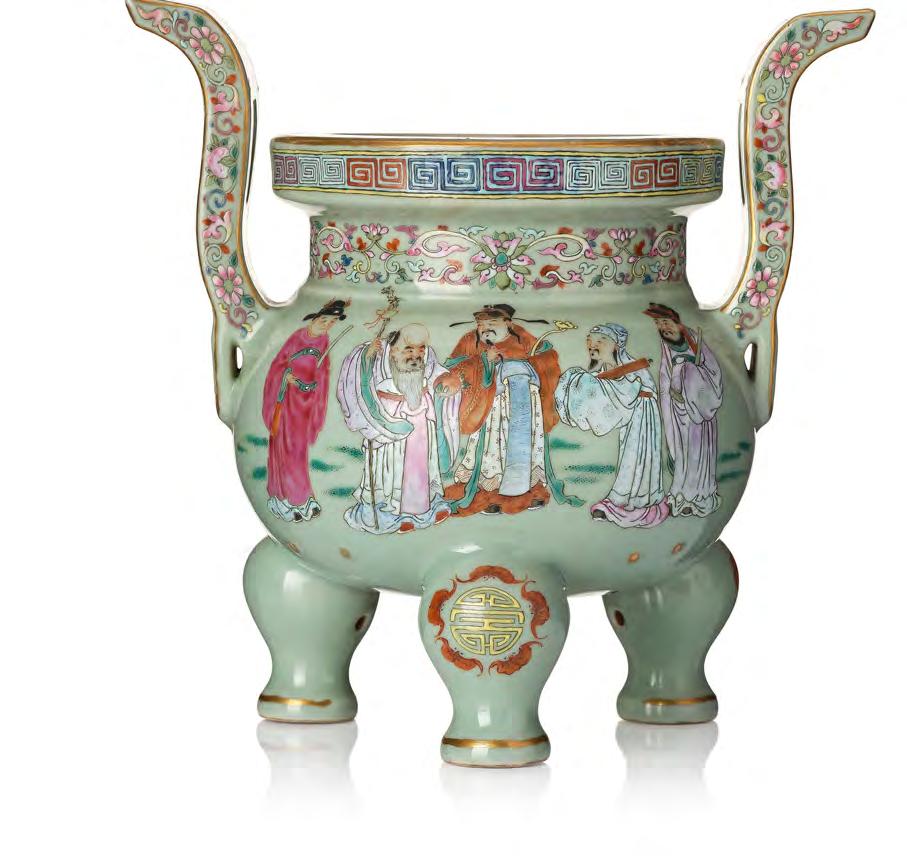


1270. A famille rose tripod censer, Qing dynasty with Qianlong mark.
A tripod with upturned handles, decorated in famille rose with sholau and a group of scholars on one side, the other side with two boys, decorated also around the neck and on the handles with a lotus scroll, the legs with shou characters and bats. Height 24 cm. Length 24 cm.
Provenance: Property of a private Swedish collector.
Estimate: SEK 30 000 – 50 000 / EUR 2 570 – 4 280
1271. A famille rose roleau vase, late Qing dynasty. Classic roleau shape, with a waisted neck and a gilded rim. Decorated with a large central scene with an elegant lady with her entourage. Height 46.5 cm.
Estimate: SEK 20 000 – 25 000 / EUR 1 720 – 2 140
1272. A famille rose jardinere, Qing dynasty with seal mark.
Rectangular shape, decorated with figure scenes with boys playing in a garden that runs around the piece. Rim with blue meander decoration. Qianlong mark to base in red. Measure 25 x 16 cm. Height 9.5 cm.
Provenance: Property of a private Swedish collector.
Estimate: SEK 8 000 – 10 000 / EUR 690 – 860


1273. A famille rose Canton tea pot, Qing dynasty, 19th century.
Decorated in famille rose colours with figure scenes from court life alternating with panels with calligraphy. Height handle up 17 cm.
Provenance: Property of a private Swedish collector.
Estimate: SEK 2 500 – 3 000 / EUR 220 – 260

1275. A famille verte vase, late Qing dynasty, circa 1900. With a Chenghua mark in underglaze blue within double circles. Octagonal shape, decorated in famille verte with alternating elegant ladies, alternating landscapes and garden scenes. Height 40.5 cm.
Provenance: Property of a private Swedish collector.
Estimate: SEK 15 000 – 20 000 / EUR 1 290 – 1 720

1274. A barrel shaped Canton garden seat, Qing dynasty, 19th century.
Octagonal barrel shape with pierced sides and top. Decorated in famille rose colours with a figure scene set in a garden, alternating with birds, cashe pattern and tassels. Height 49 cm.
Provenance: From the Collection of Heidi Boyce Broström (1943–2022) and Dan Axel Broström (1915–1976). Dan Axel Broström was the thirdgeneration ship-owner in the prestigious Broström Company group. When he took over the firm in 1949 they had 18 000 employees. The Canadian model and geologist Heidi was Dan-Axel Broströms third wife, the couple lived at the fashionable Särö, a few miles south of Gothenburg.
Estimate: SEK 20 000 – 25 000 / EUR 1 720 – 2 140

1276. An enamelled brush pot, Qing dynasty, 19th century.
Decorated with scholars and antiques and precious objects. Height 14 cm. Diameter 12.4 cm.
Provenance: From the private collection of a Swedish family in Närke. The couple has a keen interest in art and antiques and started to collect in the 1960’s, attending auctions, antique shops, and antique fairs. Always seeking additional pieces that would adorn their home and that intrigued them with its quality and history.
Estimate: SEK 4 000 – 6 000 / EUR 350 – 520
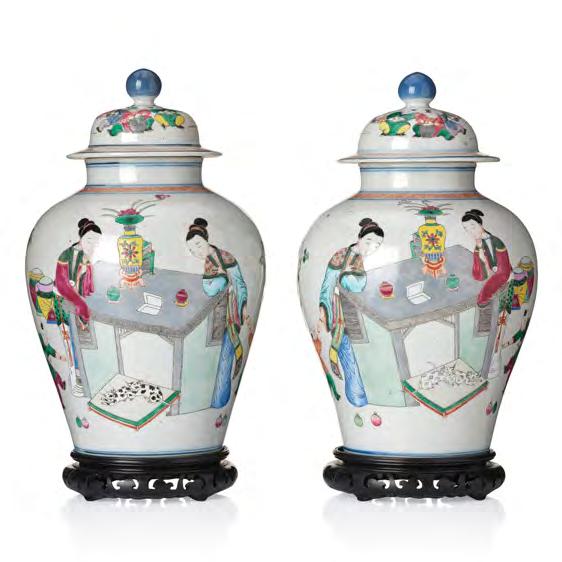

1277. A pair of famille rose ‘ladies and boys’ vases with covers, late Qing dynasty.
Of baluster shape, decorated with two elegant ladies of the court surrounded by boys, antiques and flowers. Height 41 cm. Height including wooden stand 46 cm. Height with mount as a lamp and wooden stand 54 cm.
Provenance: From the Collection of Heidi Boyce Broström (1943–2022) and Dan Axel Broström (1915–1976). Dan Axel Broström was the thirdgeneration ship-owner in the prestigious Broström Company group. When he took over the firm in 1949 they had 18 000 employees. The Canadian model and geologist Heidi was Dan-Axel Broströms third wife, the couple lived at the fashionable Särö, a few miles south of Gothenburg.
Estimate: SEK 12 000 – 15 000 / EUR 1 030 – 1 290
1278. A large famille verte fish basin, Qing dynasty, 19th century.
Rounded sides with a waisted rim, decorated to the interior with fish and sea weed, the exterior well painted with a scene from court life with an official, attendants and soldiers. Height 29.5 cm. Diameter 36 cm.
Provenance: Property of a private Swedish Estate.
Estimate: SEK 6 000 – 8 000 / EUR 520 – 690



1279. A large jardiniere, late Qing dynasty.
Hexagonal shape, decorated with figure scenes in the famille verte palette. Diameter 35 cm. Height 28 cm.
Provenance: Property of a private Swedish collector.
Estimate: SEK 8 000 – 10 000 / EUR 690 – 860

1280. A pair of five clawed dragon bowls on stands and a cover, Qing dynasty, Daoguang mark and period (1821–50).
Decorated with five clawed dragons chasing the flaming pearl. Diameter 11 cm.
Provenance: Property of a private Swedish collector.

Estimate: SEK 8 000 – 10 000 / EUR 690 – 860
1281. A famille rose vase, late Qing dynasty/Republic with Qianlong mark.
Of baluster shape with a slightly flared rim and handles in the shape of stylized dragons. The vase decorated with elegant ladies dancing, playing instruments and spending time in a garden setting. The interior of the vase and the base glazed in a turquoise glaze and the base with an apocryphal Qianlong sixcharacter seal mark. Height 28 cm.
Provenance: Property of a private Swedish collection.
Estimate: SEK 20 000 – 30 000 / EUR 1 720 – 2 570

1282. A famille rose dish, Qing dynasty with Tongzhi mark and period (1862–74).
Rounded sides, on a short footrim. Decorated in bright enamels with cherry blossom, peonies and fruits. Diameter 15.2 cm.
Estimate: SEK 6 000 – 8 000 / EUR 520 – 690




1283. A coral red reverse decorated floral bowl, seal mark of Daoguang, Republic, 20th century.
Potted, with deep rounded sides rising from a short foot to an everted rim, delicately reverse-decorated in a rich iron-red with a row of peony heads alternating with smaller lotus above a row of lotus blossoms, all borne on interlocked foliate scrolls reserved in white against the opaque coral ground, the interior left undecorated, the white base inscribed in underglaze blue with a six-character seal mark. Diameter 13 cm.
Provenance: From the Collection of Dentist Inga Körner Johnsson (1909–1993), thence by descent.
1282A. A famille rose ‘mag-pies and prunus’ vase, late Qing dynasy/Republic with Yongzheng mark.
Elegantly potted with a globular body surmounted by a tall cylindrical neck, the exterior brightly painted with magpies amongst flowering prunus trees and other flowers. Height 19 cm.
Provenance: Property of a private Swedish collector.
Estimate: SEK 6 000 – 8 000 / EUR 520 – 690


Exhibitions: Another bowl from this collection was sold at Bukowskis, auction 629, lot no 821. Compare with a similar bowl at the British Museum, Museum number PDF,B.709.
Estimate: SEK 12 000 – 15 000 / EUR 1 030 – 1 290

1284. A celadon-glazed ‘trigram’ vase, late dynasty/early 20th century with Qianlong mark.

Of archaistic cong form, the straight sides moulded on each side with eight trigrams arranged in two columns, surmounted by a tapered neck and lipped rim, all supported on a tapered foot, applied overall with a celadon glaze, the base inscribed in underglaze blue with a six-character reign mark. Height 20 cm.
Estimate: SEK 8 000 – 10 000 / EUR 690 – 860
1285. A sang de boeuf glazed vase, Qing dynasty with Xuande mark.
Drop shaped with a tall slightly flared neck and a red sang de boeuf glaze. Height 18 cm.
Provenance: From the collection of a Scandinavian nobleman, who had a long diplomatic career starting, in the 1920s as a young attache in China, later on as ambassador in China.
Exhibitions: To see other items sold from this collection see Bukowskis Spring Auction Sale 649, lot 985–1019.
Estimate: SEK 5 000 – 7 000 / EUR 430 – 600

1287. A set of two flambé glazed table lamps/vases, Qing dynasty, 19th century.
Of baluster shape with flambéglaze. Height vase 35–38 cm.
Height with mount as a lamp 73.5 cm.
Estimate: SEK 6 000 – 8 000 / EUR 520 – 690


1286. A Chinese peach bloom double gourd vase, Qing dynasty. Of double gourd shape, glazed in green, red and bluish tinted peachbloom glaze. Height 19 cm.
Provenance: From the collection of a Scandinavian nobleman, who had a long diplomatic career starting, in the 1920s as a young attache in China, later on as ambassador in China.
Exhibitions: To see other items sold from this collection see Bukowskis Spring Auction Sale 649, lot 985–1019.
Estimate: SEK 8 000 – 10 000 / EUR 690 – 860

1288. A flambé glazed brush washer, late Qing dynasty. Round on a short footrim, decorated in a vivid flambé glaze.
Diameter rim 8.5 cm. Diameter widest part 12 cm. Height 4 cm.
Wooden stand accompanies the piece.
Provenance: From a private Swedish collector, the family lived in Japan in the mid 1950’s were the father was employed in the Gadelius firm.
Estimate: SEK 8 000 – 10 000 / EUR 690 – 860


1289. A Japanese tripod jar/censer, 20th century. Signed. Tripod, tall shape with an inverted rim, decorated in flambé glaze.
Height 11.5 cm.
Provenance: From a private Swedish collector, the family lived in Japan in the mid 1950’s were the father was employed in the Gadelius firm.
Estimate: SEK 4 000 – 6 000 / EUR 350 – 520
1290. A clair-de-lune-vase, late Qing dynasty/ early 20th century.
The broad body tapers towards the waisted neck with flared rim, shoulder with mask-and-ring handles, covered in a clairde-lune-blue glaze. The base with Yongzheng mark but later.
Height 20 cm.
Estimate: SEK 6 000 – 8 000 / EUR 520 – 690


1291. A large ‘lotus bowl’, late Qing dynasty with Kangxi four character mark.
Decorated in wucai colours with a continuous lotus scroll. Diameter 22.5 cm.
Estimate: SEK 8 000 – 10 000 / EUR 690 – 860




1292. A pair of lotus dishes, Qing dynasty with Guangxu mark.
Decorated in wucai colours with a continuous lotus scroll within double circles. Diameter 23 cm.
Estimate: SEK 15 000 – 20 000 / EUR 1 290 – 1 720
1293. Two Thai Bencharong bowls, 19th century.
One decorated with deities, the other with a continuous lotus scroll. Diameter 17.5 cm.
Provenance: Property of a private Swedish collector.
Exhibitions: Compare similar bowl at the Art Institute Chicago, Credit Line A. A. Sprague Fund, Reference Number 1923.575.

Estimate: SEK 8 000 – 10 000 / EUR 690 – 860
1294. A Chinese famille rose jardiniere, Republic period, first half of the 20th century.
Round shape, flared rim, decorated in famille rose with a garden in full bloom. Height 14.5 cm. Diameter 23 cm. Height with wooden stand 20 cm.
Provenance: Property of a private Swedish collector.
Estimate: SEK 3 000 – 4 000 / EUR 260 – 350


1295. A Chinese flower pot, Republic period, 20th century. Round with a hole to the base for water drainage, decorated in famille rose colours with peonies, chrysanthemum and a large pomegranate tree. Height 16.5 cm. Diameter 23 cm.
Provenance: From the collection of Sven Johnsson who funded AB Jonax, in import firm of textile products and gloves. Mr Johnsson first came to China in the 1950’s and made several journeys to China. He soon started to collect. Mr Johnsson wrote a diary and describes what happened during the cultural revolution, how businessmen were invited to purchase antiques and works of arts from warehouses where they were gathered by the government in rule. He then decided to expand his business to Chinese porcelain and paintings.
Exhibitions: To see other sales from this collector, see Bukowskis, auction, lot no 556, lot no 1531. Bukowskis auction 649, lot no 1305. Bukowskis auction 633, lot no 1045.
Estimate: SEK 20 000 – 30 000 / EUR 1 720 – 2 570
1296. A massive famille noire charger, late Qing dynasty/early 20th century.
Decorated with a central motif with a phoenix bird in a garden in full bloom. Diameter 59 cm.
Estimate: SEK 8 000 – 10 000 / EUR 690 – 860

1297. A large vase, late Qing dynasty with Yongzheng mark.
Of tall slender model, with a waisted neck and slightly flared rim, decorated in vivid colours with mythical creatures jumping up from fierce waves, the neck decorated with double fish and peaches. Height 47 cm.
Estimate: SEK 5 000 – 7 000 / EUR 430 – 600

1298. A large famille rose dish, Qing dynasty with mark.

Decorated in famille rose with a garden in full bloom, around the rim a ‘fleur de lys’ decoration. The reverse of the rim decorated with lotusscroll and the center of the base with a seal mark in red. Diameter 37.5 cm.
Provenance: From the private collection of a Swedish family in Närke. The couple has a keen interest in art and antiques and started to collect in the 1960’s, attending auctions, antique shops, and antique fairs. Always seeking additional pieces that would adorn their home and that intrigued them with its quality and history.
Estimate: SEK 8 000 – 10 000 / EUR 690 – 860
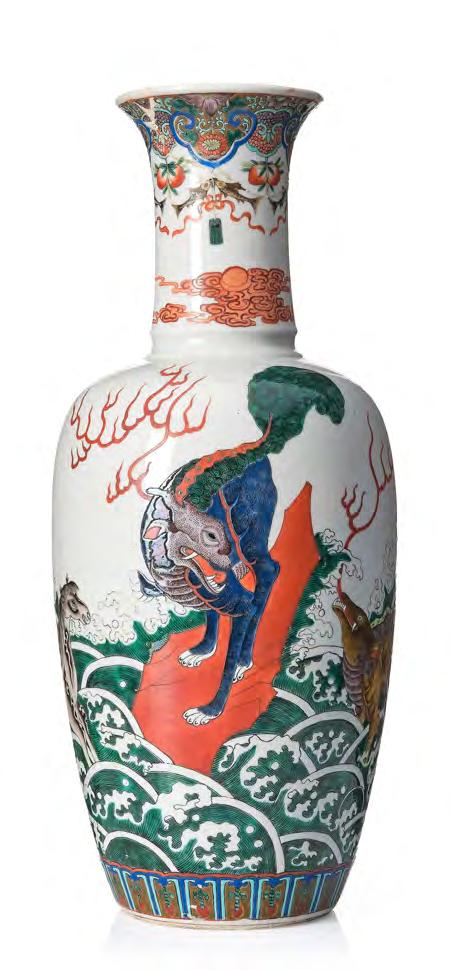

1299. A large ‘immortals’ vase, mid 20th century. Of baluster shape, decorated with ring handles, decorated in vivid colours with scenes depicting the immortals. Height 61 cm.
Provenance: Purchased in China around 1945, thence by descent within the family.
Estimate: SEK 25 000 – 30 000 / EUR 2 140 – 2 570

1300. A Chinese enamelled vase, first part of the 20th century.
Decorated in enamels with boats in a mountainous riverscape.
Marked ‘Made during the Qianlong reign’ but later. Height 7 cm.
Provenance: Property of a private collection.
Estimate: SEK 4 000 – 6 000 / EUR 350 – 520

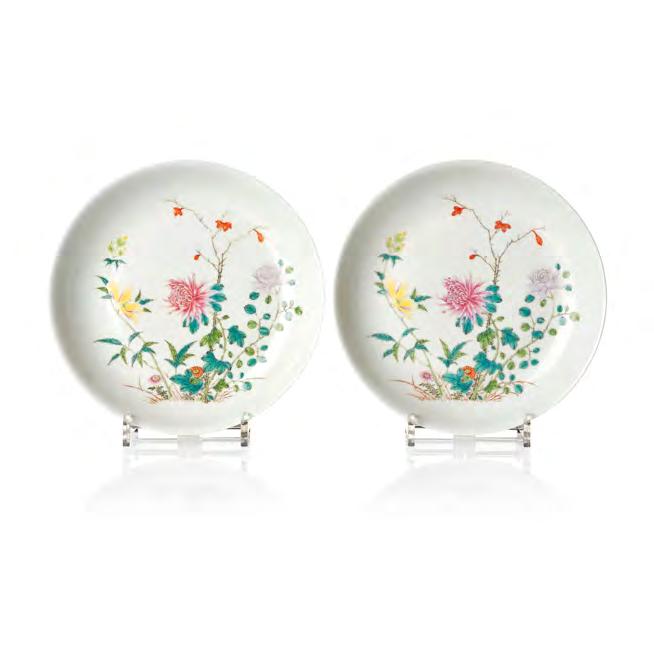

1301. A pair of porcelain dishes, China, ‘Jiangxi Ciye Gongsi’, Republic/first half of the 20th century.
Slightly flared rim decorated with enamel colours with motifs of flowers, including chrysanthemum. Diameter 24 cm.
Provenance: Property of a private Swedish collection.
Estimate: SEK 5 000 – 7 000 / EUR 430 – 600

1302. A yellow ground vase, late Qing dynasty/ early 20th Century.
Baluster shape after a bronze model with a waisted neck and flared rim, decorated with an archaistic pattern. Height 27 cm.
Provenance: Property of a Swedish lady who worked for the embassy in 19???.
Estimate: SEK 20 000 – 30 000 / EUR 1 720 – 2 570

1303. A blue and white Swatow dish, Ming dynasty (1368–1644).
Decorated with a bird in a garden. Diameter 39 cm.
Estimate: SEK 15 000 – 18 000 / EUR 1 290 – 1 550

1305. A blue and white dish, Ming dynasty, Wanli (1572–1620).
Decorated in underglaze blue, central motif with birds by a lotus pond, around the rim flowers, alternating with Buddhist emblems. Diameter 28.5 cm.
Provenance: From a private Swedish collector, the family lived in Japan in the mid 1950’s were the father was employed in the Gadelius firm.
Estimate: SEK 6 000 – 8 000 / EUR 520 – 690
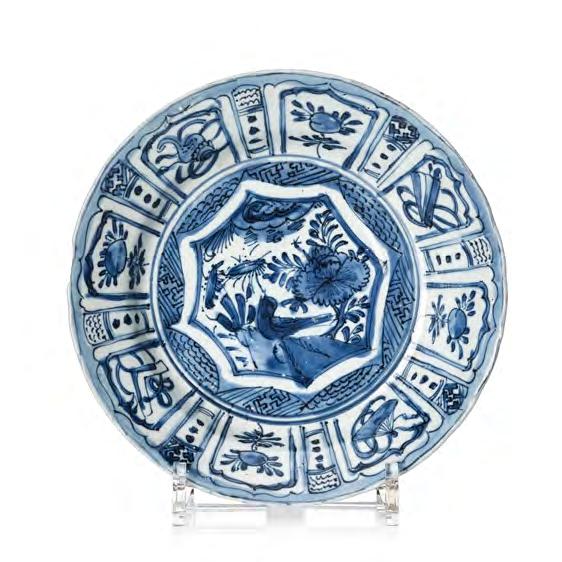
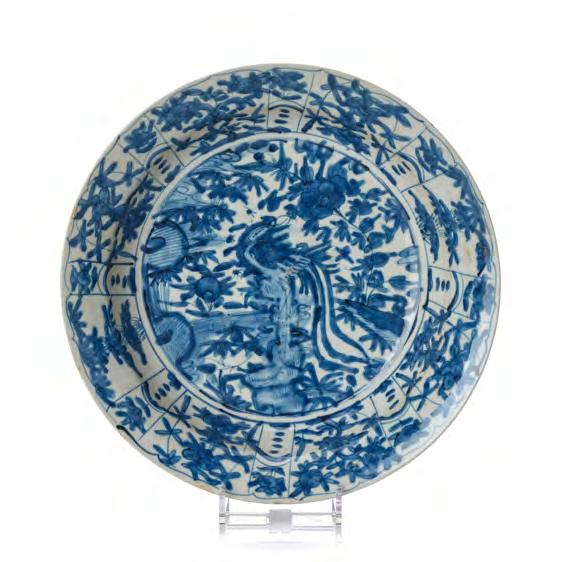
1304. A blue and white dish, Ming dynasty, Wanli (1572–1620).
Decorated in underglaze blue, central motif with a jardinier with flowers, around the rim antiques alternating with flowers. Diameter 31.5 cm.
Provenance: From a private Swedish collector, the family lived in Japan in the mid 1950’s were the father was employed in the Gadelius firm.
Estimate: SEK 8 000 – 10 000 / EUR 690 – 860
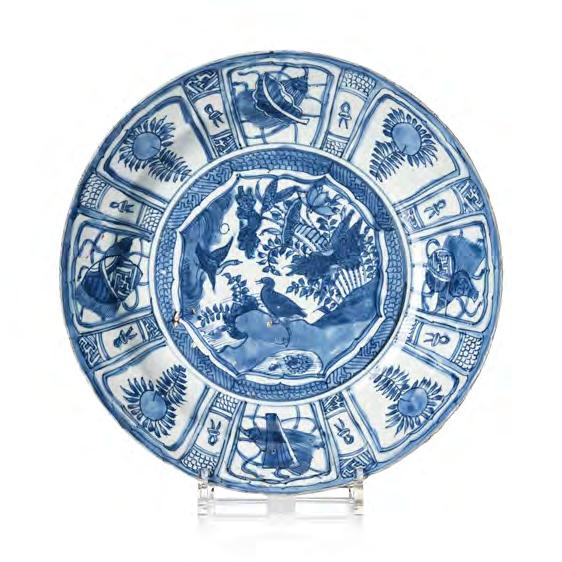
1306. A blue and white plate, Ming dynasty, Wanli (1572–1620).
Lobed, decorated in underglaze blue, central motif with a bird in a garden. Around the rim, antiques alternating with flowers. Diameter 21 cm.
Provenance: From a private Swedish collector, the family lived in Japan in the mid 1950’s were the father was employed in the Gadelius firm.
Estimate: SEK 1 500 – 2 000 / EUR 130 – 180

1307. A blue and white dish, Ming dynasty with Jiajing mark and of the period (1522–66).
Decorated in underglaze blue with four sprigs of flowers within double circles. The reverse of the rim with further eight flowers sprigs, and the base marked with Jiajing six character mark within double circle. Diameter 19.5 cm.
Provenance: From the Collection of Ebbe Helmuth Adam Berner (1894–1971), Denmark. Ebbe Berner was a Danish interior architect and worked for Danish embassies for many years. As he grew up in a Danish manor, the estate of Holstenshuus, Ebbe Berner also specialized in interior decoration of Manor houses. He was very passionate and inspired by Asian art and made numerous journeys in China from 1920s until 1940s where he acquired a large collection of Chinese art and antiques. The piece is listed in Ebbes own inventory as purchased T.Y. King, Shanghai, 202 Canton Road, in February 1937 (see photo of collectors inventory) thence by descent to the present owner.
Exhibitions: To see other items sold from this collection with Bukowskis, see sale 597, 2016, lot no 288–291. Ebbe Helmuth Adam Berner (1894–1971), Denmark. Was one of the Danish collectors who leded object to the Kopenhagen Exhibiton in 1950. ‘Kinas Kunst i Svensk og Dansk eje, det danske Kunstindustrimuseum, Kobenhamn’, 1950.
Estimate: SEK 50 000 – 75 000 / EUR 4 280 – 6 430

1308. A blue and white dish, Ming dynasty, with Xuande six character mark and of the period (1426–35).
Decor in underglaze blue with a rider. Diameter 14.4 cm.
Provenance: Purchased at Viktoria Lindström’s Antiques Shop, Stockholm 1965.
Estimate: SEK 6 000 – 8 000 / EUR 520 – 690



1309. A pair of blue and white bowls. Ming dynasty, 16th century.
Rounded with a flared rim. Decorated with flowers. Height 6.5–7 cm. Diameter 14.5–15.5 cm.
Provenance: Property of a private Swedish collector.
Estimate: SEK 5 000 – 7 000 / EUR 430 – 600
1310. A set of four blue and white bowls, Ming dynasty (1368–1644).
Of different decoration in underglaze blue. Diameter 11.2–14.5 cm.
Provenance: Property of a private Swedish collector.
Estimate: SEK 4 000 / EUR 350


1312. An iron red and blue ‘horse’ vase, Qing dynasty, 17th century.
Baluster shape. Decorated in underglaze iron red and cobalt blue with five horses in a landscape to light celadon ground. Mounted as a table lamp. Height 30 cm, height including mounting 35 cm.
Estimate: SEK 8 000 – 10 000 / EUR 690 – 860
1311. A blue and white ‘Eight Immortals’ dish, 17th century.
A deep dish, decorated in underglaze blue painted with the Eight Daoist Immortals on an outing in a rocky landscape, with the Star God Shoulao seated on an outcrop with an incense burner emitting smoke in the shape of a ‘Shou’ character. One of the immortals holds another vessel that has smoke rising from it.
Diameter 36 cm.
Provenance: Property of a private Swedish collection.
Exhibitions: Compare with a dish in this style sold at Bonhams, Asian Art 5–6 November 2018, lot no 26. Compare also with a dish sold at Christies, Important Chinese Ceramics and Works of Art 29 nov, 2022, live auction, lot no 20849.
Estimate: SEK 12 000 – 15 000 / EUR 1 030 – 1 290

1313. A blue and white ‘lotus’ dish, Qing dynasty, Kangxi (1662–1722).
Decorated in vibrant underglaze blue with a lotus pattern. Diameter 38.5 cm.
Provenance: From the Collection of Heidi Boyce Broström (1943–2022) and Dan Axel Broström (1915–1976). Dan Axel Broström was the third-generation ship-owner in the prestigious Broström Company group. When he took over the firm in 1949 they had 18 000 employees. The Canadian model Heidi was Dan-Axel Broströms third wife, the couple lived at the fashionable Särö, a few miles south of Gothenburg. The images depicted in the catalogue is from their home at Särö. Label to reverse Story & Co, Kensington, London.
Exhibitions: Compare; a similar dish at Sotheby’s: Asian Art Featuring Chinese Art from the Metropolitan Museum of ArtThe Florence and Herbert Irving Gift. Lot 1744.
Estimate: SEK 10 000 – 15 000 / EUR 860 – 1 290

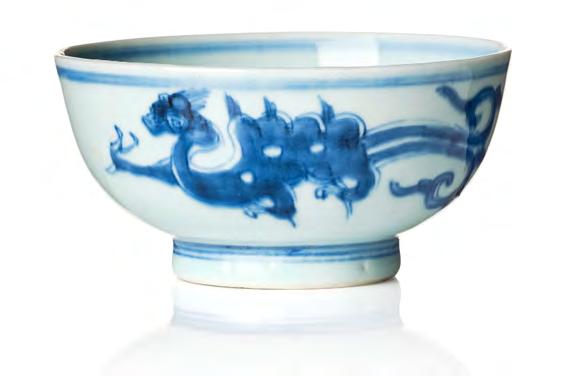
1315. A blue and white censer, Qing dynasty, 18th century.
1314. A blue and white bowl, Qing dynasty, Kangxi (1662–1722). Rounded sides on a short straight foot. Decorated with dragons to the side, a single lingzhi to the interior, the base with daoist symbols. Diameter 12 cm.
Provenance: Property of a private Swedish collector.
Estimate: SEK 4 000 – 6 000 / EUR 350 – 520
Convex shape, decorated with phoenix birds amidst cloud formations. Height 14 cm.
Provenance: Property of a private Swedish collector.
Estimate: SEK 10 000 – 15 000 / EUR 860 – 1 290


1316. A pair of blue and white vases, Qing dynasty, Kangxi (1662–1722).
Octagonal baluster shape, with a waisted neck and a flared rim. Decorated in underglaze blue with panels decorated with elegant ladies in a garden setting. The neck further decorated with antiques and precious objects. Height 29 cm.
Provenance: Property of a private Swedish Estate.
Estimate: SEK 4 000 – 6 000 / EUR 350 – 520
1317. A blue and white bowl, Qing dynasty, Kangxi (1662–1722).
Bell shaped on a tall footrim, decorated in underglaze blue with antiques and precious objects. The base with double fishes within a double underglaze blue circle. Diameter 20.5 cm.
Provenance: Property of a private Swedish collector.
Estimate: SEK 6 000 – 8 000 / EUR 520 – 690


1318. A blue and white dish, Qing dynasty, 18th century. With Chenghua mark to base. Decorated in underglaze blue with Buddhist emblems amidst floral scrolls. Diameter 14 cm.
Provenance: Purchased from Catherine Hunt, England.
Estimate: SEK 15 000 – 20 000 / EUR 1 290 – 1 720
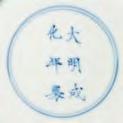

1320. A blue and white charger, Qing dynasty, Kangxi (1662–1722).
Decorated with flowers within panels.
Diameter 39.2 cm.
Literature: Regina Krahl & John Ayers, Chinese Ceramics in the Topkapi Saray Museum, vol III, Compare a dish of this type depicted on page 1029, lot no 2226.
Estimate: SEK 12 000 – 15 000 / EUR 1 030 – 1 290

1319. A blue and white censer, Qing dynasty, Kangxi (1662–1722).
Round on three feet, decorated in underglaze blue with antiques and precious objects. Diameter 25 cm. Height 14 cm.
Provenance: Property of a private Swedish collector.
Estimate: SEK 10 000 – 15 000 / EUR 860 – 1 290

1321. A large blue and white vase, Qing dynasty, Kangxi (1662–1722).
Of baluster shape, decorated in underglaze blue with flowers and potted flowers all divided up in small panels. Height 43.5 cm.
Provenance: Property of a private Swedish Collection.
Estimate: SEK 12 000 – 15 000 / EUR 1 030 – 1 290
1322. A pair of blue and white vases, Qing dynasty, Kangxi (1662–1722).
Of baluster shape, decorated in relief, four panels with peonies, lotus, chrysanthemum and cherry blossom. Height 33.5 cm.
Provenance: Property of a private Swedish collector.
Estimate: SEK 25 000 – 30 000 / EUR 2 140 – 2 570
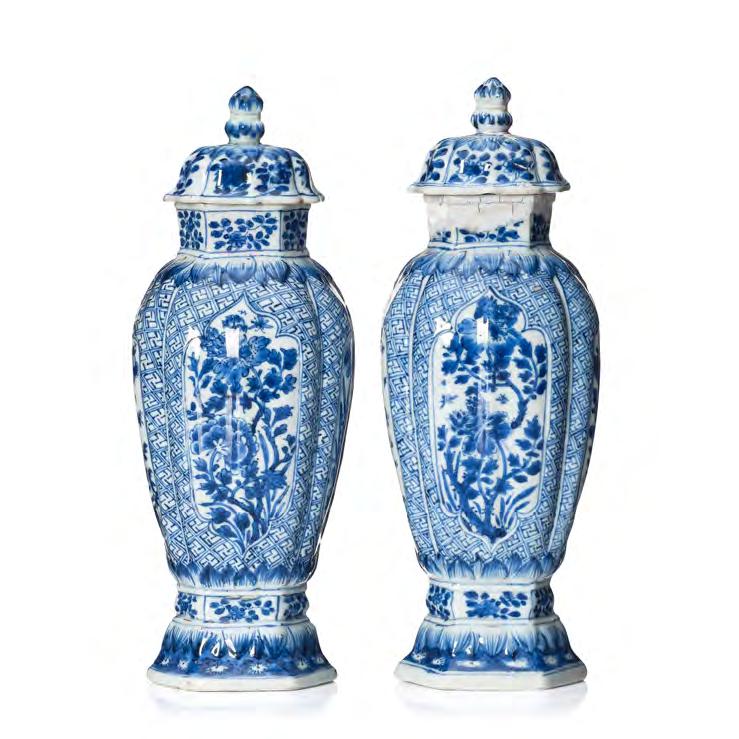

1324. A blue and white bowl, Qing dynasty, 18th century. The interior decorated with a four clawed dragon amidst cloud formations. The exterior with a procession of men carrying gifts towards a city. Diameter 21.4 cm.
Provenance: Property of a private Swedish collector.
Estimate: SEK 4 000 – 6 000 / EUR 350 – 520
1323. A pair of blue and white pots with covers, Qing dynasty, Kangxi (1662–1722).
Octagonal shape, with an upturned spout, decorated with flowers. Height 12 cm.
Estimate: SEK 12 000 – 15 000 / EUR 1 030 – 1 290

1325. A blue and white dish, Qing dynasty, Kangxi (1662–1722).
Decorated in blue and white, garden scenes within reserves.
Diameter 35.5 cm.
Estimate: SEK 6 000 – 8 000 / EUR 520 – 690

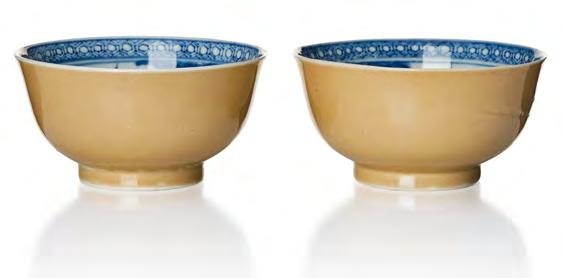
1326. A pair of blue and white bowls. Qing dynasty, 18th century.
Decorated with underglazed blue goldfish to the interior, the exterior with pale cappuciner brown glaze. Height 6.3 cm. Diameter 12.4 cm.
Provenance: Property of a private Swedish collector.
Estimate: SEK 4 000 – 6 000 / EUR 350 – 520
1327. A pair of large blue and white vases with covers, Qing dynasty, Qianlong (1736–95).
Baluster shape, decorated in underglaze blue with a riverscape with a figurescene. Height 62 cm. Height with wooden stands 82 cm.
Provenance: From the Collection of Marianne Posse, thence by descent.
Estimate: SEK 30 000 – 40 000 / EUR 2 570 – 3 430


1328. A blue and white chestnut basket, Qing dynasty, Qianlong (1736–95).
Circular with sculpted handles and pierced sides, decorated in underglaze blue with magnolia in a garden with a scholars rock. Diameter 29 cm.
Provenance: With a label from the Antique Shop of A. B. S. Magaliff, Stockholm.
Estimate: SEK 8 000 – 10 000 / EUR 690 – 860
1329. A pair of blue and white salts. Qing dynasty, 18th century.

After a European silver model in Rococo, standing on three feet, decorated in a vivid underglaze blue colour. Diameter widest part 8 cm. Diameter opening 7 cm.
Estimate: SEK 6 000 – 8 000 / EUR 520 – 690

1330. A set of seven ‘Chinese Export’ butter shells, Qing dynasty, Qianlong (1736–95).
Decorated in underglaze blue with flowers. Length 8.5–10 cm.
Estimate: SEK 4 000 – 6 000 / EUR 350 – 520
1331. A blue and white tureen with cover and stand, Qing dynasty, Qianlong (1736–95).
Oval, lobed, finial in the shape of a peach. Decorated in underglaze blue with a man playing the qin in a pavilion, outside one can see two ladies in conversation. Length tureen 27 cm. Length dish 31.5 cm.
Provenance: From the Collection of Heidi Boyce Broström (1943–2022) and Dan Axel Broström (1915–1976). Dan Axel Broström was the thirdgeneration ship-owner in the prestigious Broström Company group. When he took over the firm in 1949 they had 18 000 employees. The Canadian model and geologist Heidi was Dan-Axel Broströms third wife, the couple lived at the fashionable Särö, a few miles south of Gothenburg.
Estimate: SEK 5 000 – 7 000 / EUR 430 – 600

1332. A pair of blue and white dishes, Qing dynasty, Qianlong (1736–95).
Rounded sides, decorated in underglaze blue with peonies, lotus and willow tree. Diameter 28 cm.
Estimate: SEK 6 000 – 8 000 / EUR 520 – 690
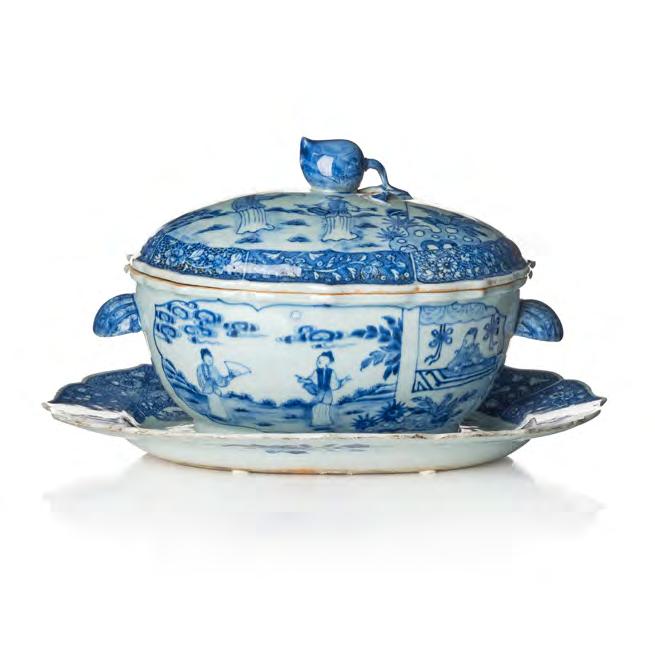
1333. A large blue and white tea caddy, Qing dynasty, Qianlong (1736–95).
Decorated with pagodas in a riverscape. Metal lined rim. Height 33 cm.
Estimate: SEK 6 000 – 8 000 / EUR 520 – 690


1334. A pair of blue and white vases, Qing dynasty, 19th century.
Of baluster shape, decorated with a riverscape with pagodas and figures. Height 32 cm.
Estimate: SEK 4 000 – 6 000 / EUR 350 – 520
1335. A blue and white jar, Qing dynasty, 19th century. With Kangxis four character mark to base. Of baluster shape, decorated in underglaze blue with a figure scene from court life with elegant ladies and a boy. Height 32.5 cm.
Provenance: Property of a private Swedish collector.
Estimate: SEK 5 000 – 7 000 / EUR 430 – 600


1336. A blue and white deep dish, Qing dynasty with a Qianlong seal mark.
Rounded sides, that rests on a short tapering footrim, the interior decorated in underglaze blue with svastika, bats, lotus and symbols. The exterior decorated with four lingzhi fungus. Diameter 20 cm.
Provenance: Property of a private Swedish collection.
Estimate: SEK 6 000 – 8 000 / EUR 520 – 690


1337. A pair of blue and white garden seats, Qing dynasty, 19th century. Of baluster shape with a waisted rim, pierce sides, decorated with a continuous lotus scroll. Height 45 cm. Diameter 31 cm.
Provenance: From the collection of Sven Johnsson who funded AB Jonax, in import firm of textile products and gloves. Mr Johnsson first came to China in the 1950’s and made several journeys to China. He soon started to collect. Mr Johnsson wrote a diary and describes what happened during the cultural revolution, how businessmen were invited to purchase antiques and works of arts from warehouses where they were gathered by the government in rule. He then decided to expand his business to Chinese porcelain and paintings.
Exhibitions: To see other sales from this collector, see Bukowskis, auction, lot no 556, lot no 1531. Bukowskis auction 649, lot no 1305. Bukowskis auction 633, lot no 1045.
Estimate: SEK 12 000 – 15 000 / EUR 1 030 – 1 290

1338. A blue and white ‘eight daoist immortals’ flower pot, Qing dynasty, 19th century.
Of rectangular shape on four feet, decorated in underglaze blue with the eight daoist immortals above fierce waves. Measure 16.5 x 10.5 x 5.5 cm.
Provenance: Property of a private Swedish collector.
Estimate: SEK 4 000 – 6 000 / EUR 350 – 520

1339. A blue and white incense burner, Qing dynasty, 19th century.
Rectangular shape on a baluster body standing stout on four legs, decorated in underglaze blue with a landscape and scholars. Height 22.5 cm. Length 15.5 cm.
Provenance: Property of a private Finnish collection.
Estimate: SEK 8 000 – 10 000 / EUR 690 – 860
1340. A blue and white ink stone, Qing dynasty with Kangxi six character mark.
Rectangular shape, standing on four legs, decorated in underglaze blue with cloud formations. Measure 19.5 x 15.3.5 cm.
Provenance: Property of a private Swedish collector.
Estimate: SEK 20 000 – 25 000 / EUR 1 720 – 2 140



1341. A blue and white jar with cover, Qing dynasty, 19th century.
The base with Kangxi mark. Ovoid shape, decorated with Buddhist lions amidst cloud formations. Height 29 cm.
Estimate: SEK 4 000 – 6 000 / EUR 350 – 520

1342. A large blue and white jar, Qing dynasty, 19th century.
The base with a seal mark in underglaze blue. Ovoid shape with a short straight neck, decorated in underglaze blue with Buddhist lions amidst cloud formations. Height 28 cm.
Provenance: Property of a private Swedish collector.
Estimate: SEK 6 000 – 8 000 / EUR 520 – 690
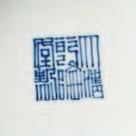

1343. A set of five blue and white jars, Qing dynasty, 19th century.

Round, decorated in underglaze blue with flowers, birds and insects. Height 3.8–12 cm.
Provenance: Property of a private Swedish collection.
Estimate: SEK 4 000 – 6 000 / EUR 350 – 520
1344. A pair of blue and white moon flasks, Qing dynasty, 19th century.
Flattened round shape, on a tall footrim, qilin dragons as handles, decorated with two roundels, one with a bird in a garden in full bloom, the other side with a scholar in a garden with two boys. Height 25.5 cm.
Estimate: SEK 5 000 – 7 000 / EUR 430 – 600


1345. A slip decorated garden seat, late Qing dynasty/20th century.
With pierced cash roundel to the top moulded bands of studs, decorated in low relief in white slip with birds amongst flowering and blossoming branches, and with a panels of qilin dragons.
Height 48 cm.
Exhibitions: Compare, lot 450, 11–12 December, 2012, Live Auction, 2609. Christie’s Interiors.
Estimate: SEK 12 000 – 15 000 / EUR 1 030 – 1 290
1346. A blue and white month cup ‘Narcissus’, late Qing dynasty with Kangxi mark. The cup is thinly potted with deep rounded sides rising to a gently flaring rim. The exterior is finely painted representing the first month with flowering narcissus and a long stem of roses growing beside a scholar’s rock, with another narcissus on the reverse. With calligraphy. Height 5 cm. Diameter 6.5 cm.
Provenance: From a private Swedish Collector.
Literature: Compare with three complete sets of cups for all twelve months with poetic inscriptions, the first is in the Qing Court Collection, illustrated in Blue and White Porcelain with Underglazed Red (III),The Complete Collection of Treasures of the Palace Museum, Hong Kong, 2000, no. 71; the second in the Nanjing Museum, illustrated in Qing Imperial Porcelain of the Kangxi, Yongzheng and Qianlong Reigns, Hong Kong, 1995, pl. 21, the third complete set is illustrated in The Tsui Museum of Art - Chinese Ceramics IV - Qing Dynasty, Hong Kong, 1995, pl. 105B.
Catalogue note: It is rare to find cups emblematic of the twelve months painted in underglaze-blue and without the poems inscription. Comparing to similarly painted ‘month cups’ with inscription, the present cup can be identified as representing the first month with clusters of flowering narcissus.
Estimate: SEK 6 000 – 8 000 / EUR 520 – 690




1347. A blue and white vase, Republic period with Qianlong mark. Of archaistic form, the ovoid body resting on a high splayed foot and rising to a waisted neck, the shoulder applied with a pair of molded elephant-mask handles each suspending a mock ring, the shoulder and body encircled by a register of floral scroll, the lower body wrapped in a band of cloud formations below a band of lappets at the foot, the neck surrounded by stiff upright leaves beneath a band of ruyi at the rim, all finely painted in brilliant tones of underglaze blue with simulated ‘heaping and piling’, the base with a seal mark in underglaze blue. Height 26 cm. Height with wooden stand 29.5 cm.
Provenance: Purchased in Hong Kong, Golden Stone Curio & Art Co, 26, Sea Terminal Bldg. 1 October 1963.
Estimate: SEK 4 000 – 6 000 / EUR 350 – 520

1349. A Japanese blue and white bowl, 18th century. Lotus shaped. Decorated with a Japanese chestnut tree and chestnuts. Diameter 15.5 cm.
1348. A pair of blue and white nine peaches dishes, presumably Republic, with Yongzheng mark.
Decorated in early Ming style in the center with nine peaches borne on gnarled, leafy branches, and the exterior is decorated with three sections of peaches, pomegranate and litchi fruits.
Diameter 18.5 cm.
Provenance: Purchased at Bukowskis, Auction 645, lot no 885.
From the Collection of Art Director Ivar Björnberg (1934–2021).
Estimate: SEK 8 000 – 10 000 / EUR 690 – 860

Provenance: From the Collection of Heidi Boyce Broström (1943–2022) and Dan Axel Broström (1915–1976). Dan Axel Broström was the third-generation ship-owner in the prestigious Broström Company group. When he took over the firm in 1949 they had 18 000 employees. The Canadian model and geologist Heidi was Dan-Axel Broströms third wife, the couple lived at the fashionable Särö, a few miles south of Gothenburg.
Estimate: SEK 2 500 – 3 000 / EUR 220 – 260


1350. A large Japanese Sumidagawa jar with cover, Meiji period (1868–1912).
Mark for Inoue Ryosai (1828–1899) / Inoue Ryosai II (1845–1905). The stout baluster jar profusely decorated with sixteen Rakans with attributes and a tiger, each high-relief figure applied to the partially glazed surface creating an exuberant, richly textured effect, all below the splash-glazed neck. The cover with a finial in the shape of a seated Rakan accompanied by a goat. Sealed Inoue Kyosai on one corner of the surface. Height 50 cm.
Literature: Karp and Pond, 2001, ‘Sumida…according to us’ p. 24, p. 63, p. 68. Catalogue note: Inoue Ryosai II (1845–1905) was the apprentice of Inoue Ryosai (1828–1899), his father in law. Inoue Ryosai II won many awards and was a pioneer in modern Japanese ceramics. He travelled to Europe as a delegate representing Japan at the 1900 Paris Exhibition where he won a gold medal. Inoue Ryosai II had a son, Inoue Ryosai III (1888–1971) who also became a famous potter in Japan.
Estimate: SEK 15 000 – 20 000 / EUR 1 290 – 1 720
1351. A Japanese Satsuma dish, Meiji period (1868–1912).
Signed. Decorated with ‘mille fleur’. Diameter 25.5 cm. In a wooden box. Measure box 34 x 34 x 10 cm.
Estimate: SEK 6 000 – 8 000 / EUR 520 – 690


1352. A Japanese bronze tiger sculpture, Meiji period (1868–1912), signed.
Seated tiger with its head turned and ears back. Signed to the base. Height 21 cm.
Provenance: Property of a private Swedish collector.
Estimate: SEK 15 000 – 20 000 / EUR 1 290 – 1 720
1353. A set of three Japanese gold lacquer inros, 19th century.
One five case inro, decorated with a reclining buffalo to one side, a group of boys to the other side. Height 7.5 cm. With round wooden carved netsuke. Diameter 4.5 cm. A five case inro decorated with a man playing the flute and his attendant. Height 8 cm. Sculptured netsuke in the shape of a man sitting by a pot. Height 3.5 cm. Netsuke with signature. A four case inro decorated with buddai with his sac and an attendant. Height 7 cm. Acorn shaped netsuke in wood. Height 4.2 cm.
Provenance: Private Swedish Collection.
Estimate: SEK 8 000 – 10 000 / EUR 690 – 860


1355. Two Japanese five case lacquered inros, 19th century.
One decorated in relief with a vast landscape with palaces and pagodas. Measure 9 x 5 cm. The other decorated in relief in gold lacquer with birds in a landscape. Measure 10 x 4.5 cm. With netuske with buddai and his sack in wood.
Provenance: Property of a private Swedish collector.
Estimate: SEK 5 000 – 7 000 / EUR 430 – 600

1354. A set of two Japanese inros, Meiji period (1868–1912).
A four case inro decorated with a spider in its web and birds. Height 7 cm. A four case inro decorated in relief and with inlay. Signed. Height 7.5 cm.
Provenance: Property of a private Swedish collector.
Estimate: SEK 5 000 – 7 000 / EUR 430 – 600

1356. A set of two Japanese gold lacquer inros, 19th century.
A six case inro, decorated in relief with different colours of gold with instruments against a background of leaves. Height 9 cm. A five case inro, decorated with a man holding a flower, sitting in a mountainous landscape by a river. Height 8 cm. Signed.
Provenance: Property of a private Swedish collector.
Estimate: SEK 8 000 – 10 000 / EUR 690 – 860

1357. A Japanese gold lacquer five case inro, 19th century. Signed.
Rounded shape, decorated in relief with a shogun and his entourage, above them five cranes. Height 9 cm.
Provenance: Property of a private Swedish collector.
Estimate: SEK 5 000 – 7 000 / EUR 430 – 600
1358. Two Japanese black lacquer three-case inros, Meiji period (1868–1912).
One three case inro decorated with a pine tree in gold, silver against a black ground, the other side with buildings and inlay with mother of pearl. Height 7.2 cm. One three case inro decorated with chrysanthemum in gold, silver and mother of pearl. Height 5.5 cm. Wooden netsuke in the shape of a seated man. Height 3.5 cm.
Provenance: Property of a private Swedish collector.
Estimate: SEK 5 000 – 7 000 / EUR 430 – 600


1359. A set of three Japanese lacquered inros, 19th century.
A four case inro decorated with dragons. Height 7 cm. Signed. A five cased black lacquer inro decorated with a coat of arms. Height 10 cm. A four case inro decorated with a rooster and an hen, signed. Height 7 cm.
Provenance: Property of a private Swedish collector.
Estimate: SEK 5 000 – 7 000 / EUR 430 – 600

1360. A leather clad box with a hardwood and pewter writing set, Japan, Meiji (1868–1912).
Rectangular shape with round lock plates to the front and chrysanthemum shaped ones at the cover. Measure 18.5 x 9.5 x 8 cm.
Provenance: From the private collection of a Swedish family in Närke. The couple has a keen interest in art and antiques and started to collect in the 1960’s, attending auctions, antique shops, and antique fairs. Always seeking additional pieces that would adorn their home and that intrigued them with its quality and history.
Exhibitions: Purchased at an auction in 1983, from the Collection of two Swedish sisters who worked for Mrs Potter Palmer, at Palmer House, Lake Shore Drive, Chicago. The sisters Ellen and Ester Eriksson moved to USA around 1900 and got positions as house keeper and chef at the Potter Palmers, they returned in the 1950’s to their childhood home in Fennerödja and brought with them a many things they had been given during the years in service.
Estimate: SEK 8 000 – 10 000 / EUR 690 – 860
1361. A Japanese cloisonne tray attributed to Namikawa Sosuke, Meiji period (1868–1912).
Decorated with cockerel, hen and chick worked in silver wire, red signature mark to front. The reverse decorated with a yellow moon and green and brown cartouches with stylized leaves to bright blue ground. Signed Seitei and artist seal in red. Measure 29.5 x 29.5cm.

Literature: Compare lot 5304 ‘A Cloisonne Enamel Square Tray, by Kawade Shibataro, Meiji Period’ at Sothebys Baden Baden ‘Die Sammlung der Markgrafen und Grossherzöge von Baden’ 21 October 1995. For a similar example see “The splendors of Imperial Japan, Arts of the Meiji period in the Khalili Collection”.
Estimate: SEK 25 000 – 30 000 / EUR 2 140 – 2 570

Details of lot no 1186 and 1197.
Estimates are given in Swedish kronor (SEK) and € (EUR). Bukowskis general terms and conditions for buyers and sellers, bidding instructions, and special terms and conditions for individual lots can be found at bukowskis.com
Bukowskis Stockholm Arsenalsgatan 2 Box 1754
111 87 Stockholm, Sweden
T +46 8 614 08 00
F +46 8 611 46 74 www.bukowskis.com
All lots with a low estimate value of 15 000 SEK and above in the Art section of Modern Art and Important Winter/Spring’s hammer sales are searched against the Art Loss Register database.

WWW.BUKOWSKIS.COM








 See lot 968, the blue and white vase.
See lot 991, the jun-glazed dish.
Ambassadör Klas E Böök with his family and and Zhou Enlai (1898-1976) Chinese statesman who served as the first Premier of the People’s Republic of China from September 1954 until 1976.
See lot 968, the blue and white vase.
See lot 991, the jun-glazed dish.
Ambassadör Klas E Böök with his family and and Zhou Enlai (1898-1976) Chinese statesman who served as the first Premier of the People’s Republic of China from September 1954 until 1976.

































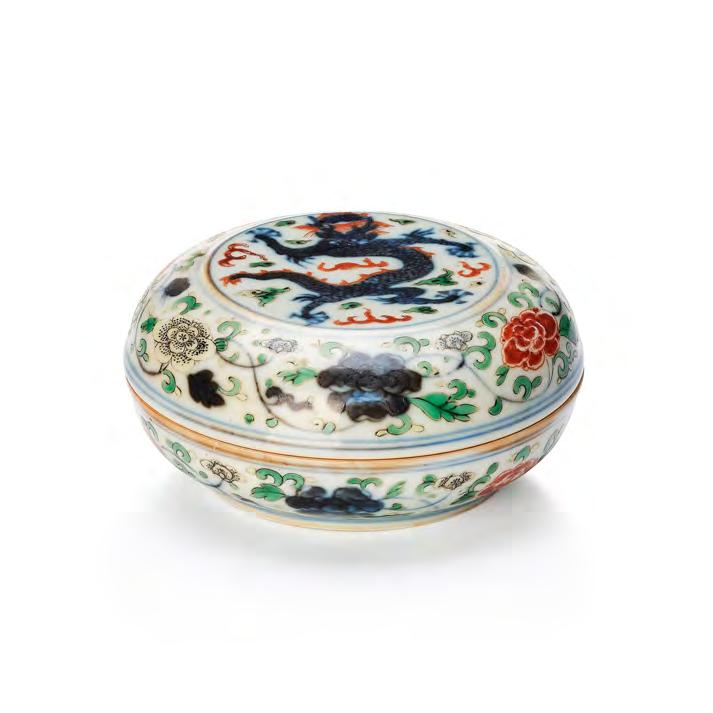






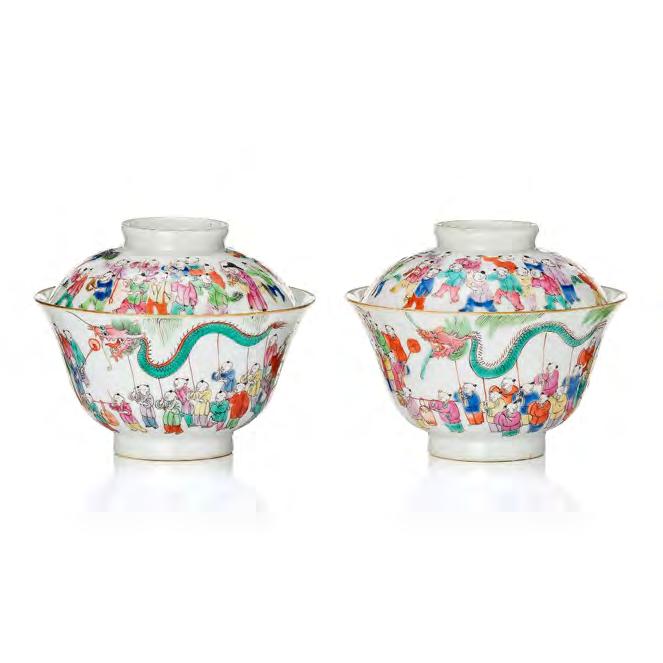

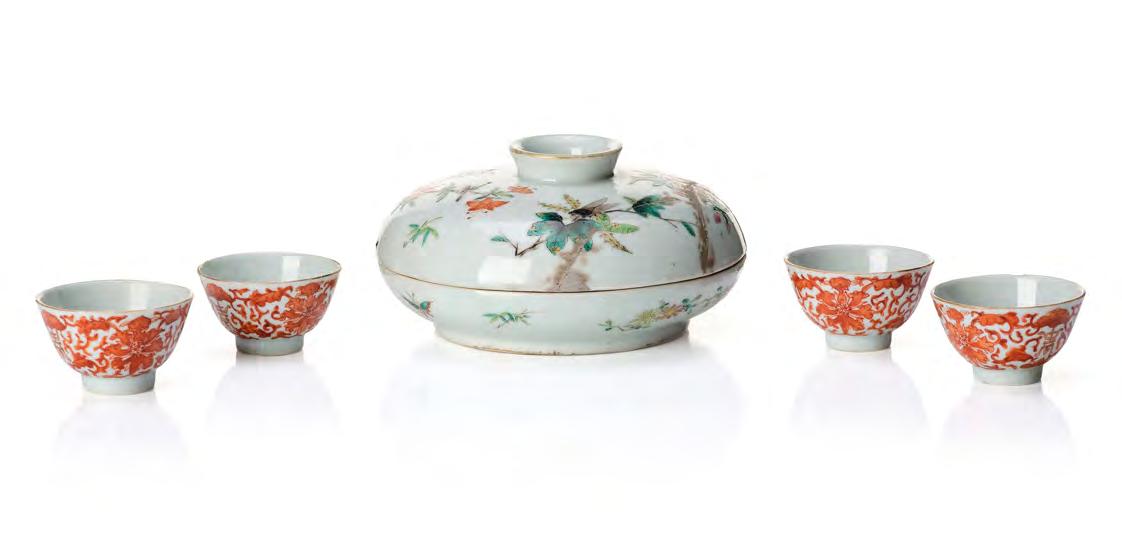












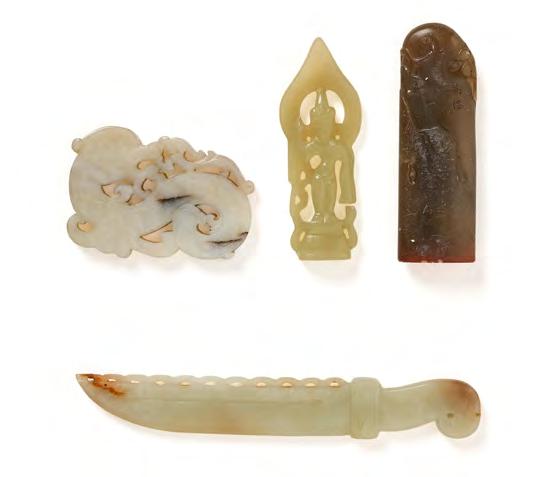


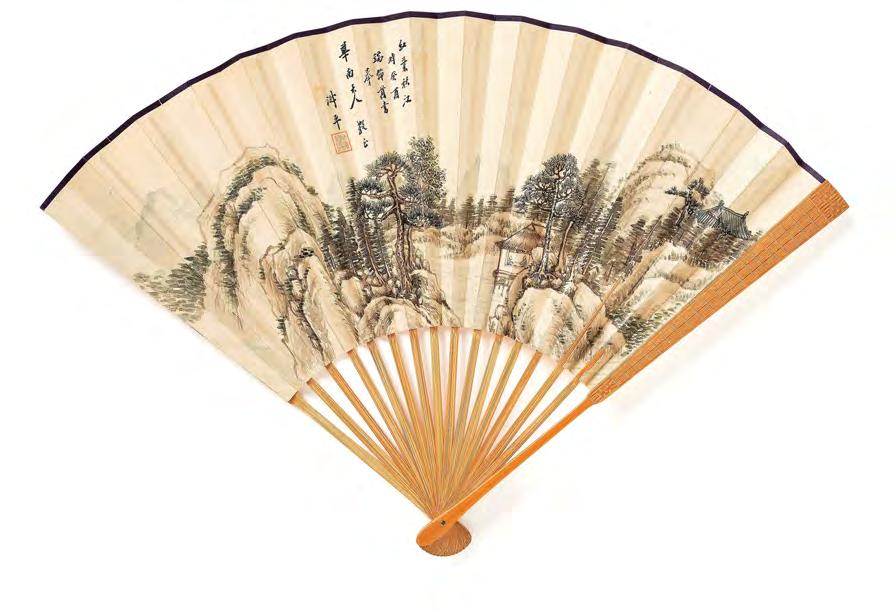
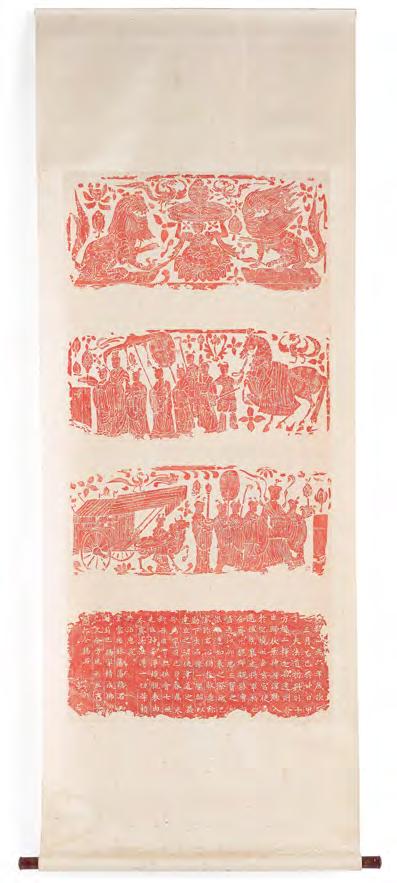
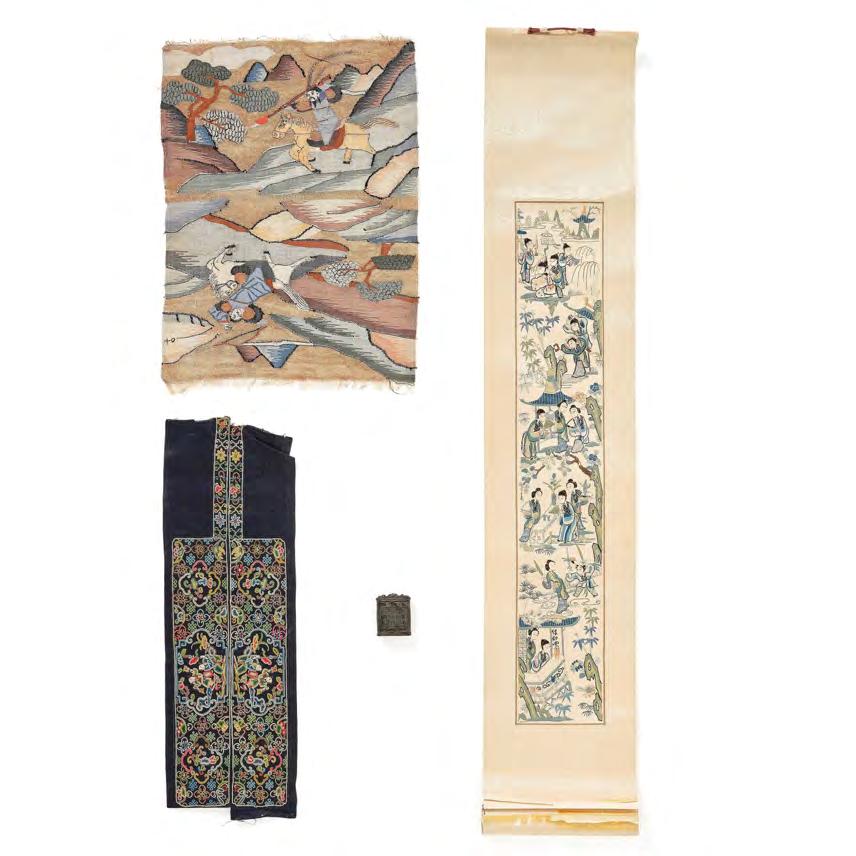





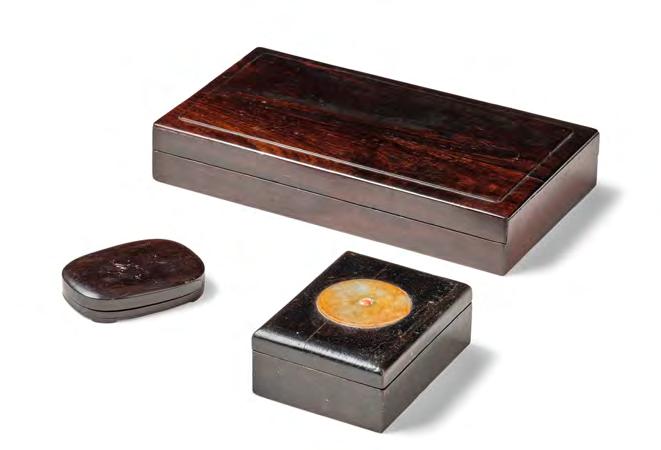
























































 The black and white image taken when Lagrelius visited China with the Crown Prince in 1926. From the top left, no 1 O. Nordqvist, 2, 3, 4 Erik Nyström, 5, 6, 7. From the lower left, no 3 Mr Everlöf, no 4. Crown Princess Louise Mountbatten, no 5. H.R.H. Crown
Prins Gustav Adolf (later King Gustav VI Adolf), no 6 Mrs Rudebäck, no 7 Mr Rudebäck, no 8 Axel Lagrelius, 9 Johan Gunnar Andersson.
The black and white image taken when Lagrelius visited China with the Crown Prince in 1926. From the top left, no 1 O. Nordqvist, 2, 3, 4 Erik Nyström, 5, 6, 7. From the lower left, no 3 Mr Everlöf, no 4. Crown Princess Louise Mountbatten, no 5. H.R.H. Crown
Prins Gustav Adolf (later King Gustav VI Adolf), no 6 Mrs Rudebäck, no 7 Mr Rudebäck, no 8 Axel Lagrelius, 9 Johan Gunnar Andersson.


























































































































































 From the collection of a Korean collector, scientist and a member of the Nobel committee. Thence by descent. Lot no 1178-1185
From the collection of a Korean collector, scientist and a member of the Nobel committee. Thence by descent. Lot no 1178-1185





































































































































































































































